
ConneCting our Community • Spiritofomaha.Com • noV/DeC 2022 reaching NEW HEIGHTS UNMC



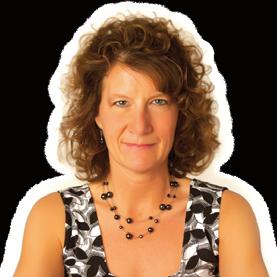
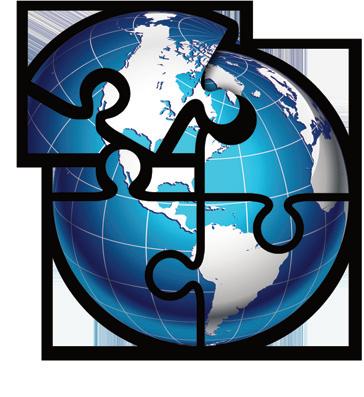
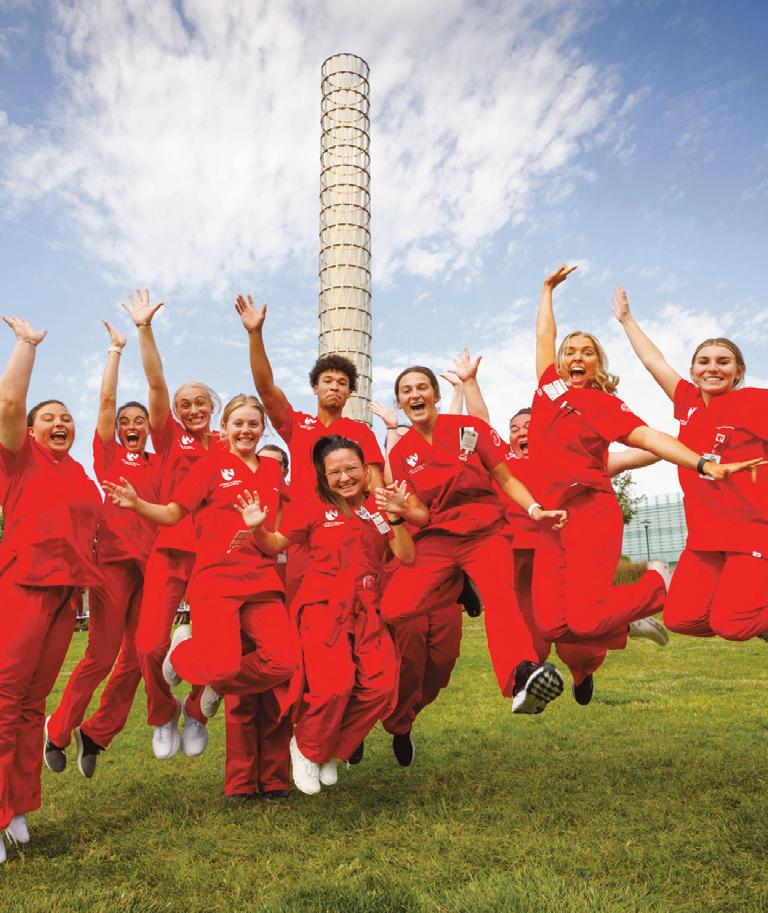

in this ISSUE CONNECTING OUR COMMUNITY mmagazine • nOV/DeC 2022 2 R 6 WOMEN WHO WOW where are they now? 7 UNMC reaching new heights (pp 1-50) 22 SWARTZBAUGH, FARBER & ASSOC. your money 23 metroSPIRIT with mary vandenack 24 VANDENACK WEAVER LLC planning matters 25 STEPHANIE VONDRAK impact! 26 SCENE highlights from recent charity & cultural events departments/columns events cover story featured in this issue 23 connecting to our spirit ConneCting our Community • Spiritofomaha.Com • noV/DeC 2022 reaching NEW HEIGHTS UNMC podcast with ANDEE Hoig Create more in 2021!
s to inform, inspire and connect those who give back to the community through volunteerism and philanthropy, recognizing the ongoing efforts of area businesses, organizations and individuals who better our community.
Contents of this magazine are copyrighted by alh Publications, inc. in their entirety. no part of this publication may be reproduced, stored, or transmitted in any form or by any means - electronic, mechanical, photocopying, recording or otherw se - without prior written consent of the publisher. ©Copyright 1990 2022 alh Publications, inc. all rights reserved.

Publisher/Editor-in-Chief andrea l. “anDee” hoig Editor/Creative Director rob Killmer Community Engagement COnneCt@SpiritofOmaha.com Special Thanks Printco graphics Creative Collaboration elissa Joy Jim Scholz Kara Schweiss Swartzbaugh-Farber & associates Stephanie Vondrak D.D.S. Vandenack | weaver | truhlsen m metromagazine 2022 eDitiOn • VOl. 34 nO. 6 Press releases and other editorial information may be sent to: P.O. bOx 241611, Omaha, ne 68124 or e mailed to: editor@Sp ritofOmaha.com CreDitS “We
individuals that
metroMAGAZINE
partner with us... 402.932.3522 • CONNECT@SpiritofOmaha.com ~ NATE DODGE PreSiDent, nP DODge COmPany MAKE THE CONNECTION! metromagazine is wholly owned and operated by the publisher and is not affiliated with any other publication, operating solely on subscription and advertising revenues and the good will of the agencies and charities we support; all of which are very important to the continuing growth and quality of this publication. thank you to all who support this endeavor. OFFICE/SALES 402.932.3522 | sales@SpiritofOmaha.com
alh Publications exist
have generations of
have passion, and generations that have need. When those two meet, great
relationships occur.
and The Giving Guide & Event Book consistently help connect and foster those relationships.”
MISSION STATEMENT
mmagazine • nOV/DeC 2022 3

WHAT ELSE IS possible?
We are heading into one of my favorite times of the year, the holiday season. There are so many reasons why I love this time of year. For me there has always been a magical energy that shows up and invites me to so much more: more joy, more allowance of others, more contribution and more gratitude. Although the holidays may be stressful, for me there is also a generosity of spirit in the air. Generosity and gratitude create MAGIC.
Grateful for our Community: As publisher and CEO of both metroMAGAZINE and Midlands Business Journal, I do what I do in this community because it brings me joy. I get excited, my adrenaline starts pumping, and my creative juices are flowing when I am presented with a new project, an inspiring story, a game-changing idea or message that needs to be told—something or someone making a difference.
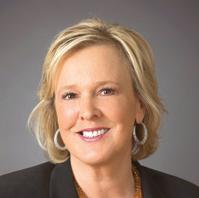
In this issue my team and I have appreciated the opportunity to work alongside UNMC team members to bring you an extraordinary understanding of UNMC’s impact on our commuhity. There are many people who were instrumental in making this issue happen and I THANK YOU! As I said earlier, I oftentimes have no words when I look at the amazing talent, the commitment, the innovation and the generosity of spirit that we have in our community.
I encourage all of you to grab a cup of coffee, a glass of sparkling water or whatever your favorite beverage may be, and pour through this 50-page special edition focus section.
From the visionaries in UNMC’s leadership to the researchers, doctors, nurses, medical staffers and students—everyone involved in this institutional system gives us reason to applaud their efforts and execution. Again, we are grateful to have had the opportunity to conduct this research and share this information with you.
What Else is Possible? It’s easy to get consumed by the “wrongs” of society and the “negative” happenings and information swirling around us 24/7/365, but as I have said before, to create the best of anything, ask this question:

- What Else is Possible that we haven’t considered before?
- What Else is Possible that hasn’t been created before?
- What Else is Possible that I could contribute that will inspire others?

- What Else is Possible by coming together with an open mind, desire to make a difference and a spirit of generosity?
Truly—What Else is Possible…NOW?

Grateful for all of you!
L. HOig • maha.com

words FROM MY HEART mmagazine • Letter frOm tHe pubLiSHer
mmagazine • nOV/DeC 2022 5
podcast with ANDEE Hoig CONNECTING OUR COMMUNITY What else is possible in 2023?
anDrea

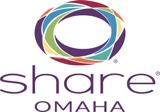






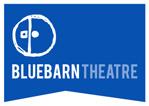

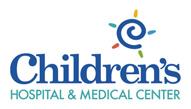








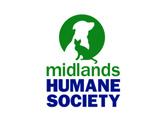

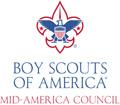





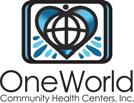




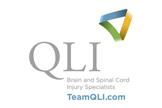








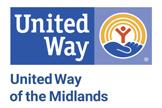


Y OU’RE IN GOOD COMPANY THANK YOU TO ALL OF OUR PARTICIPATING NONPROFITS IN THE 2023 EDITION OF The Giving Guide & Event Book SPECIAL THANKS TO:
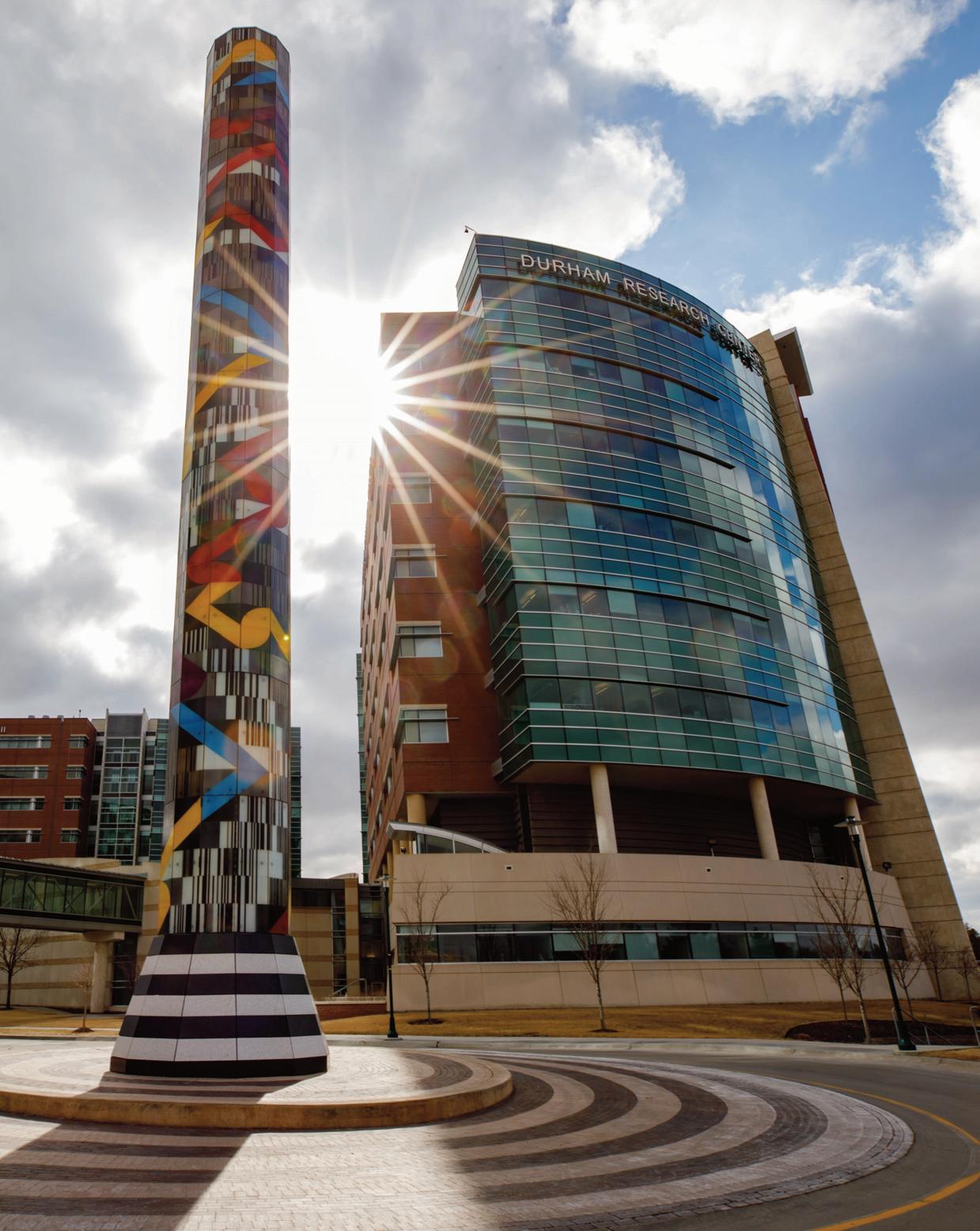

your enterprise yOur message
INNOVATION • LEADERSHIP mmagazine • nOV/DeC 2022 1
UNMC
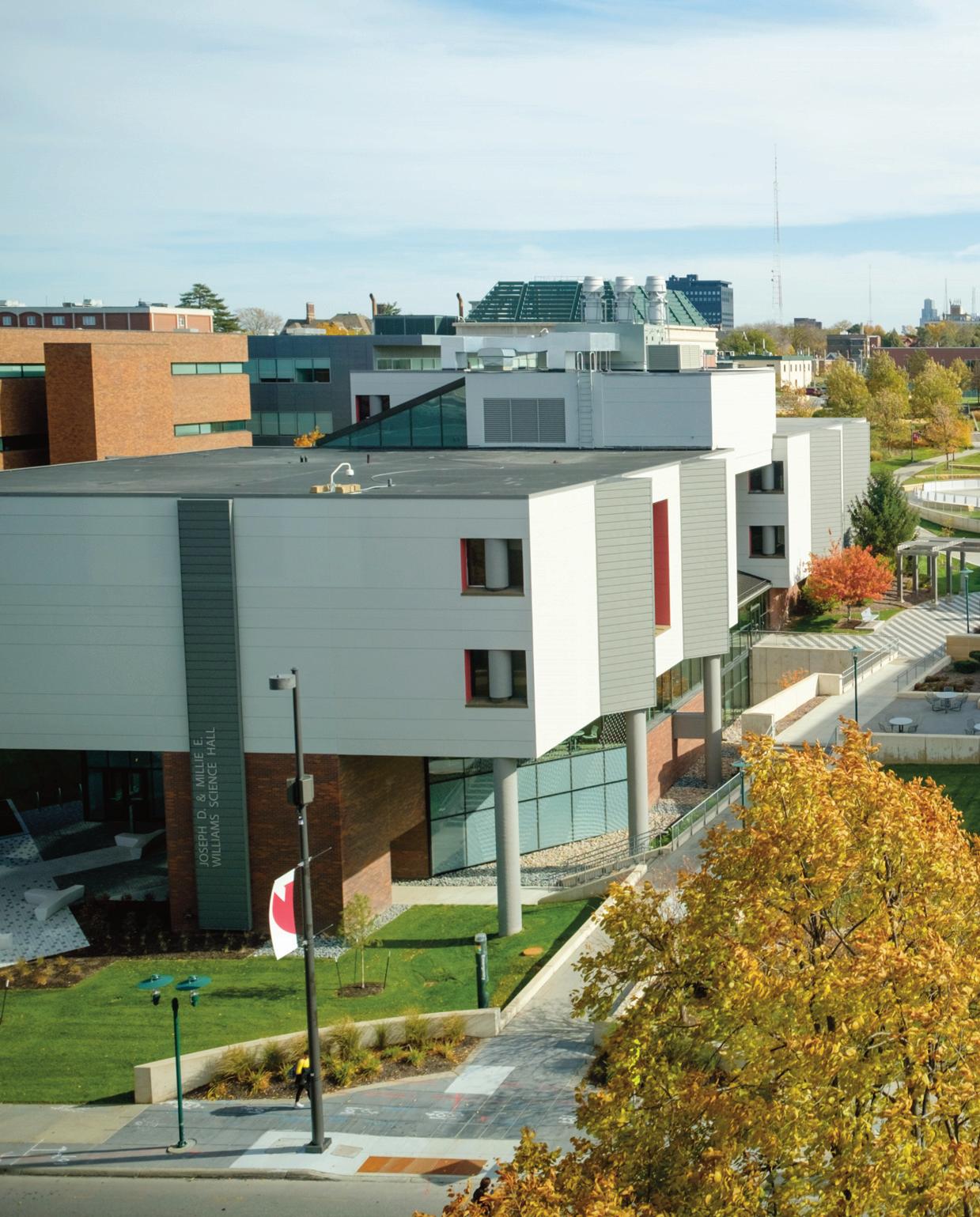


UNIVERSITY OF NEBRASKA MEDICAL CENTER innovation mmagazine • nOV/DeC 2022 speCial eDitiOn 2
UNMC is reaching new heights to strengthen Nebraska communities, address workforce challenges and respond to global emergencies.
Using creativity, technology and innovation, UNMC also trains more health professionals than any other institution in Nebraska.

and leadership
CONTINUED
unmc innOVatiOn & leaDership • mmagazine
stOry by KARA SCHWEISS • phOtOs COurtesy Of UNMC
education and research THROUGH TECHNOLOGY


UNMC’s iEXCEL program provides risk-free training environments that enable learners to practice skills time and again before moving on to a real patient.

UNIVERSITY OF NEBRASKA MEDICAL CENTER
unmc leads in providing TRANSFORMATIVE MODELS mmagazine • nOV/DeC 2022 4 speCial eDitiOn
IMAGINE A MEDICAL STUDENT LEARNING ABOUT THE HUMAN HEART—BY TAKING IT APART AND EXAMINING EVERY FACET OF THE ORGAN VIRTUALLY.
IMAGINE A SURGICAL TEAM PRACTICING A NEW TECHNIQUE—RISK-FREE IN A REALISTIC SURGICAL SETTING ON AN INTERACTIVE MANIKIN.
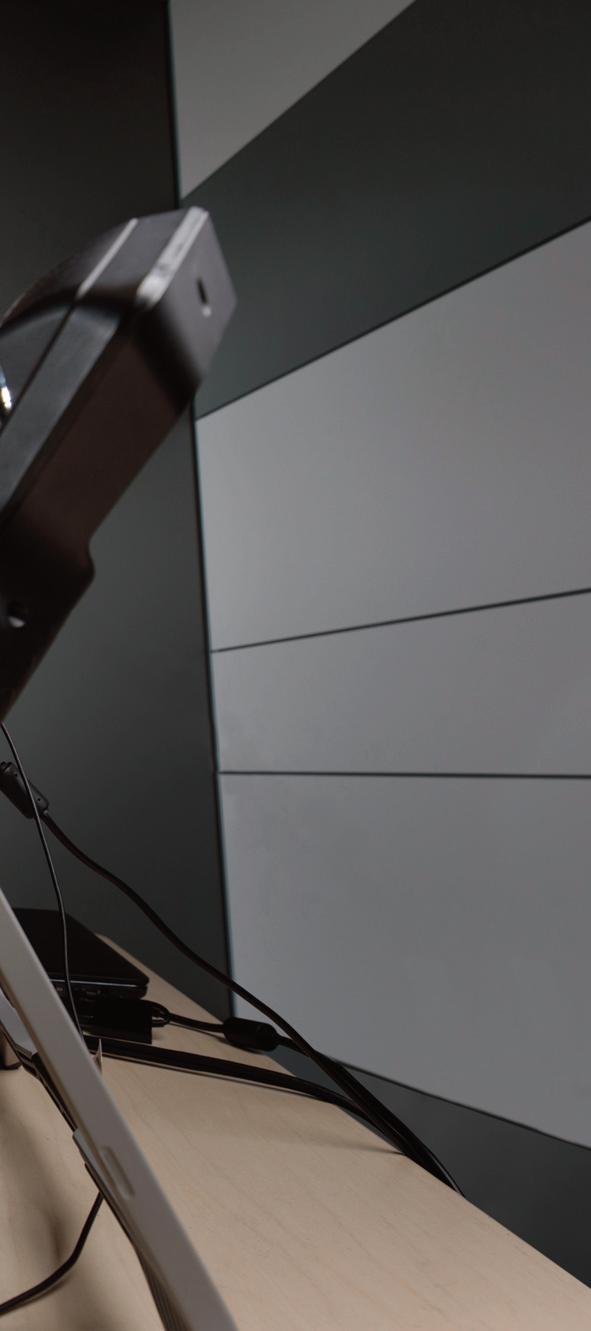
IMAGINE A CARE TEAM LEARNING TO TRANSFER A MEDICALLY FRAGILE PATIENT FROM AN AMBULANCE TO A HOSPITAL ROOM—IN LIFELIKE ENVIRONMENTS USING A PATIENT SIMULATOR THAT CAN REACT TO THE TEAM’S ACTIONS AND EXPRESS EMOTION.
All of this is possible with the iEXCEL program, a transformative model for health care education headquartered in UNMC’s Dr. Edwin G. & Dorothy Balbach Davis Global Center, a revolutionary clinical simulation facility. The 192,000-square-foot Davis Global Center is also a pioneering research venue where academic, government and industry partnerships improve training outcomes through the testing of new processes, products and experiential education opportunities.
The iEXCEL visualization team is comprised of expert designers, artists and animators who produce highly accurate 3D medical content for the virtual and augmented reality worlds. This multidisciplinary team collaborates with simulation technicians and subject-matter experts to create unique educational experiences utilizing state-of-the-art technologies within the Davis Global Center and beyond.
“The Davis Global Center is the home of the iEXCEL program, which stands for ‘Interprofessional Experiential Center for Enduring Learning.’ It is focused very specifically on improving human performance through the use of advanced technology and advanced simulation,” said Jeffrey P. Gold, M.D., chancellor of UNMC. “The concept is pretty simple: improve performance in the clinical environment— meaning in the operating theater, in the emergency department, at the bedside, in the clinic—which is a combination of technology, and even more importantly, the proficiencies, the expertise and the experiences of the health care professionals who interact directly with patients and who also work with students and conduct clinical research.”
STUDENTS ARE IN AWE OF THE IEXCEL VISUALIZATION HUB AT UNMC. INTERACTIVE DIGITAL IWALLS CONNECT UNMC’S NURSING DIVISIONS IN OMAHA, SCOTTSBLUFF, KEARNEY, LINCOLN AND NORFOLK.

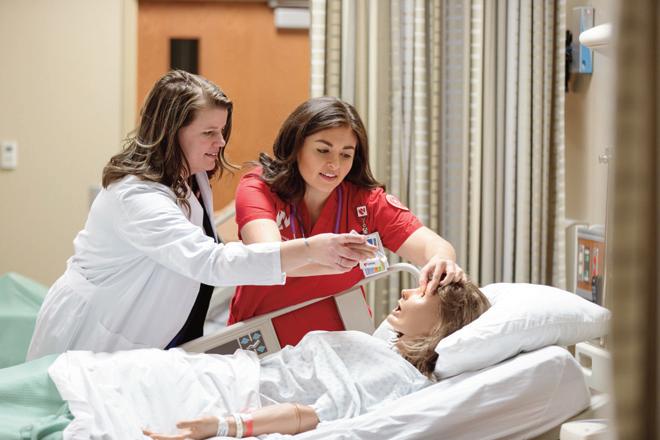
STUDENTS IN THE UNMC COLLEGE OF NURSING NORTHERN DIVISION MASTER CLINICAL SKILLS IN SAFE SIMULATED ENVIRONMENTS USING HIGH-FIDELITY MANIKINS.
AT THE beginning... main story content
FOR HEALTH CARE education
• mmagazine stOry by KARA
• phOtOs prOViDeD COurtesy Of UNMC CONTINUED unmc innOVatiOn & leaDership
SCHWEISS
UNIVERSITY OF NEBRASKA MEDICAL CENTER
unmc leads in providing…
education and research THROUGH TECHNOLOGY
Gold added that, to his knowledge, no other medical center in the U.S. offers anything like iEXCEL, “which allows us to be a true leader in this area. Indeed, in many ways we are the envy of almost every other academic teaching center in the health professions across the country.”
“It’s a whole new dimension to simulation in health care,” said Pamela Boyers, Ph.D., associate vice chancellor of clinical simulation for iEXCEL. “It provides new and exciting ways to learn.”
iEXCEL has been well-received at UNMC since the Davis Global Center opened in late 2019.
“I’ve enjoyed working with the iEXCEL team to develop cutting-edge 3D visualizations of the nervous system. Understanding complex neuroanatomical structures will be much easier for students using the resources of the Davis Global Center. From holographic presentations to interactive wall screens, the DGC allows us to take digital learning to the next level,” said Rob Norgren, Ph.D., professor in the Department of Genetics, Cell Biology & Anatomy. “The neuroanatomy portion of the neuroscience block was held in the DGC for the first time last April. In addition to digital resources, we will use the skills labs at the DGC for exploring brain anatomy with the medical students. I’m excited to take advantage of the resources at the DGC and to develop groundbreaking new content.”
Realistic scenarios
Simulation provides risk-free training environments, enabling learners to practice skills and achieve acceptable levels of competency before moving on to real patient situations, Boyers said.
“Fundamentally, simulation in health care is all about constantly improving the way we provide care in a clinical setting to patients, whether it’s how we communicate, how we do procedures, or how we work as teams,” she explained. “The wonderful thing about simulation in health care now—and especially with the addition of 3D and virtual reality—is that we’re able to create a lot of very realistic scenarios using simulation. People can learn, practice and reach levels of proficiency using simulation models or human patient simulators; interviewing ‘standardized patients,’ patient actors; or in our case, we’ve also added visualization with emerging media platforms such as 3D, virtual reality and augmented reality, or even holographic technology.”
Simulation is not only effective for students, but it’s also useful for medical practitioners learning new procedures or techniques or practicing for various scenarios.
“Simulation allows you to do that in a very safe environment where you can learn and become competent before you ever treat a patient,” said Dele Davies, M.D., senior vice chancellor for academic affairs. “It’s something that increases your confidence level thousandfold and allows you to be able to make sure you’re competent as a clinician. So, when you see the patient, you don’t have that risk of thinking that you might make a mistake or something may go wrong. It won’t preclude things going wrong, but you will know exactly how to handle them.”
“The Davis Global Center provides a stress-free training environment,” Boyers said. “You can also take the time to learn at your own pace.”
Gold said simulation can even prepare medical teams for potentially catastrophic situations, new techniques and open-ended emergency scenarios. In the simulation suites, cameras capture learners’ actions for later review such as guided self-assessment with an experienced clinician or faculty member.
“When you’re learning in a simulated environment, we encourage people to make mistakes, to experiment and see what happens. We have surgeons who practice surgical procedures before they go to the operating room or cath lab or the endo suite. Why? Because there may be four or five or ten different ways to do it,” he explained. “If you have a chance to do procedures in a virtual environment before you ever go into the operating theater, the patient benefits from that, the surgical team benefits from that, and of course society benefits from shorter hospitalization stays, higher efficiency and more capacity. It’s a win-win-win.”
An exceptional tool
Simulation technology isn’t a new concept, but iEXCEL takes it to a new level, Boyers said. Human patient simulators can be programmed with specific ailments, complications or even unexpected elements, such as a labor and delivery model that can deliver twins. Another example is highly detailed three-dimensional imagery that provides an unprecedented view into the human body and its various organs.
“In order to be effective, simulation has to be realistic,” Boyers said. “It’s a safe place to learn and practice but it can also be a place to innovate; to try new ways of teaching, learning and providing care. Training is our highest priority.
CAPTIONS PROVIDED BY PARTNER/SOURCE (25 WORDS MAXIMUM)
mmagazine • nOV/DeC 2022 6
speCial eDitiOn
…education and research THROUGH TECHNOLOGY

COntinueD • mmagazine
CONTINUED unmc innOVatiOn & leaDership ~
HOME TO THE WORLD’S FIRST HOLOGRAPHIC THEATER IN ACADEMIA, IEXCEL BRINGS LEARNING TO LIFE BY SHOWCASING 3D MEDICAL CONTENT.
pAMElA boyERS, pH.d., assOCiate ViCe ChanCellOr Of CliniCal simulatiOn THE wonderful THINg AboUT simulation IN HEAlTH CARE NoW—ANd ESpECIAlly WITH THE AddITIoN of 3d ANd virtual reality—IS THAT WE’RE AblE To create A loT of vERy REAlISTIC scenarios USINg SIMUlATIoN.
education and research
But we’re also an innovation hub; the center is also designed for research and development that will continue to transform health care for years to come.”
Students still learn through traditional means such as reading and lecture, but simulation creates an opportunity to explore, experience and meet the expectations of the next generation of digital learners, she added.
“The Davis Global Center houses the whole simulated health care system. It has a home unit because so much care is given in the home these days, it has an ambulance bay with an ambulance, patient hospital rooms, an ICU to simulate an intensive care unit, a simulated pediatric unit, and a simulated OR. You can transfer the patient throughout all levels of health care and back home again; it has an emergency department and trauma suite,” Davies said. “It includes almost any patient-care skills you need to learn, including the transfer of patients from one level to the next, which is when patients are the most vulnerable.”
iEXCEL even played a role during the COVID-19 pandemic, Gold said.
“It allowed our students to continue their clinical journey through simulation. It reinforced how vitally important simulation is to all clinical education,” he said.

iEXCEL is an exceptional tool for team learning, Davies said, pointing out that the “i” in iEXCEL stands for “interprofessional.”
“We already signal in the name how we believe that we want different health professions coming together to work, not just one particular specialty. We have nurses working with doctors working with physical therapists working with pharmacists—simulating how you work together in real life,” he said. “The whole point of iEXCEL is to build collaboration. We’ve been very intentional in doing that.”
UNIVERSITY OF NEBRASKA MEDICAL CENTER
IN
RURAL
HEALTH
THE STATE. mmagazine • nOV/DeC 2022 8
UNMC’S SIM-NE (SIMULATION
MOTION-NEBRASKA) PROGRAM BRINGS CRITICAL TRAINING TO
EMERGENCY MEDICAL SERVICE PROVIDERS AND
PROFESSIONALS ACROSS
THROUGH TECHNOLOGY
THE dAvIS globAl CENTER HoUSES THE whole simulated HEAlTH CARE SySTEM.…IT INClUdES AlMoST any pATIENT-CARE SKIllS yoU need To lEARN. speCial eDitiOn
~ dElE dAvIES, M.d., seniOr ViCe ChanCellOr fOr aCaDemiC affairs
~ pAMElA boyERS, pH.d., assOCiate ViCe ChanCellOr Of CliniCal simulatiOn
SIM-NE PROVIDES VALUABLE TRAINING ACROSS THE STATE
Last November, in a holiday-movie-miracle coincidence, Hildreth Fire and Rescue delivered a baby in an ambulance—less than 48 hours after receiving specialized, high-tech training on emergency obstetrics from UNMC’s Simulation in Motion-Nebraska (SIM-NE).
Baby boy Raiden came into the world not in a hospital bed, but on a country road at mile marker 32.
“My jaw is still on the floor when I think about it,” said Hildreth Fire and Rescue EMT Elizabeth Burki, who helped deliver Raiden.. “It makes me teary-eyed.”
It’s not a scenario rural EMTs, often volunteers, see every day. Or for decades.
But SIM-NE, a statewide mobile education system, provides state-of-theart, hands-on training to better prepare emergency medical service providers in rural areas across the state, including health professionals in hospitals. The UNMC program provides free or low-cost training using four 44-foot, customized trucks that supply mobile, real-life experiences to enhance lifesaving skills in rural areas.
“Thank God for the training,” Burki said.

SIM-NE’s fleet, launched in June 2017, is stationed in Scottsbluff, Norfolk, Kearney and Omaha. Rather than having learners in greater Nebraska travel to larger cities, the trainers go to them. This allows training to be team-based, as learners train side by side with the people they normally work with during an emergency response.
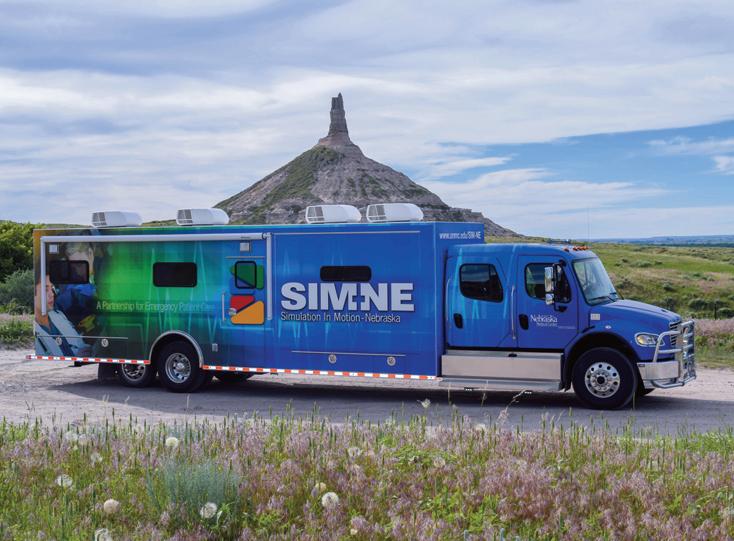
The program has trained in 89 of the 93 counties in Nebraska, and, earlier this year, celebrated its 500th onsite training session.
That team focus distinguishes iEXCEL from simulation programs at other teaching hospitals, Boyers said.
“If you have excellent health care, it’s tied to effective health care teams,” she explained.
“If you can start that earlier in training and practice as teams, it will have an impact on patient safety outcomes. Patient safety is at the heart of everything we do.”
The iEXCEL program allows for virtual collaboration as well, Boyers added, thanks to software that brings together learners across the state for discussion, engagement and problem-solving.
“We’re using something we’re calling ‘interactive digital walls’; they’re like giant (tablets) where you can get teams of students or learners up all at one time interacting, you can pull up any information you want, and you can use them for planning,” she said.
There’s even a mobile component called Simulation in Motion-Nebraska (SIM-NE). It’s all part of UNMC’s mission to serve the entire state.
“There was a great deal of mindfulness and instructions that whatever we do should benefit the whole state,” Boyers said. “We take that statewide mission very seriously.”
mmagazine • nOV/DeC 2022 9
CONTINUED
USING FOUR, 44-FOOT-LONG CUSTOMIZED TRUCKS, THE SIM-NE TEAM HAS PROVIDED TRAINING IN NEARLY EVERY NEBRASKA COUNTY.
COntinueD • mmagazine unmc innOVatiOn & leaDership
pATIENT safety IS AT THE heart of everything WE do.
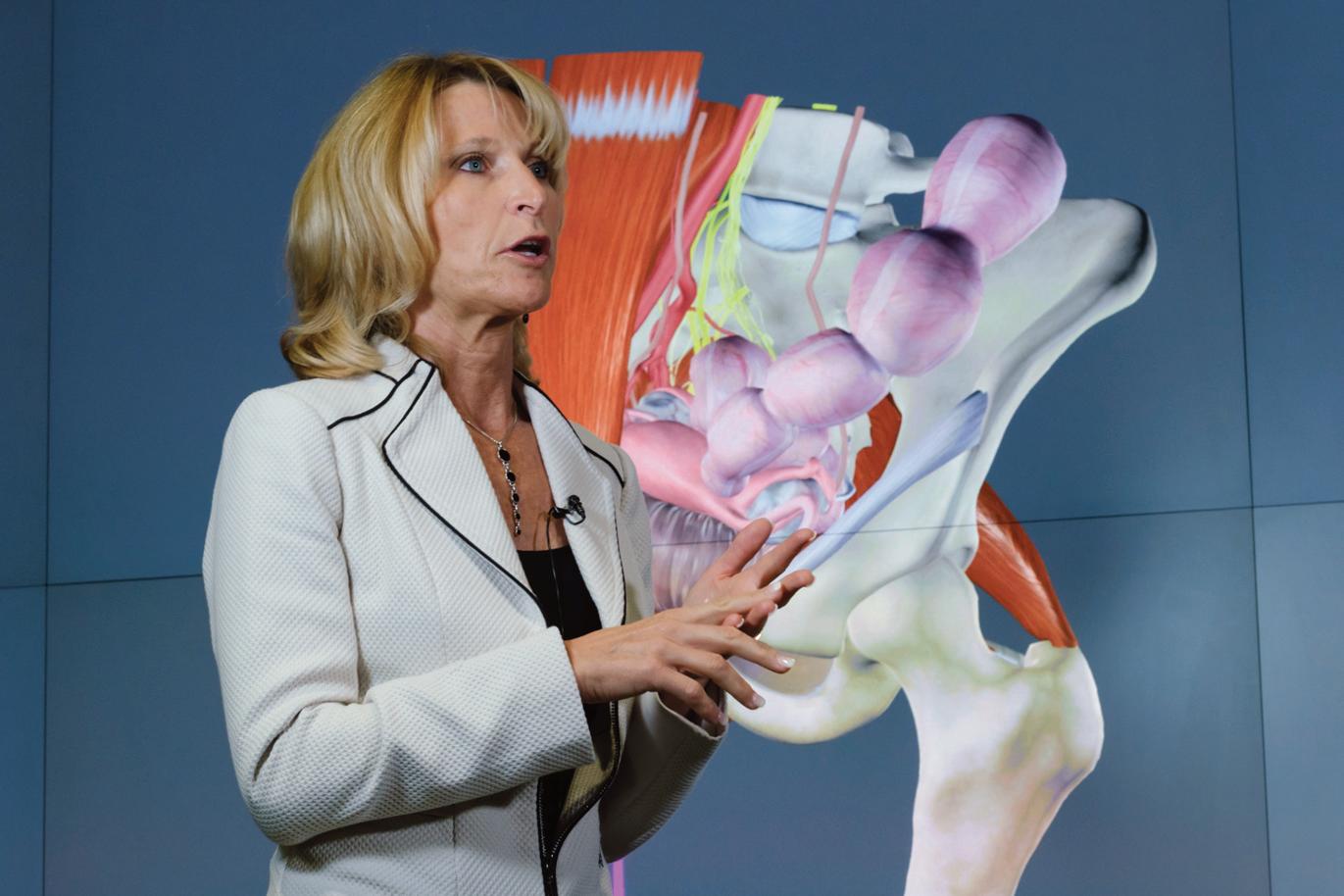
CONTINUED mmagazine • nOV/DeC 2022 10 COntinueD • mmagazine
UNMC’S JENNIFER CERA, DNP, USES A 3D MODEL OF THE MUSCULOSKELETAL SYSTEM OF THE FEMALE PELVIS AS AN INTERACTIVE TEACHING MODEL.
~ pAMElA boyERS, pH.d., assOCiate ViCe ChanCellOr Of CliniCal simulatiOn
If yoU HAvE excellent HEAlTH CARE, IT’S TIEd
To effective HEAlTH CARE teams. If yoU CAN START THAT EARlIER IN training…IT WIll HAvE AN impact oN pATIENT SAfETy outcomes.
speCial eDitiOn
UNIVERSITY OF NEBRASKA MEDICAL CENTER IN NEXT SECTION: workforce development and training
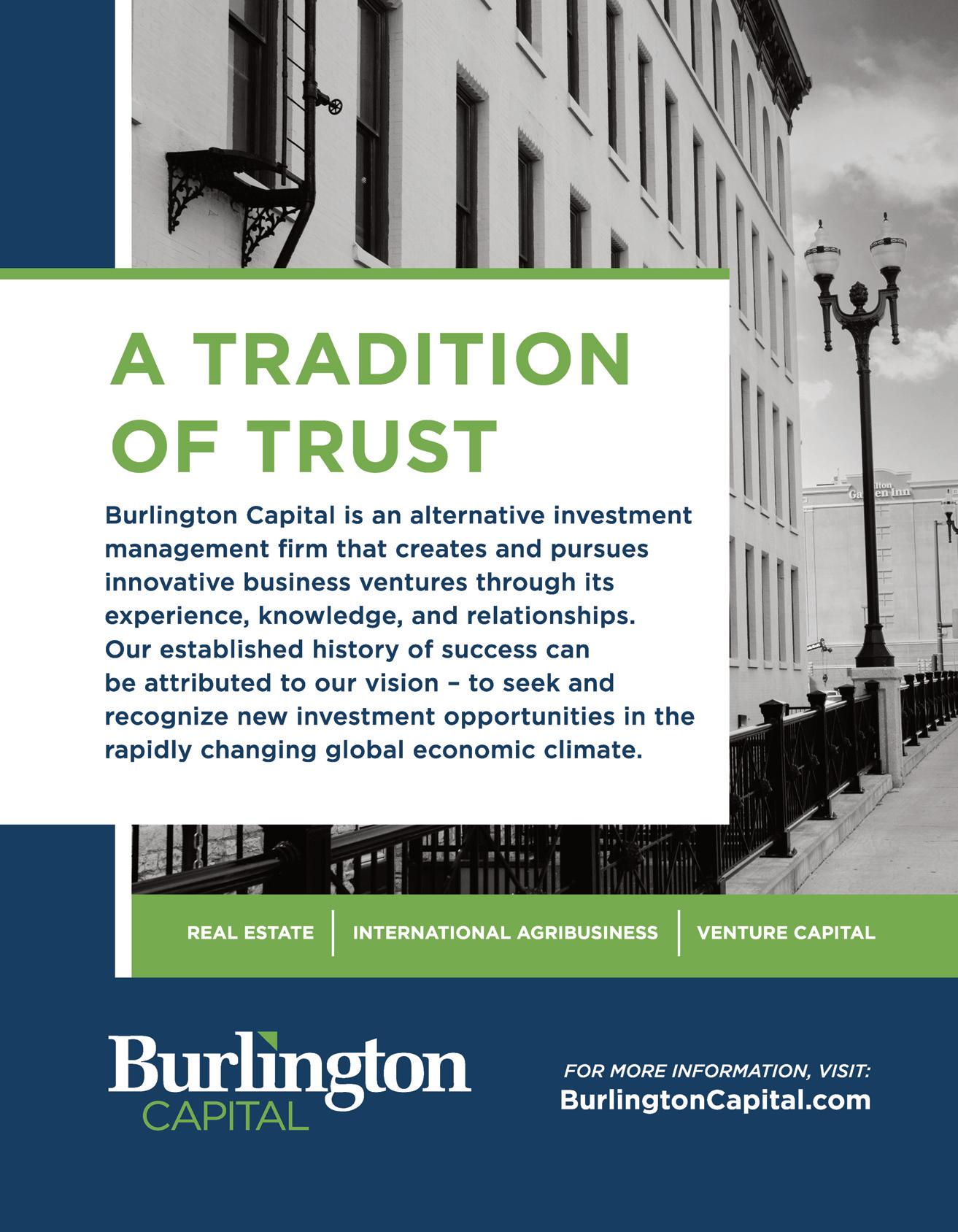
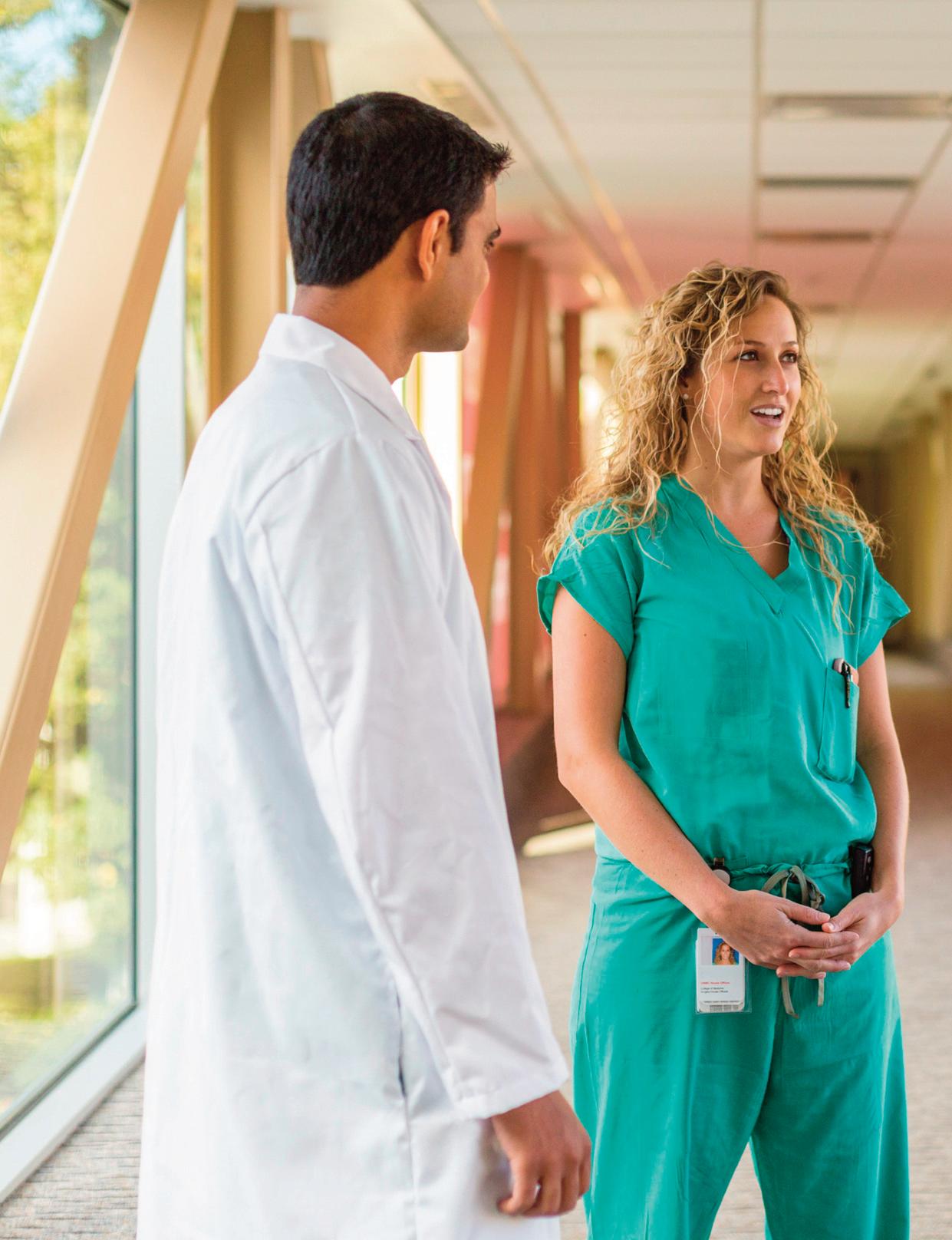


UNIVERSITY OF NEBRASKA MEDICAL CENTER workforce mmagazine • nOV/DeC 2022 12 speCial eDitiOn
UNMC’s innovative programs and rural health initiatives help communities across the state address workforce shortages.
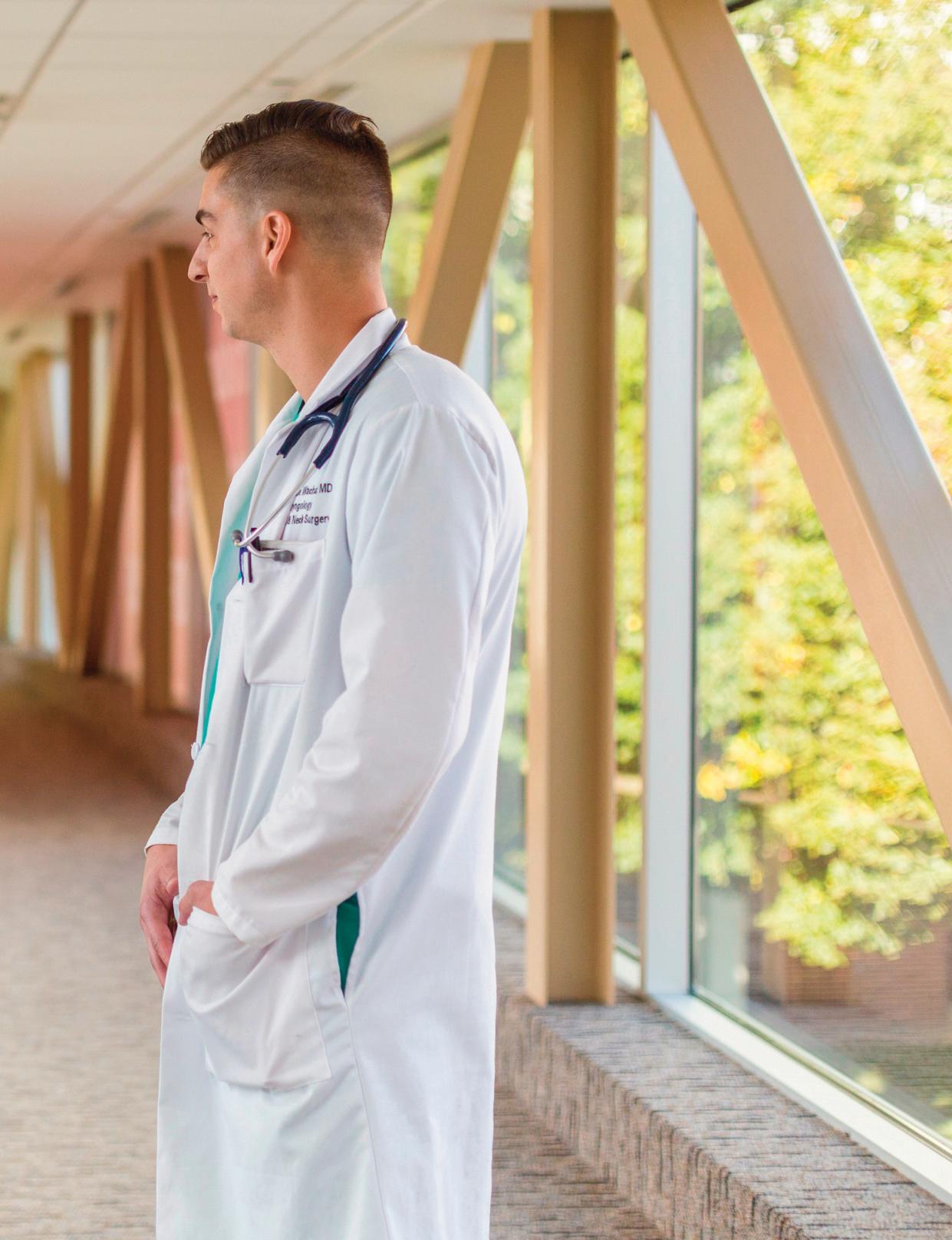
development
AND TRAINING
CONTINUED
unmc innOVatiOn & leaDership • mmagazine
workforce development AND TRAINING

IN A TIME WHEN ORGANIZATIONS IN MANY SECTORS ARE STRUGGLING TO FILL POSITIONS AND KEEP OPERATIONS GOING STRONG, HEALTH CARE IS NO EXCEPTION. HOWEVER, MEETING THE NEEDS OF UNDERSERVED COMMUNITIES ACROSS THE STATE IS A LONGSTANDING CHALLENGE THAT UNMC IS FINDING INNOVATIVE WAYS TO ADDRESS.
Marty Fattig, CEO of Nemaha County Hospital in Auburn, said rural hospitals are facing a dearth of qualified workers in nearly every discipline.
“Today we are extremely short of nurses, imaging technicians, laboratory professionals, respiratory therapists and paramedics. These shortages impact us in many ways,” he said.
“First of all, the existing staff members are becoming fatigued to the point of burnout. They are working more than full time and cannot take time off without leaving their fellow workers short-handed.”

The worker shortage in health care extends even beyond hospital walls, Fattig added.
“The lack of emergency medical service workers makes it difficult to staff ambulances for 911 calls and to transport patients needing a higher level of care than we can provide to hospitals in Lincoln or Omaha,” he said.
“Some patients spend many extra hours in our emergency department because there is no one to staff the transport ambulance.”
Nicole Carritt, M.P.H., is director of rural health initiatives for UNMC. She said the COVID-19 pandemic exacerbated workforce challenges for health care providers everywhere.
“We were in difficult times prior to the pandemic in terms of having an adequate and robust health care
workforce, particularly in our rural communities. The lingering effects of the pandemic have certainly taken their toll on workforce and that impacts access to health care and meeting the needs of our populations in both our urban and rural communities,” she said. “Workforce is probably our most pressing need right now for the state in terms of ensuring that we can keep our population healthy and provide the access to care they need.”
Carritt, who hails from a small town in western Iowa, said health care access is vital not just for the health of individual small-town citizens, it’s needed to ensure the success of the towns themselves.
“When we think about the survival and thriving of our small rural communities, health care and education is at the forefront of those. If you don’t have access to health care, it’s difficult to keep people and recruit people into your communities,” she said. “There’s a significant economic component that goes along with health care, the professionals you bring into your communities and the safety net it provides to live there.”
Finding solutions
Fortunately, UNMC has recognized the need to shore up the workforce and is responding effectively, Fattig said.
“UNMC is doing all that can be done to try and alleviate the staffing issue. They are exploring all avenues to find qualified faculty for their educational programs and clinical sites for students to complete their rotations,” he said. “We are excited to see the educational facilities in Kearney expand. This training site should attract students that are interested in working in rural locations, which helps all rural hospitals.”
UNMC’s Rural Health Initiatives program is focused on finding solutions, Carritt said. Her role includes helping oversee and implement UNMC’s Rural Health 2030 Plan, which details how UNMC, its partners, and rural Nebraskans can shape a new vision for a healthy rural future. One important way is by recruiting and retaining young health professionals with rural roots who are likely to want to return to their own communities. Efforts to support that recruitment include UNMC’s rural health pathway programs such as the Rural Health Opportunities Program (RHOP) and Public Health Early Admissions Student Track (PHEAST), Carritt said.
SCAN THIS QR CODE TO LEARN MORE!

“We are watching very closely to see where those most significant workforce shortages are and are doing our best to be innovative and creative in filling them as quickly as possible,” she explained. “We know that if we can get young people engaged and be more involved in the community, we’ll really have a finger on the pulse of the community’s health, what’s happening and what their needs are.”
She added, “We will think innovatively about how we can do a better job of providing educational opportunities as close to where people live and want to live as possible. Research says that people end up practicing within 50 to 100 miles of where they complete their training. We have campuses across the state, not just in Omaha; we’re in Norfolk and Kearney and Scottsbluff and Lincoln, and we have a new partnership in North Platte.”
mmagazine • nOV/DeC 2022 14
UNIVERSITY OF NEBRASKA MEDICAL CENTER speCial eDitiOn
meeting the needs OF COMMUNITIES ACROSS NEBRASKA
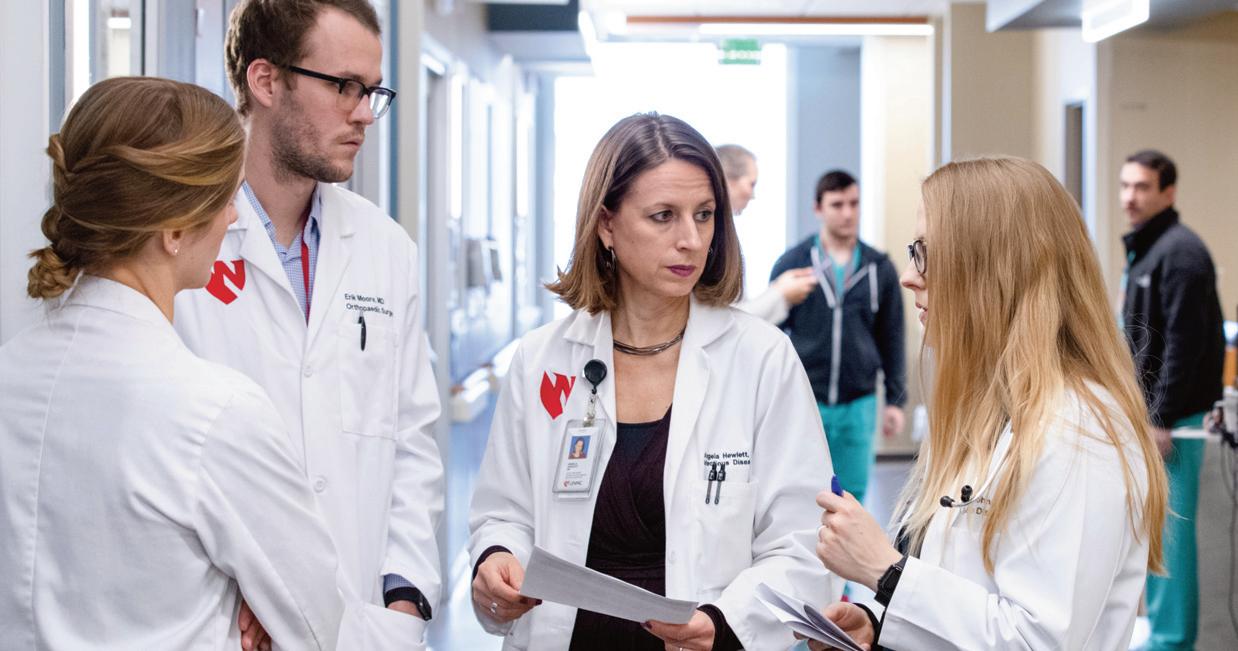
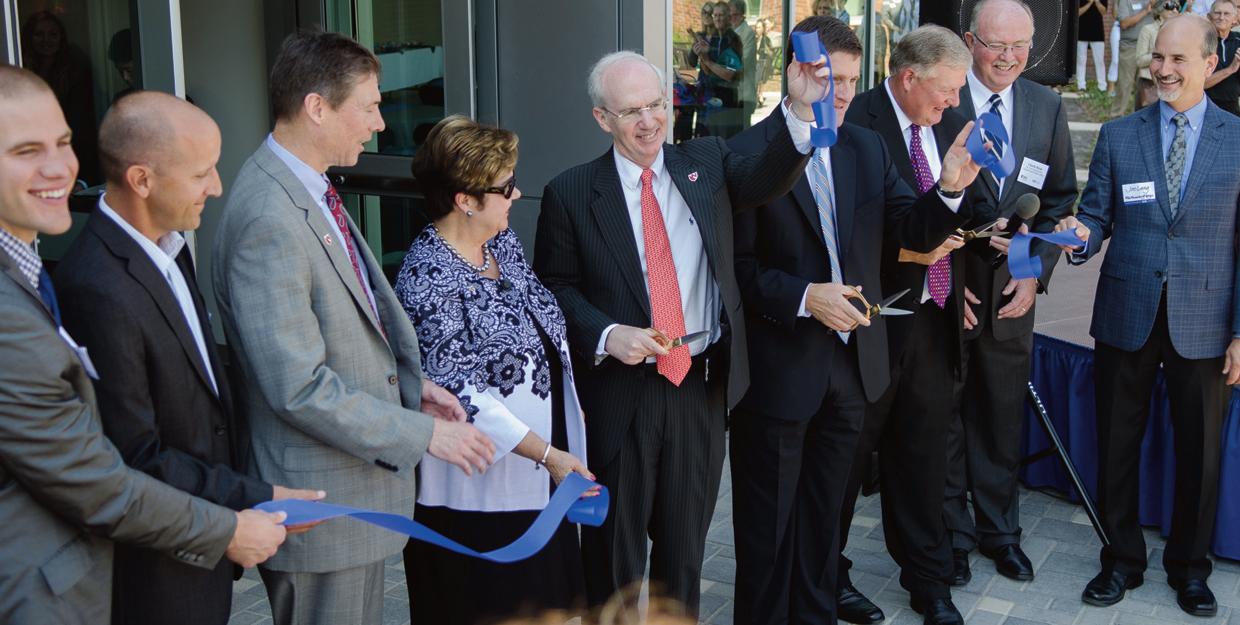
COntinueD • mmagazine
THE 2015 OPENING OF A HEALTH SCIENCE BUILDING ON THE UNK CAMPUS ENABLED UNMC TO EXPAND ITS EDUCATIONAL OFFERINGS IN NURSING AND ALLIED HEALTH. NOW, A SECOND BUILDING IS PLANNED TO PROVIDE MORE UNMC HEALTH CARE PROGRAMS AT UNK.
CONTINUED unmc innOVatiOn & leaDership
HEALTH CARE TEAMS GATHER TO DISCUSS A PATIENT CASE.
workforce development AND TRAINING
The benefits to rural pathways students are plentiful: free undergraduate tuition, guaranteed admission to UNMC, early registration privileges, and opportunities to visit the UNMC campus and make connections during undergraduate studies. Eligibility requirements include academic proficiency and graduation (or equivalent) from a Nebraska high school, and students must be from a rural area of the state. Participating programs include dentistry, dental hygiene, medical lab science, medicine, nursing, occupational therapy, pharmacy, physician assistant, physical therapy, and radiography.
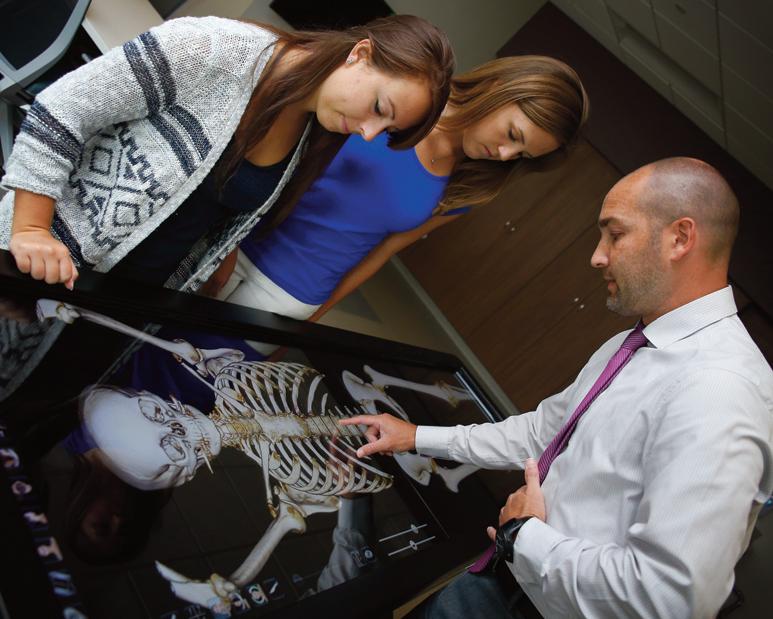
“For more than 30 years, UNMC has had pathways programs encouraging young people from Nebraska’s rural communities to enter the health professions and then to give them a pathway to those professions and back to rural communities to practice… They are exposed to some unique training opportunities with other cohorts from other disciplines, and they’re really trained to meet the unique needs of our rural communities,” Carritt said. “They still have to apply and meet all requirements as an undergraduate, but the reality is, they have a fast track to a seat in a health professions training program at UNMC.”
Returning to rural roots

Neligh native Kelsey Green is a past president of the Student Association for Rural Health. She’s expecting to graduate from UNMC’s College of Medicine in 2024.
“I participated in the UNMC Rural Health Opportunities Program at Wayne State College. RHOP supported my goal of becoming a physician in more ways than one. First and foremost, this program granted me early admission into UNMC. While there were some stipulations along with this admission that I had to maintain during my undergraduate career, they kept me accountable and on the right track to be a successful student in medical school,” she said. “In addition, this program supported me financially. Medical school is, unfortunately, a costly endeavor regardless
UNIVERSITY OF NEBRASKA MEDICAL CENTER mmagazine • nOV/DeC 2022 16
WHETHER THROUGH ROTATIONS OR VOLUNTEER WORK, UNMC STUDENTS ENGAGE WITH THE COMMUNITIES IN WHICH THEY LIVE, WORK AND LEARN.
UNMC STUDENTS LEARN ABOUT ANATOMY USING THE ANATOMAGE VIRTUAL DISSECTION TABLE, A 3D INTERACTIVE TOUCH SCREEN MUCH LIKE A HUMAN-BODY SIZED iPAD.
speCial eDitiOn
meeting the needs OF COMMUNITIES ACROSS NEBRASKA
of where you train, but RHOP lightened this burden for me. I was fortunate enough to enter medical practice with minimal debt, unlike most.”
Green said her transition from undergraduate school to medical school was nearly seamless, thanks to RHOP.
“I was already acquainted with both the campus and many faculty members. Moreover, by participating in the program, I was surrounded with like-minded individuals with the same goal of becoming a successful physician in rural Nebraska,” she said.
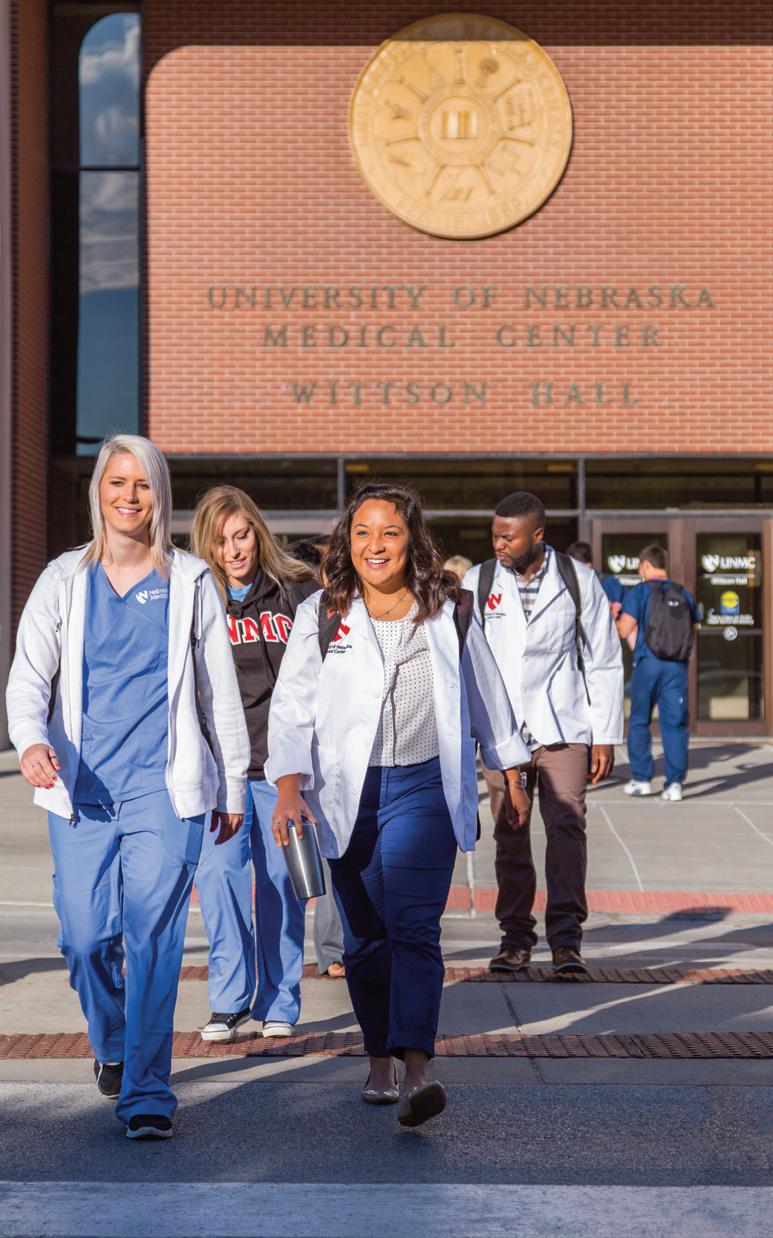
Green plans to return to her roots in northeast Nebraska to practice medicine.
“Growing up, I always admired the physicians practicing in Neligh, and to this day that has not changed. They are pillars not just of the hospital system, but of the entire community. They know their patients on a professional and a personal level. As a future physician, I aspire to have a similar relationship with my patients. I don’t just want to see them in clinic when they’re feeling ill; I want to go to the grocery store or to the high school basketball game and see them thriving in the community,” she said. “To put it simply, my experiences growing up are why I want to return to rural Nebraska and moving to Omaha to attend medical school has only solidified that goal. Practicing in rural Nebraska is not for everyone, but it’s what’s right for me.”
Heidi Kaschke, UNMC’s High School Alliance director, said recruitment efforts begin early.
“We’re here to help high school juniors and seniors start their journey toward a fulfilling health care career,” she said. “Under the guidance of Senior Vice Chancellor for Academic Affairs Dele Davies, the UNMC High School Alliance is the first step on the pathway to a career in health care.”
COntinueD • mmagazine
CONTINUED unmc innOVatiOn & leaDership
UNMC SERVES MORE THAN 4,300 STUDENTS IN MORE THAN 60 PROGRAMS.
workforce development AND TRAINING
~ NIColE CARRITT, M.p.H., DireCtOr Of rural health initiatiVes, unmC
Another health care workforce gap pathway programs help fill is in urban communities. The University of Nebraska at Omaha has developed an undergraduate program called UHOP (Urban Health Opportunities Program), modeled after the successful RHOP and designed to keep young professionals in the Omaha metro area upon completion of their training.
“Let’s not forget there are quite a few of these so-called ‘health deserts’ in urban America, as there are in rural America, and access to reliable care is just not there,” said UNMC Chancellor Jeffrey P. Gold, M.D.
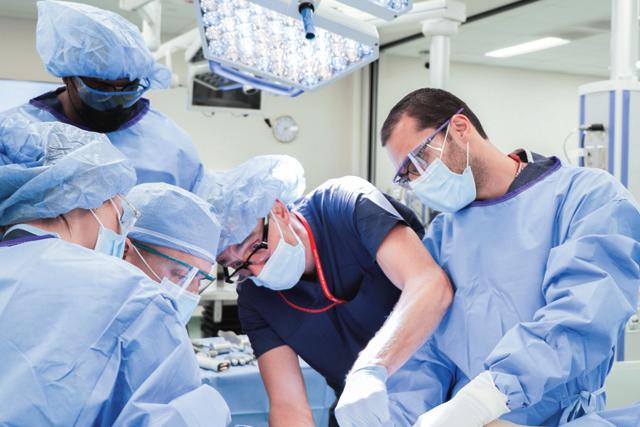
The High School Alliance also addresses the need for more mental health practitioners.
“The UNMC High School Alliance program offers a behavioral health course to our high school students. This course is very popular, and we are at capacity every year,” Kaschke said.
“There is definitely interest in this specialty; we just need to continue to give students the opportunities and education to pursue this field.”

Simulation in Motion-Nebraska (SIM-NE) is another effort UNMC has embarked on to meet the needs of rural communities. SIM-NE enhances the quality and accessibility of health care education for rural professionals, EMS and critical access hospitals throughout the state by delivering high-quality, technologically advanced simulation training (see SIM-NE page 9).
“Our responsibility, and I take this very personally, is to scan across the entire state both the rural and urban communities, to identify those that are most underserved and do anything and everything we can to provide future workforce,” Gold said.
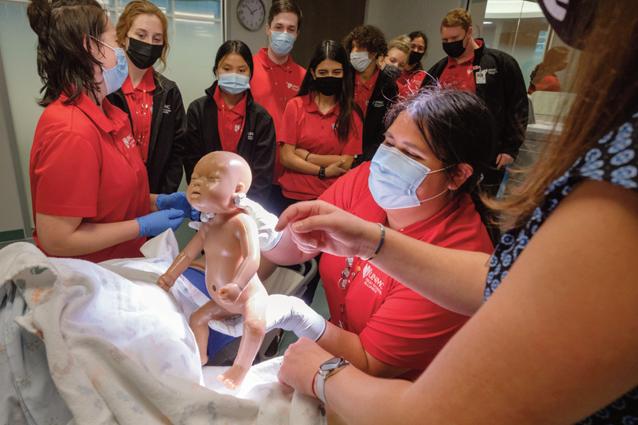
COntinueD • mmagazine UNIVERSITY OF NEBRASKA MEDICAL CENTER mmagazine • nOV/DeC 2022 18
STUDENTS IN UNMC’S HIGH SCHOOL ALLIANCE PROGRAM LEARN THE BASICS OF LABOR AND DELIVERY IN IEXCEL’S BIRTHING SIMULATION LAB. THE PROGRAM ENABLES HIGH SCHOOL STUDENTS TO TAKE COURSES, OBSERVE, SHADOW AND WORK ALONGSIDE WORLD-RENOWNED TEAMS AT THE MED CENTER.
UNMC’S EDUCATION PROGRAMS TRAIN MORE HEALTH PROFESSIONALS THAN ANY OTHER INSTITUTION IN NEBRASKA.
UNMC’S PRIMARY CLINICAL PARTNER IS NEBRASKA MEDICINE.
CONTINUED speCial eDitiOn
THERE’S A significant economic CoMpoNENT THAT goES AloNg WITH HEAlTH CARE, THE professionals yoU bRINg INTo yoUR communities ANd THE SAfETy NET IT provides To lIvE THERE.
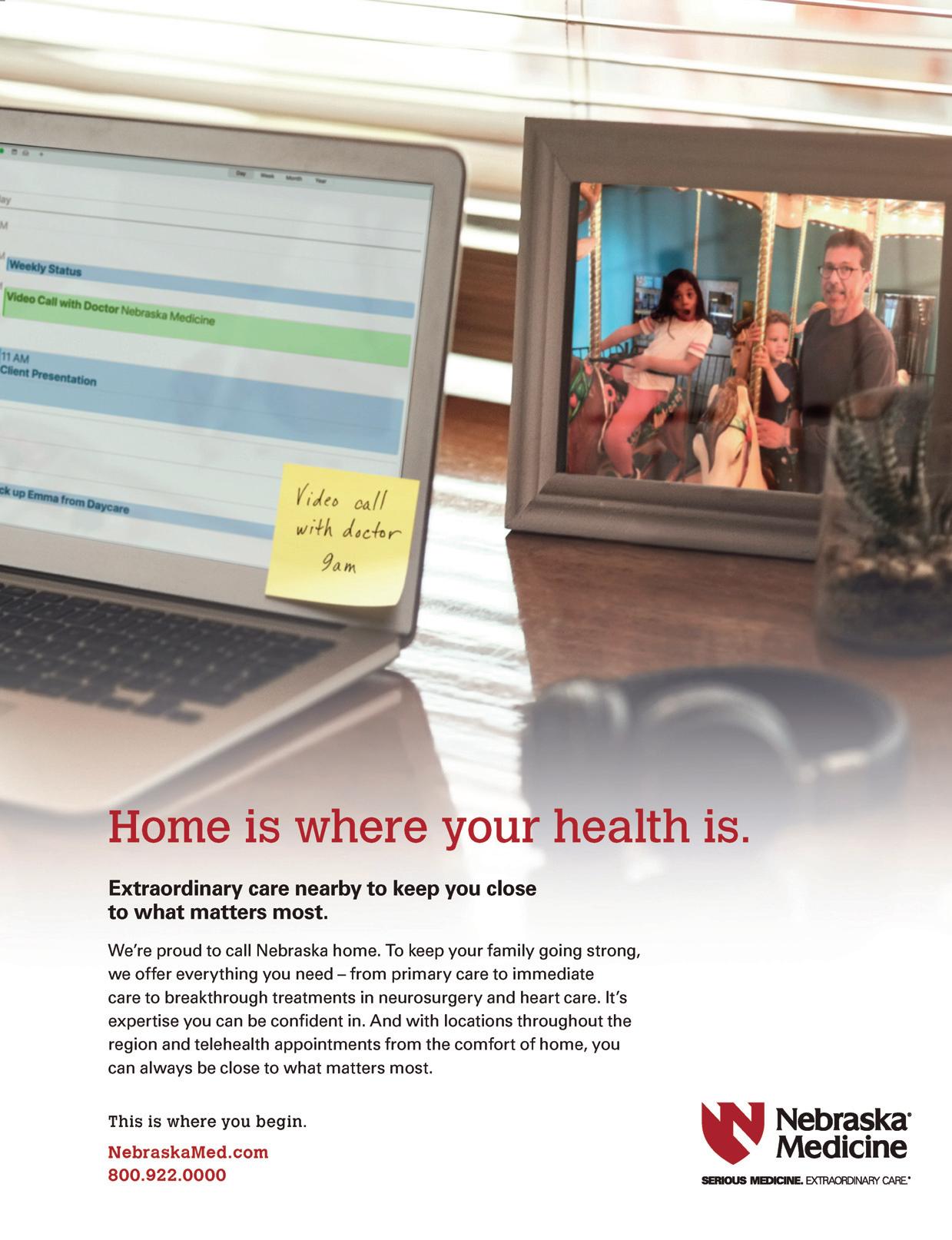
workforce development AND TRAINING
WE WIll THINK innovatively AboUT HoW WE CAN do A better job of pRovIdINg EdUCATIoNAl opportunities AS CloSE To WHERE pEoplE live ANd WANT To lIvE AS possible.
~ NIColE CARRITT, M.p.H., DireCtOr Of rural health initiatiVes, unmC
oNE IN fIvE NEbRASKANS struggle WITH A MENTAl HEAlTH oR SUbSTANCE USE dISoRdER. IN AddITIoN, 88 of our 93 CoUNTIES ARE designated by THE HUMAN RESoURCES SERvICES AdMINISTRATIoN AS bEHAvIoRAl HEAlTH pRofESSIoNAl shortage AREAS. dURINg THE CovId-19 pandemic, THERE HAS bEEN AN increased dEMANd foR SERvICES, MAKINg access To CARE EvEN MoRE limited.
AT THE behavioral health education center of nebraska, WE ARE committed To THE RECRUITMENT, TRAININg ANd RETENTIoN of THE bEHAvIoRAl HEAlTH workforce To IMpRovE access To bEHAvIoRAl HEAlTH CARE foR All NEbRASKANS. SINCE bHECN’S INCEpTIoN IN 2009, WE HAvE collaborated WITH STAKEHoldERS ACRoSS THE STATE To SUppoRT THE NEEdS of bEHAvIoRAl HEAlTH pRofESSIoNAlS ANd NEbRASKA CoMMUNITIES. AS A RESUlT, WE HAvE SEEN A significant RISE IN THE bEHAvIoRAl HEAlTH WoRKfoRCE. HoWEvER, SHoRTAgES ANd dISpARITIES continue, ANd WE CoNTINUE To gRoW ANd innovate To MEET THE EvER-CHANgINg landscape.
~ MARlEy doylE, M.d., DireCtOr, behaViOral health eDuCatiOn Center Of nebraska
IN NEXT SECTION: global center for health security
UNIVERSITY OF NEBRASKA MEDICAL CENTER mmagazine • nOV/DeC 2022 20
speCial eDitiOn
healthier rural nebraska
A 2022 health care workforce report issued by UNMC showed that the number of nurse practitioners in Nebraska increased significantly and the number of practicing pharmacists increased modestly since 2020. Despite these positive developments, rural areas still lack health care professionals, and the aging of the workforce across multiple disciplines threatens to exacerbate current shortages.
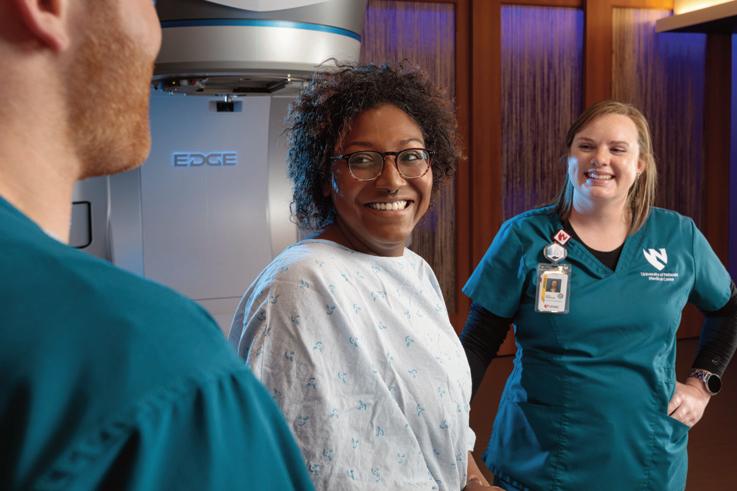
These and other key findings of the study appear in the report, “The Status of the Nebraska Health Care Workforce: Update 2022,” which is available online.


SCAN THIS QR CODE TO LEARN MORE!

“When health care professionals work in rural areas, they help to provide quality health care as close to home as possible. But they also create economic sustainability and vitality in the communities where they live,” said UNMC Chancellor Jeffrey P. Gold, M.D. “The need has never been clearer: We must increase access to health care workforce pipelines in rural Nebraska to improve quality of life for all our communities, to support economic sustainability and to bolster the number of health care professionals for decades to come.”
The study, commissioned and funded by the UNMC Office of Rural Health Initiatives and the Nebraska Area Health Education Center Program (AHEC), used the most recent data from the UNMC Health Professions Tracking Service and the State of Nebraska. The report acknowledges the ongoing impact of the pandemic on the health care workforce and that the shortages have exacerbated since the data was collected.
In addition to pathway programs, studies show that recruiting and training students from rural and underserved areas and training them as close to those communities as possible are proven strategies for increasing the likelihood they’ll return to those areas to practice.
Toward that end, UNMC has gained support from the Nebraska Legislature for the Healthier Rural Nebraska initiative, a project that will expand UNMC health care programs at the University of Nebraska at Kearney. The UNK-UNMC project includes construction of a health science focused building at UNK, which will allow UNMC to expand the presence of its allied health and nursing programs, and launch new programs that will train physicians, pharmacists and public health professionals.
Construction is expected to begin in September 2023, with projected completion in the summer of 2025.
COntinueD • mmagazine unmc innOVatiOn & leaDership
TO BOOST HEALTH CARE WORKFORCE
OFFERS A VARIETY OF ALLIED HEALTH PROFESSIONS PROGRAMS RANGING FROM RADIATION THERAPY AND GENETIC COUNSELING TO PHYSICAL THERAPY AND MEDICAL NUTRITION.
INITIATIVE
UNMC
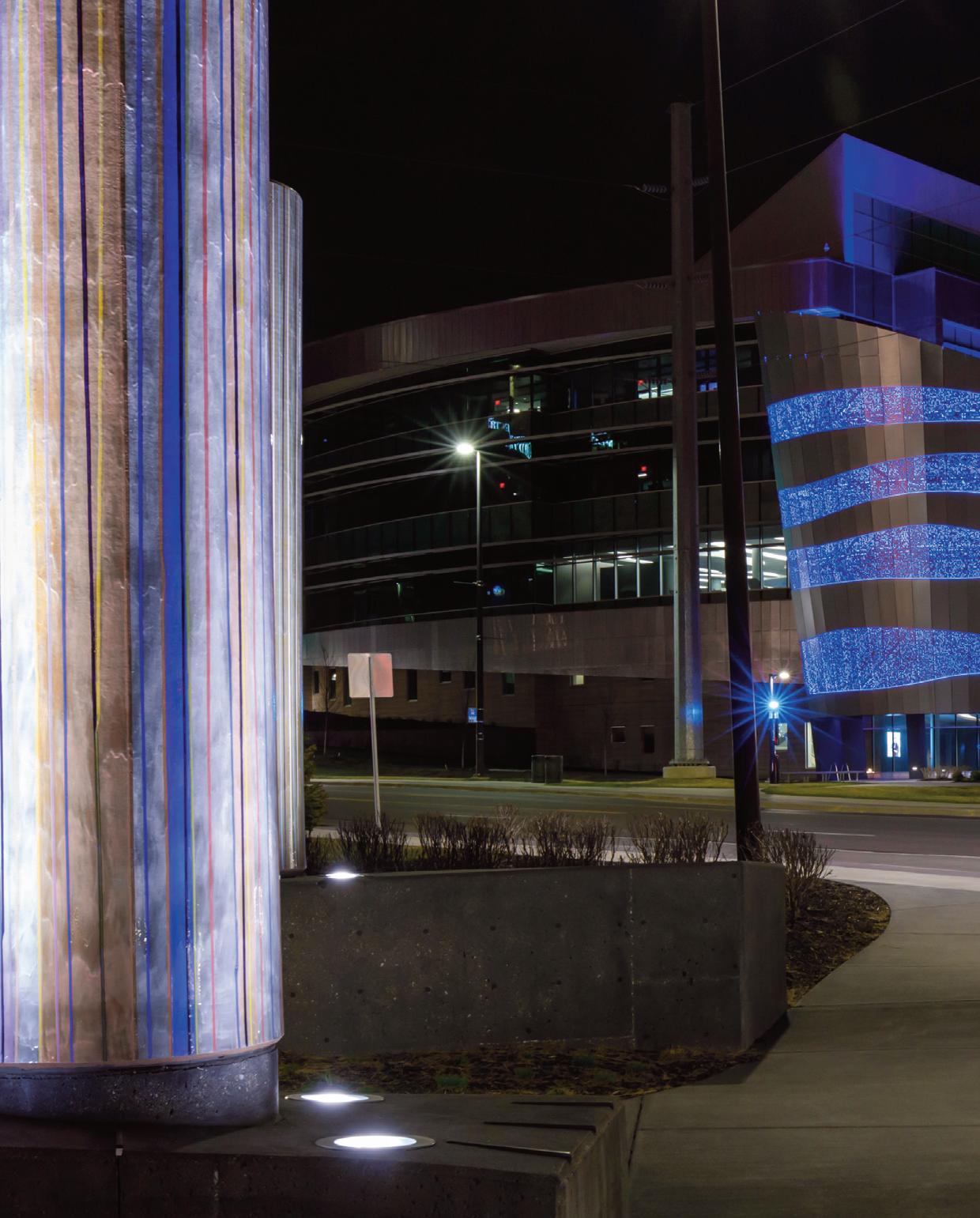


UNIVERSITY OF NEBRASKA MEDICAL CENTER global mmagazine • nOV/DeC 2022 22 speCial eDitiOn
UNMC provides biopreparedness training and education, while standing ready to respond to global emergencies.

FOR HEALTH SECURITY
CONTINUED
unmc innOVatiOn & leaDership
• mmagazine
center
NEBRASKA MEDICINE’S AND UNMC’S BIOPREPAREDNESS
CAPABILITIES CAUGHT THE WORLD'S ATTENTION IN 2020, when the National Quarantine Unit and the Nebraska Biocontainment Unit were activated during the COVID-19 outbreak in close alliance with federal partners. However, the origins of the Global Center for Health Security, established as an umbrella entity for biopreparedness in 2017, actually stretch back more than two decades.
Following the terrorist attacks of September 11, 2001, UNMC was among a group of organizations across the country to receive federal funding for bioterrorism preparedness. In 2004, with the Nebraska Department of Health and Human Services as well as Nebraska Medicine, UNMC began planning the Nebraska Biocontainment Unit. When it opened in 2005, it was the largest unit of its kind in the U.S., with the capability to handle highly contagious and dangerous conditions including SARS, smallpox, plague, and viral hemorrhagic fevers.
“Capability” was the emphasis, said Shelly Schwedhelm, MSN, executive director for the Global Center for Health Security.
“We spent the next nine years or so really begging anyone to notice us,” Schwedhelm said, wryly. However, “A lot of work went into being prepared and ready.”
The unit’s team of health care workers had all volunteered to train and be prepared for the potential need to activate the unit, Schwedhelm explained. Without an imminent need seen for its activation at the time, the team didn’t have a large stock of supplies, but it was ready to follow a checklist of what would have to be procured and who would need to be involved.
“’How long would it take us?’ was our exercise element,” Schwedhelm said.

global center FOR HEALTH SECURITY

Team members contemplated “terrible pathogens” through their training, Schwedhelm said. “We always said the worst-case scenario would be a viral hemorrhagic fever like Ebola.”
Saying ‘yes’
In 2014, the hope-it-never-happens scenario came to life when the U.S. Department of State asked the Nebraska Biocontainment Unit to care for deployed Americans with Ebola. Two patients were safely and successfully treated; the third patient, already gravely ill, died after two days of treatment.
“It was a big risk for our organization to say ‘yes,’” Schwedhelm recalled.
“When we were 21 days out from our third patient’s care and nobody was symptomatic, nobody had issues, I remember feeling a huge relief at the fact that we got through this with all our health care workers. Mistakes were made but none was serious enough to cause harm to anyone.”
Later in 2014, the Nebraska Ebola Method for safely caring for patients with infectious pathogens was made publicly available as an online course and resource. The team also offered Centers for Disease Control and Prevention courses on campus. The Biocontainment Unit was praised by then-President Barack Obama and others at the national level, and locally, “The Ebola Fighters” were named “Midlanders of the Year” by the Omaha World-Herald.
Global Center for Health Security CoExecutive Director John Lowe, Ph.D., said the events of 2014 shaped a national profile for the Biocontainment Unit, and in association, UNMC.
“When we were utilized to provide care to health care workers who were brought back from West Africa, that expertise developed and honed at UNMC/NM became highly sought-after,” Lowe said. “UNMC/NM was more than happy to partner and collaborate, and it really grew into a number of national and international programs for research, for developing training and response capabilities, and for looking at capacity that already existed and testing to see if it was adequate for various health emergencies.”
A $12 million grant from the U.S. Department of Health and Human Services supported an effort with Emory University in Atlanta and Bellevue Hospital Center in New York City in 2015 to establish and co-lead the nation’s National Ebola Training and Education Center (now National Emerging Pathogens Training and Education Center). The following year, the U.S. Department of Health and Human Services awarded nearly $20 million to UNMC and Nebraska Medicine to develop a national training, simulation and quarantine center. In 2017, UNMC established the Global Center for Health Security.
Ready for anything Lowe said health security is an emerging area at the intersection of medicine, science and public health.
“Health security is really focused on health emergencies. There’s the infectious disease example, but we tend to look at it from an all-hazards approach, where it could be a natural disaster, an industrial disaster or an infectious disease; we kind of cover the gamut,” he said. “UNMC cut our teeth on infectious disease management, so that’s the bulk of our expertise, but we handle all of these health emergencies.”
mmagazine • nOV/DeC 2022 24
UNIVERSITY OF NEBRASKA MEDICAL CENTER speCial eDitiOn
finding new and better SOLUTIONS
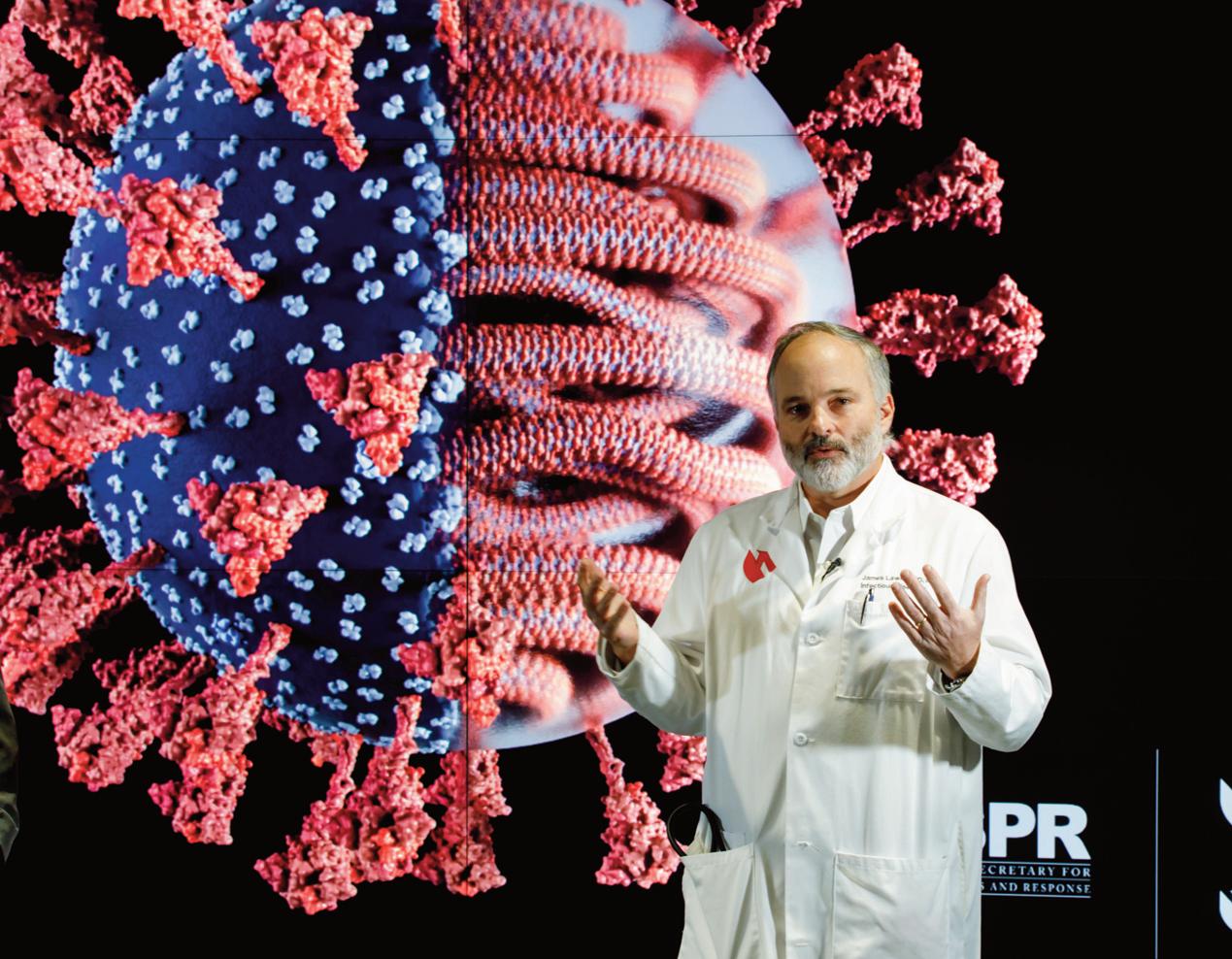
COntinueD • mmagazine
CURRENT
FUTURE HEALTH
CONTINUED unmc innOVatiOn & leaDership
JAMES LAWLER, M.D., CO-EXECUTIVE DIRECTOR OF THE GLOBAL CENTER FOR HEALTH SECURITY AT UNMC, DISCUSSES SARS-COV-2 WHICH IS RESPONSIBLE FOR COVID-19. THE ANIMATION IS PART OF UNMC’S ONGOING WORK TO DEVELOP 3D MEDICAL CONTENT TO HELP
TEACH AND TRAIN
AND
CARE PROFESSIONALS.
FOR RESPONDING TO WIDESPREAD HEALTH EMERGENCIES ~ jE
REy p. gold, M.d.,
unmC WE’RE uniquely poSITIoNEd To bE pART of THE solution RATHER THAN pART of THE problem.
ff
ChanCellOr,
global center FOR HEALTH SECURITY
UNMC Chancellor Jeffrey P. Gold, M.D., added, “We’re not talking, of course, about just the threat of biological agents, we’re talking about the full spectrum of 21stcentury threats, which represents everything from chemical to radiological to nuclear to biological and then the so-called explosive and environmental types of concerns.”
“A health emergency tends to have a global impact. Even if it’s a localized event on the other side of the globe, it can have a relatively significant impact for other countries and for regions of the world. We live in an increasingly globalized society,” Lowe said, pointing out that travelers can get to the other side of the world in a single day. “In the same way, these health emergencies can also work their way around the globe pretty quickly.”
“If the last few years hasn’t taught us the importance of this, then I’m not sure what will,” Schwedhelm said. “The issue of travel now is so different from anything we’ve experienced before.”
UNMC’s Dr. Edwin G. & Dorothy Balbach Davis Global Center (see also iEXCEL page 5) houses the Training, Simulation & Quarantine Center, with state-of-the-art quarantine facilities, clinical simulation infrastructure and a training lab. It opened in 2019.
“We have so many experts on campus for whom this is their mission, whether that’s the UNMC College of Public Health or the Global Center for Health Security; we have virologists, we have infectious disease experts who are known nationally and internationally. This is what we do,” Schwedhelm said. “The federal government sees us as a very agile organization, one that can very quickly step up and step in, and we often say, ‘Yes!’ and ‘What can we do to help?’ Not only do we have the subject-matter expertise that’s exceptional, but we are also always very prompt in our ability to respond to events and situations.”

COntinueD • mmagazine UNIVERSITY OF NEBRASKA MEDICAL CENTER mmagazine • nOV/DeC 2022 26
JANA BROADHURST, M.D., PH.D., DIRECTOR OF THE NEBRASKA BIOCONTAINMENT UNIT CLINICAL LABORATORY, FOCUSES HER RESEARCH ON INFECTIOUS DISEASES DIAGNOSTICS.
THE fEdERAl government SEES US AS A vERy agile
oRgANIzATIoN, oNE THAT CAN vERy qUICKly step up ANd step in.
CONTINUED speCial eDitiOn
~ SHElly SCHWEdHElM, msn, exeCutiVe DireCtOr, glObal Center fOr health seCurity
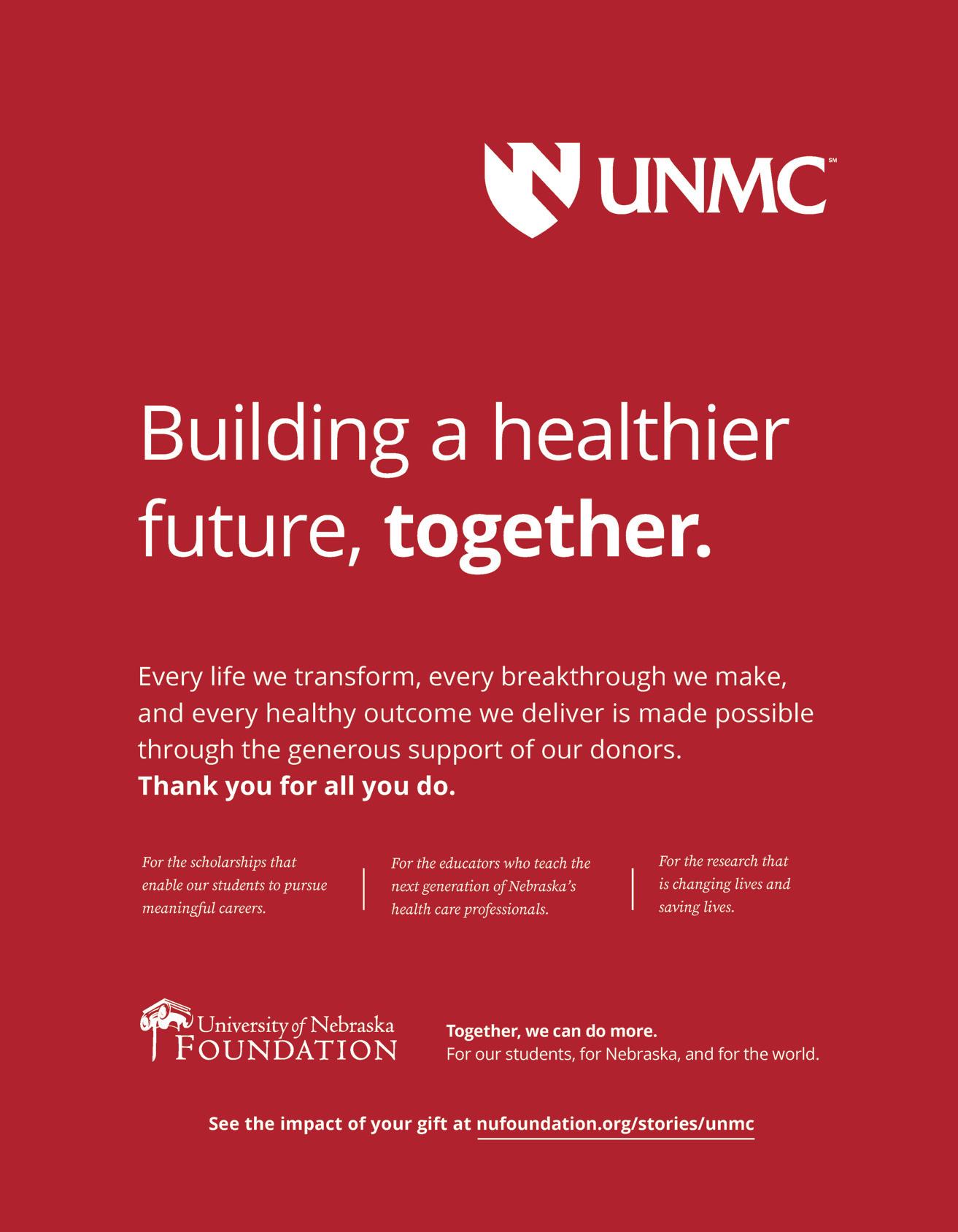
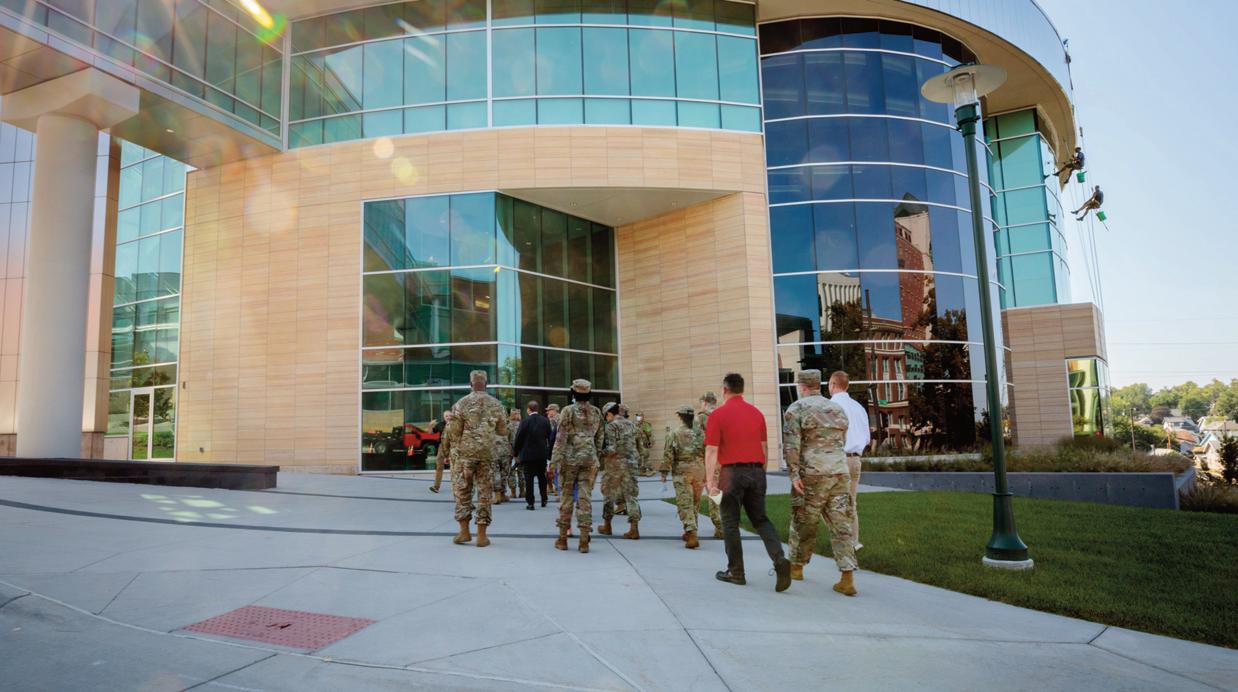

CONTINUED N COntinueD • mmagazine UNIVERSITY OF NEBRASKA MEDICAL CENTER mmagazine • nOV/DeC 2022 28
SIMULATION PROVIDES RISK-FREE TRAINING ENVIRONMENTS THAT ENABLE LEARNERS TO PRACTICE SKILLS AND ACHIEVE ACCEPTABLE LEVELS OF COMPETENCY BEFORE MOVING ON TO REAL PATIENT SITUATIONS.
MEMBERS OF THE U.S. AIR FORCE TOUR THE TRAINING, SIMULATION AND QUARANTINE CENTER HOUSED IN THE DAVIS GLOBAL CENTER. speCial
eDitiOn
global center FOR HEALTH SECURITY
WHEN THE U.S. GOVERNMENT CALLED UPON UNMC AND NEBRASKA MEDICINE TO HELP AMERICAN CITIZENS DURING THE PANDEMIC, THEY RESPONDED – JUST AS THEY DID IN 2014 WHEN THEY CARED FOR PATIENTS WITH EBOLA IN THE NATIONAL BIOCONTAINMENT UNIT.
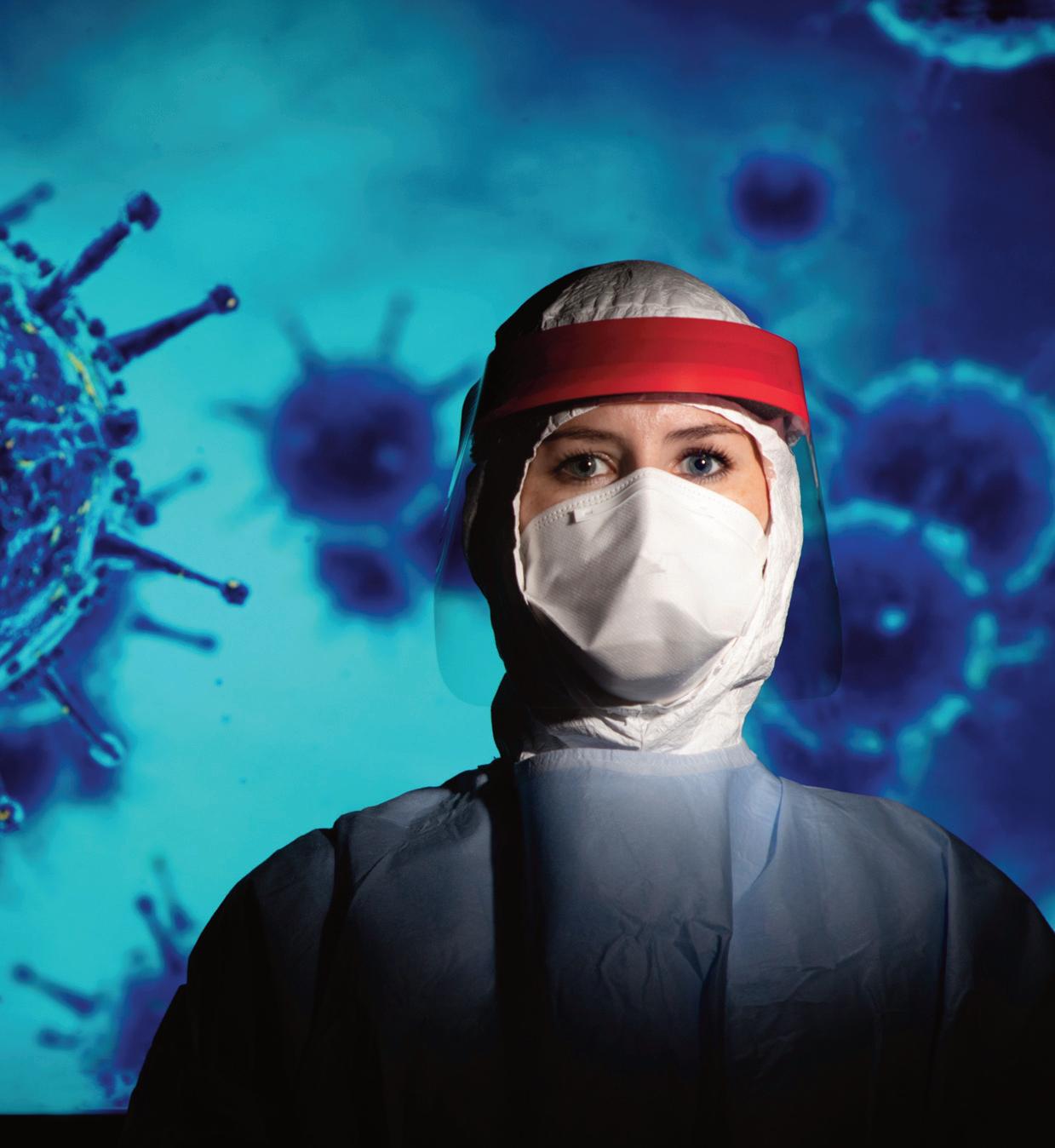
NEW ASSETS CONTINUED unmc innOVatiOn & leaDership
global center FOR HEALTH SECURITY
~ joHN loWE, pH.d., CO-exeCutiVe DireCtOr, glObal Center fOr health seCurity
“We’ve invested a lot of resources in developing expertise and capabilities to work in this space,” Lowe said. “It also tends to be an area of science and medicine that requires different people with different backgrounds to collaborate, and that is one of the areas where UNMC excels.”
A unique focus UNMC must continue to strengthen its global health security efforts, Schwedhelm said, and the team remains vigilant.
“We are always paying attention to various outbreaks or potential outbreaks,” she said. “The focus now is to produce capacity and capability.”
“At any given moment during the COVID-19 pandemic, our team was tracking at least two or three other infection-disease outbreaks that had the potential to grow and cause greater impact than just a few isolated cases,” Lowe said, adding that monkeypox and Marburg virus disease are still on the radar. “We keep really busy, keeping track of where these pop up, who’s managing them, what types of resources or capacities they have and how we might be able to help them.”
The Global Center for Health Security is leading the way.
“For the past eight years, there has probably been a handful of centers for health security in the U.S. and a few sprinkled across the globe. And through the COVID19 experience, the realization that this is a huge need has been clear, so there’s a number of new centers like this established around the globe and in some cases with significant resources,” Lowe said. “UNMC is unique in its focus on response and the experience on the ground, face-to-face… That keeps us on the front edge of what it means to manage these emergencies, it helps us drive the interdisciplinary research required to get better at managing these emergencies, and it also helps us train the people around the country and around the globe who have the responsibility of frontline response. We’re unique in that we’re taking that typical academic model of research, practice and education and applying it wholesale to health security, whereas others tend to be more focused on the policy measures or the analytics and predictions.”
The role of the Global Center for Health Security is being at the cutting edge of finding new and better solutions for responding to health emergencies, Lowe said.
“It’s also making sure that as the scientific developments and knowledge developments occur, we’re out there training people on them so that the latest knowledge and techniques are available and being utilized by front-line folks all over the world.”
The Global Center for Health Security is an excellent example of UNMC’s collaborative spirit, Lowe said. See Collaborative Spirit page 42).
“All of the faculty and researchers and clinicians who participate in the Global Center are in other colleges, the hospital, and other parts of the university. The Global Center in and of itself is highly collaborative and brings together people from across the UNMC enterprise,” he explained.
The center also has national partnerships with hospitals and universities for research, training and assessment, plus is part of international networks and consortiums “to develop solutions that work for everybody,” Lowe added. “In addition to our prioritization of collaboration—on campus, nationally and internationally—where we really see ourselves going in the future is to develop leaders globally that have been trained in health security.”
IN NEXT SECTION: economic impact
mmagazine • nOV/DeC 2022 30 UNIVERSITY OF NEBRASKA MEDICAL CENTER
of THE
participate
THE hospital,
THE
l CENTER IN ANd
ly collaborative
gS together pEopl
THE
all
fACUlTy ANd RESEARCHERS ANd ClINICIANS WHo
IN THE globAl CENTER ARE IN other colleges,
ANd oTHER pARTS of THE university.
globA
of ITSElf IS HIgH
ANd bRIN
E fRoM ACRoSS
UNMC ENTERpRISE.
speCial eDitiOn
finding new and better SOLUTIONS FOR RESPONDING TO WIDESPREAD HEALTH EMERGENCIES
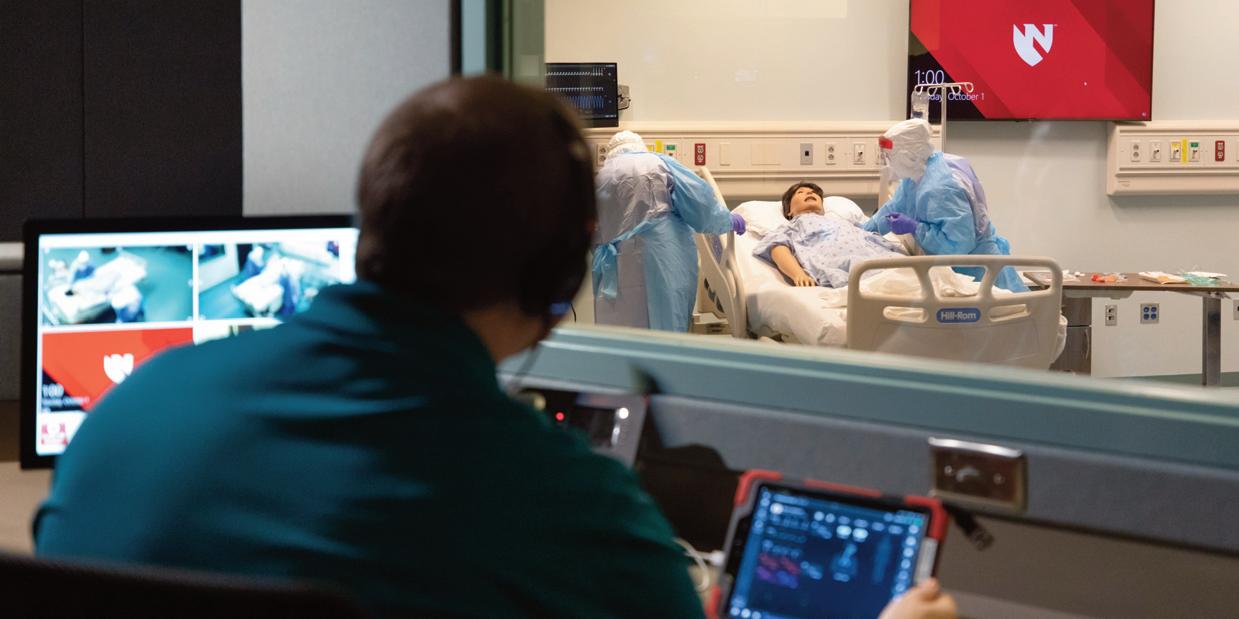
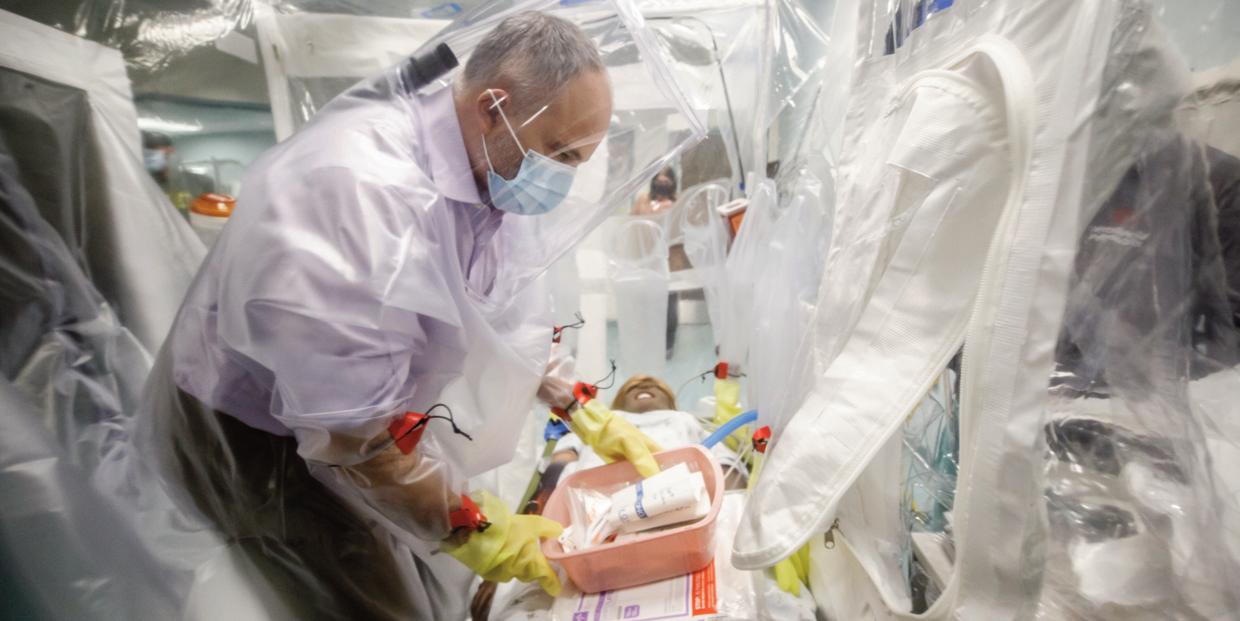
CONTINUED unmc innOVatiOn & leaDership COntinueD • mmagazine
UNMC’S GLOBAL CENTER FOR HEALTH SECURITY, IN PARTNERSHIP WITH OTHERLAB AND FUNDING FROM THE CENTERS FOR DISEASE CONTROL AND PREVENTION, TEST A MODULAR, DISPOSABLE, NEGATIVE PRESSURE ISOLATION PATIENT CARE SYSTEM. THE UNIT QUICKLY CAN BE ASSEMBLED FOR COVID-19 AND OTHER BIOLOGICAL THREATS.
A LOOK INSIDE THE TRAINING, SIMULATION AND QUARANTINE CENTER AT THE DAVIS GLOBAL CENTER ON UNMC’S OMAHA CAMPUS.
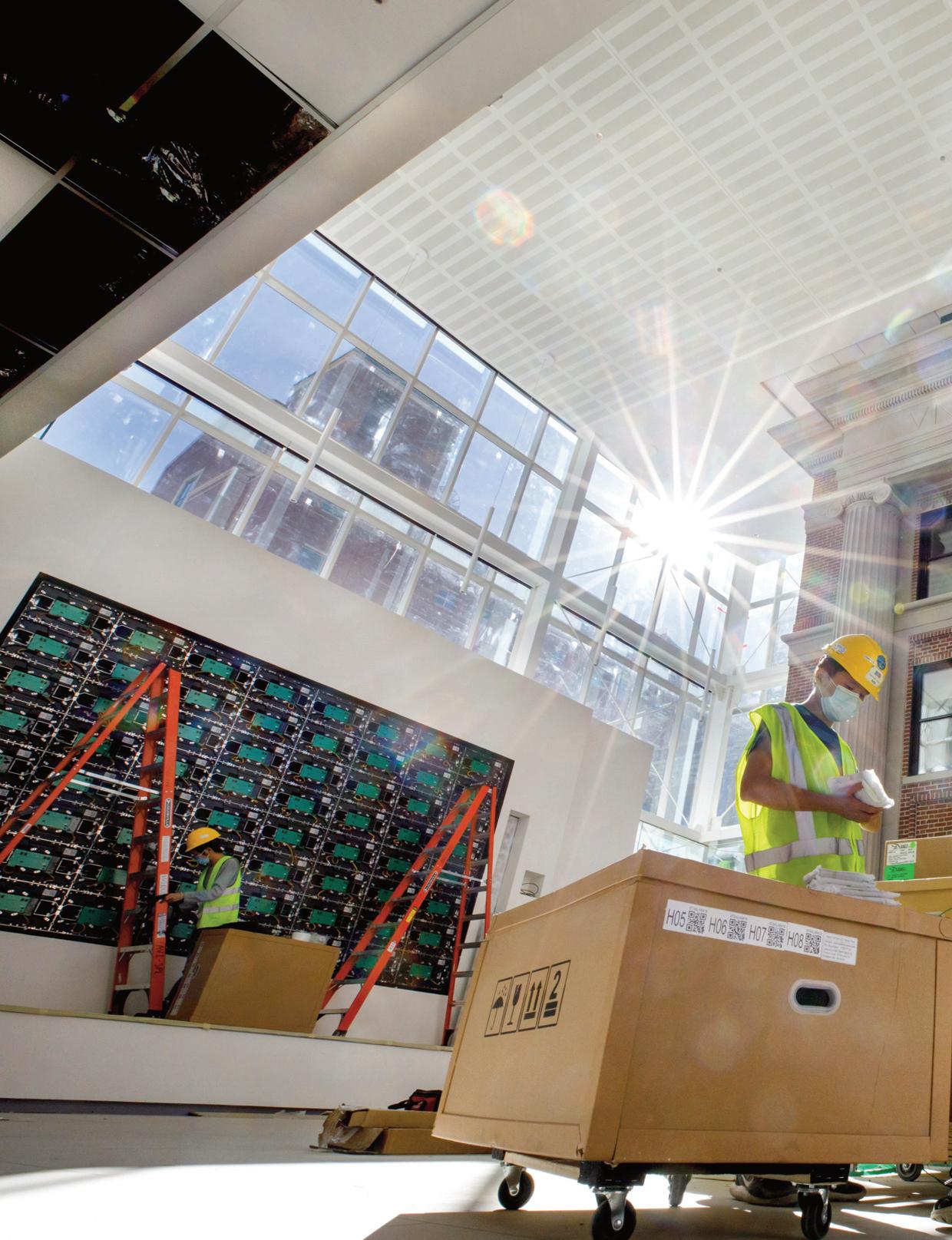


UNIVERSITY OF NEBRASKA MEDICAL CENTER economic mmagazine • nOV/DeC 2022 32 speCial eDitiOn
UNMC has never lost sight of its mission to serve the people of Nebraska, making it a leading economic driver for the state.
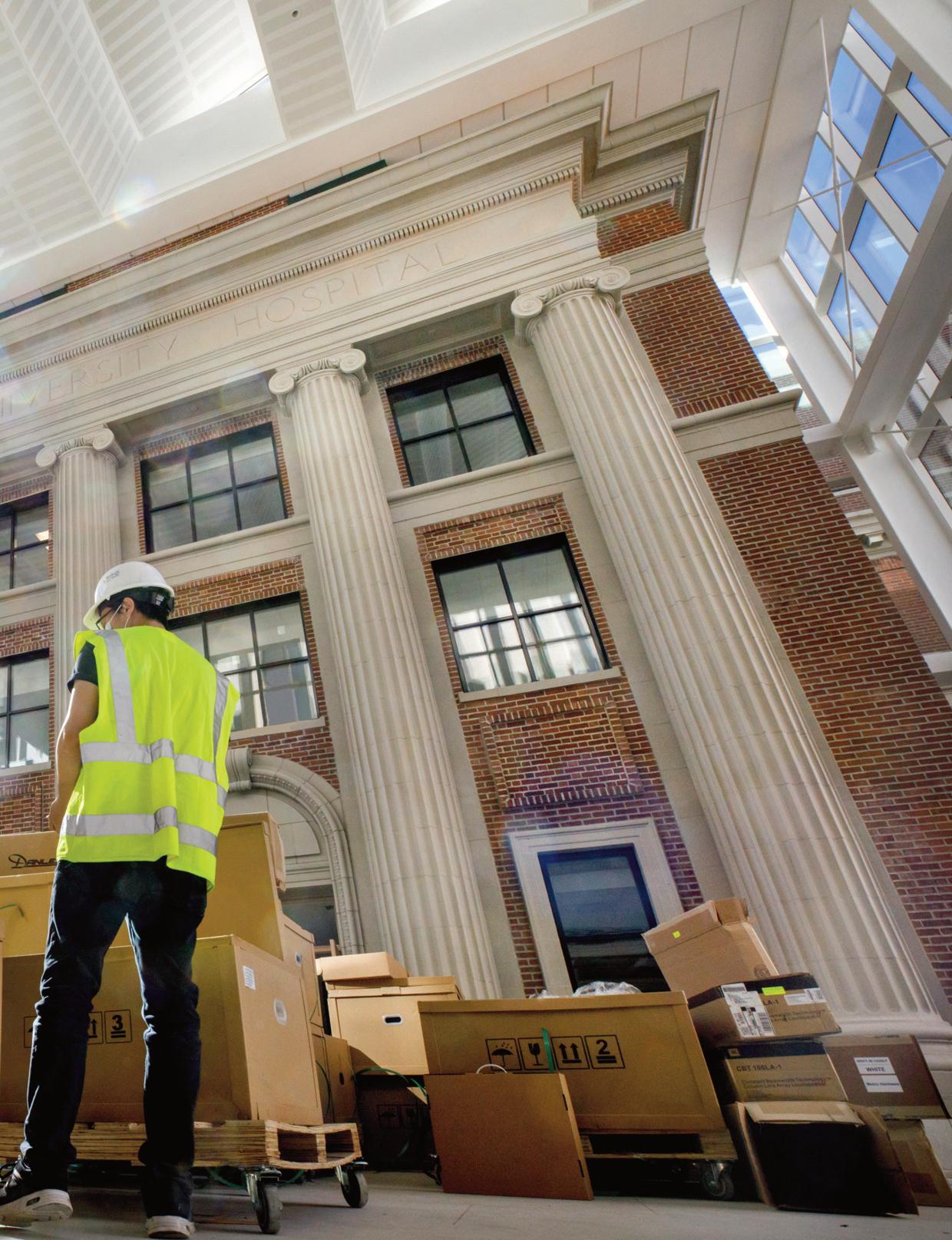
impact
UNMC AND NEBRASKA MEDICINE
unmc innOVatiOn & leaDership
• mmagazine
economic IMPACT
THERE’S NO QUESTION THAT UNMC/NEBRASKA MEDICINE IS AN IMPORTANT ECONOMIC DRIVER FOR NEBRASKA, said UNMC Chancellor Jeffrey P. Gold, M.D. “The numbers are $5.9 billion a year in economic impact, 56,000 direct and indirect employees, and more than $220 million a year in tax revenue,” said Gold, who also serves as chair of the Nebraska Medicine board. “And it continues to grow.”
Veta Jeffery, president and CEO of the Greater Omaha Chamber, noted that “this meteoric growth and continued success have made further investments into the health care industry the starting point for any discussion on Omaha’s economic future. The world-class talent at UNMC makes the institution an ambassador for Nebraska to the nation, and the Greater Omaha Chamber is honored to call them a member.”
Anne Barnes, UNMC’s vice chancellor for business, finance and business development, said the economic impact has a widespread, collective ripple effect.
“When you think about the direct employment, these are the health professions educators, clinicians and scientists who have an above-average compensation level based on market rates for these disciplines,” she said, adding that the institution’s economic impact also has a positive effect on the health of the state for years to come. “We’re training the workforce of the future.”
While higher education institutions nationally generally saw a decline in enrollment following the COVID-19 pandemic, the UNMC pipeline remains strong, she said. “We were excited that UNMC was able to continue a 22-year track record of enrollment growth. It was very small growth, but it wasn’t a decline like we saw on other health science campuses similar to ours.”
Growth continues in other ways, too.
In August, the University of Nebraska Board of Regents approved the program statement and construction budget for Phase II of the UNK-UNMC Rural Health Education Building on the University of Nebraska at Kearney campus. Construction of the $85 million facility is expected to begin in September 2023, with projected completion in July 2025. The state legislature approved $50 million in federal American Rescue Plan Act funding for capital construction, plus $10 million for iEXCEL (see iEXCEL page 5) technology startup costs, and the university has committed to securing $35 million in private funding for construction.
“We’re looking forward to the expansion in Kearney. That expansion is going to be focused primarily on training more professionals in our rural areas to address their health care needs,” Barnes said. “Currently, approximately half of Nebraska’s health care professionals—physicians, dental professionals, pharmacists, nurses, allied health professionals—are graduates of UNMC. That’s a hopefully very-closely linked indicator of our ability to grow that enrollment that will help us meet those unmet needs, not only in our local area but also in the rural areas.”
Amazing things happening UNMC alums who practice in rural areas (see Workforce Development and Training page 12) or in underserved communities also have a measurable effect on the local economy, Gold said.

“When one of our physician-graduates goes into a rural or urban community, that one individual will average more than $2 million a year in economic impact,” he said.
There are amazing things happening in the metro Omaha area, as well, Gold said.
“The Saddle Creek project is approximately 30 acres immediately to the west of Saddle Creek (Road). For a long time, certainly during my eight and a half years here, we’ve been acquiring property there in an attempt to consolidate it, and we’re now in the planning stages of building on that property,” he said. “The first project will be a multiuse center.”
The 350,000-foot administration facility at the southwest corner of Saddle Creek Road and Farnam Street is envisioned to provide administrative support and office space along with mixed-use retail space and a parking facility available to UNMC/Nebraska Medicine visitors, employees and students, Gold said.
The Saddle Creek project also will feature an innovation hub on the site of the former Omaha Steel Castings that will include leased space for companies in technology, pharmaceuticals, biotech, IT, cybersecurity and other sectors “who want physical proximity to a large and thriving academic medical center,” Gold said.

Dining and food service, an event center and other features are also being considered for a total of approximately 140,000 square feet of space.
“We’re very excited about our Saddle Creek development. We have Board of Regents approval on a $25 million administration and training facility and a $29 million innovation hub,” Barnes said. “We’ve done a lot of work on researching these types of innovation hubs across the country. Those really serve as a catalyst for taking a lot of the research and intellectual property that’s developed at a university like ours and connecting them with people who have expertise in fundraising through venture capital, licensing and patents.
mmagazine • nOV/DeC 2022 34
UNIVERSITY OF NEBRASKA MEDICAL CENTER speCial eDitiOn
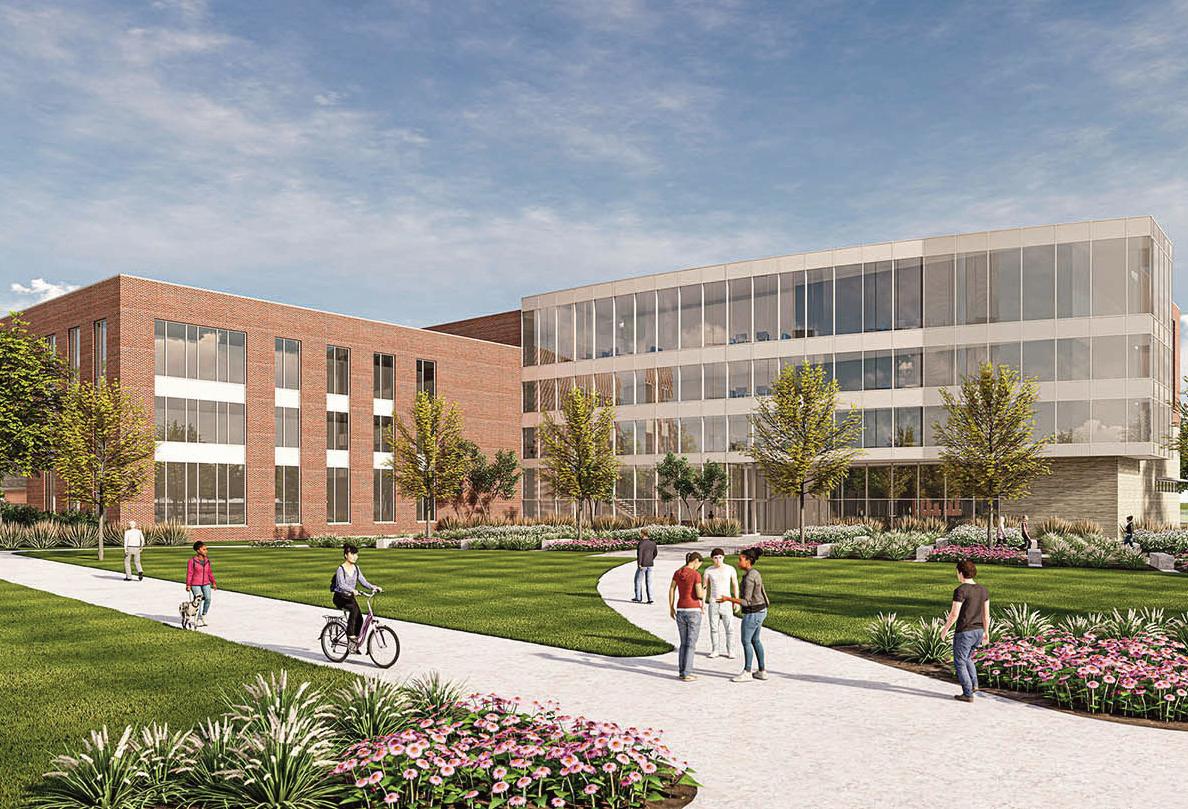
CONTINUED unmc innOVatiOn & leaDership unmc and nebraska medicine LEAD DEVELOPMENT, INNOVATION AND SUCCESS • mmagazine A RENDERING OF THE UNK-UNMC RURAL HEALTH EDUCATION BUILDING TO BE BUILT ON THE UNIVERSITY OF NEBRASKA AT KEARNEY CAMPUS. ~ bRyAN SloNE, presiDent, nebraska Chamber Of COmmerCe & inDustry WITHIN THE STATE, UNMC’S opERATIoNS HAvE A remarkable positive IMpACT oN NEbRASKA’S ECoNoMy ANd ECoNoMIC CoMpETITIvENESS. THE ‘good lIfE’ IS calling ANd UNMC IS A big pART of WHAT MAKES NEbRASKA great.
economic IMPACT
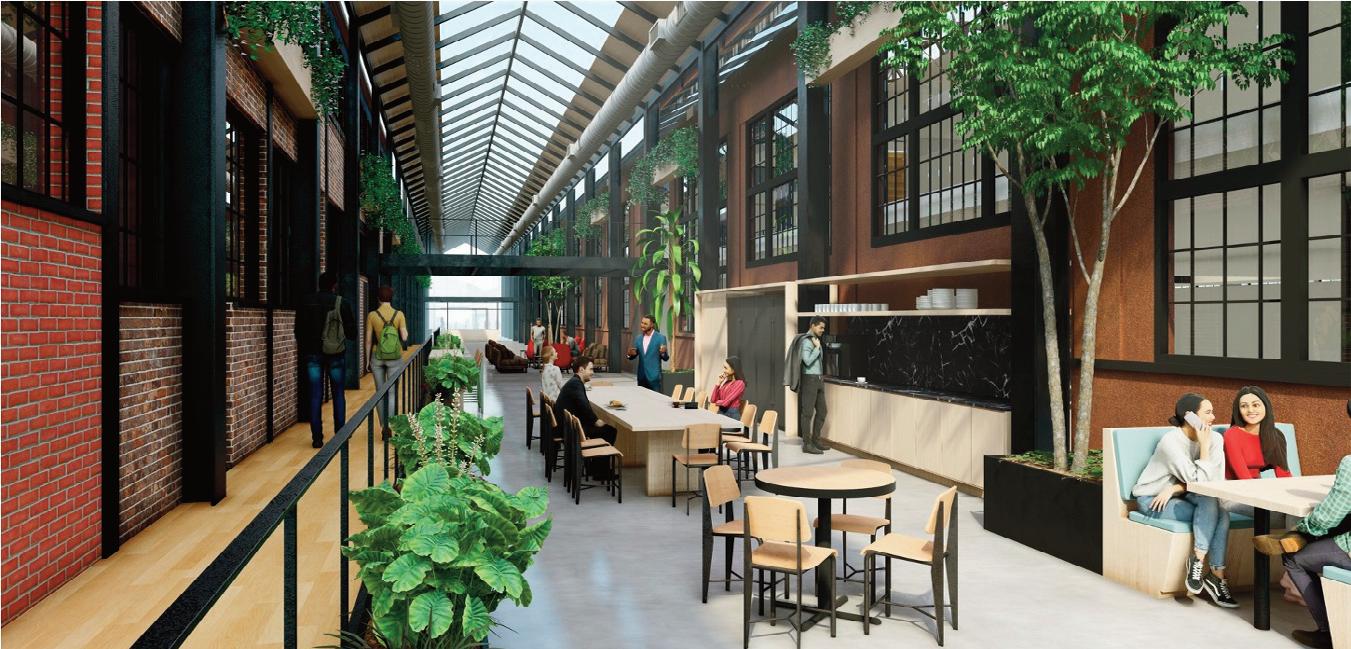
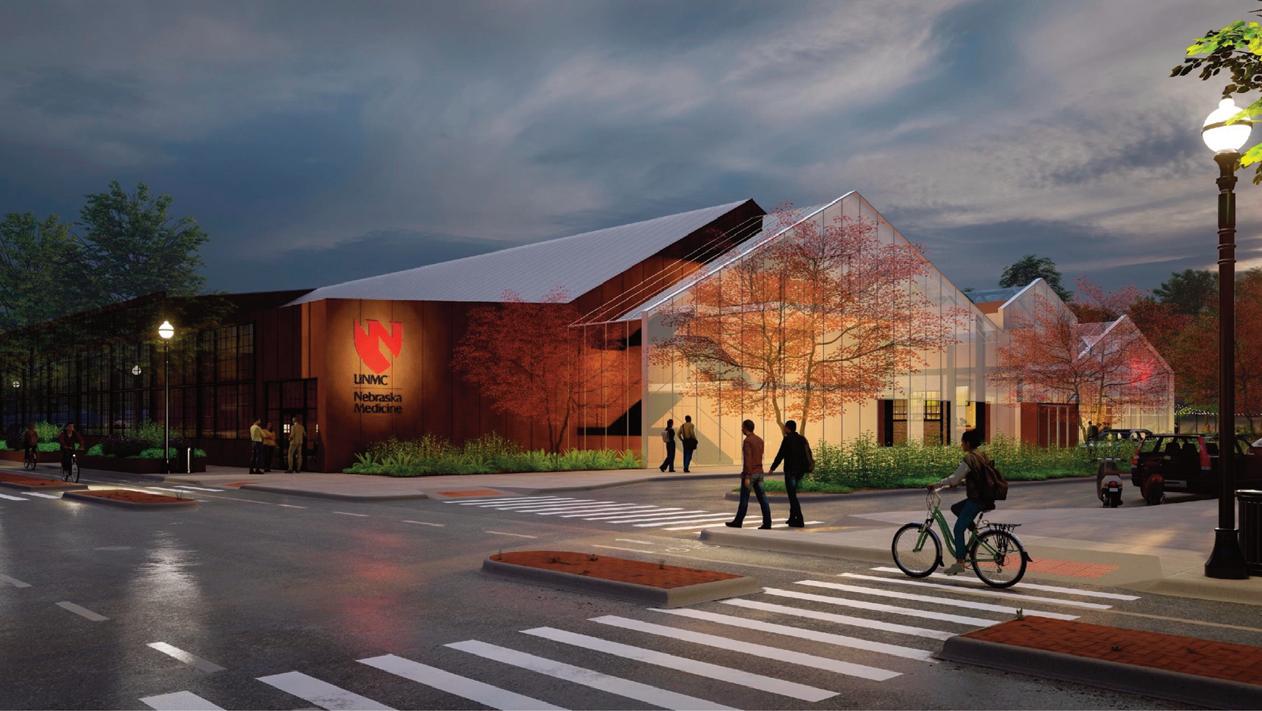
COntinueD • mmagazine UNIVERSITY OF NEBRASKA MEDICAL CENTER mmagazine • nOV/DeC 2022 36
AN ARTIST’S RENDERING SHOWS ONE PORTION OF THE INNOVATION HUB, WHICH COULD INCLUDE A FOOD HALL AND MARKET, EVENT CENTER AND COLLABORATIVE OFFICE SPACE.
AN ARTIST’S RENDERING OF UNMC’S PLAN TO RENOVATE AND REDEVELOP THE FORMER OMAHA STEEL WORKS PROPERTY INTO A MIXED-USE INNOVATION TECHNOLOGY CAMPUS. THE “INNOVATION HUB” WILL ENABLE RESEARCHERS TO TURN IDEAS INTO PRODUCTS THAT HELP IMPROVE HEALTH AND HEALTH CARE.
CONTINUED
speCial eDitiOn
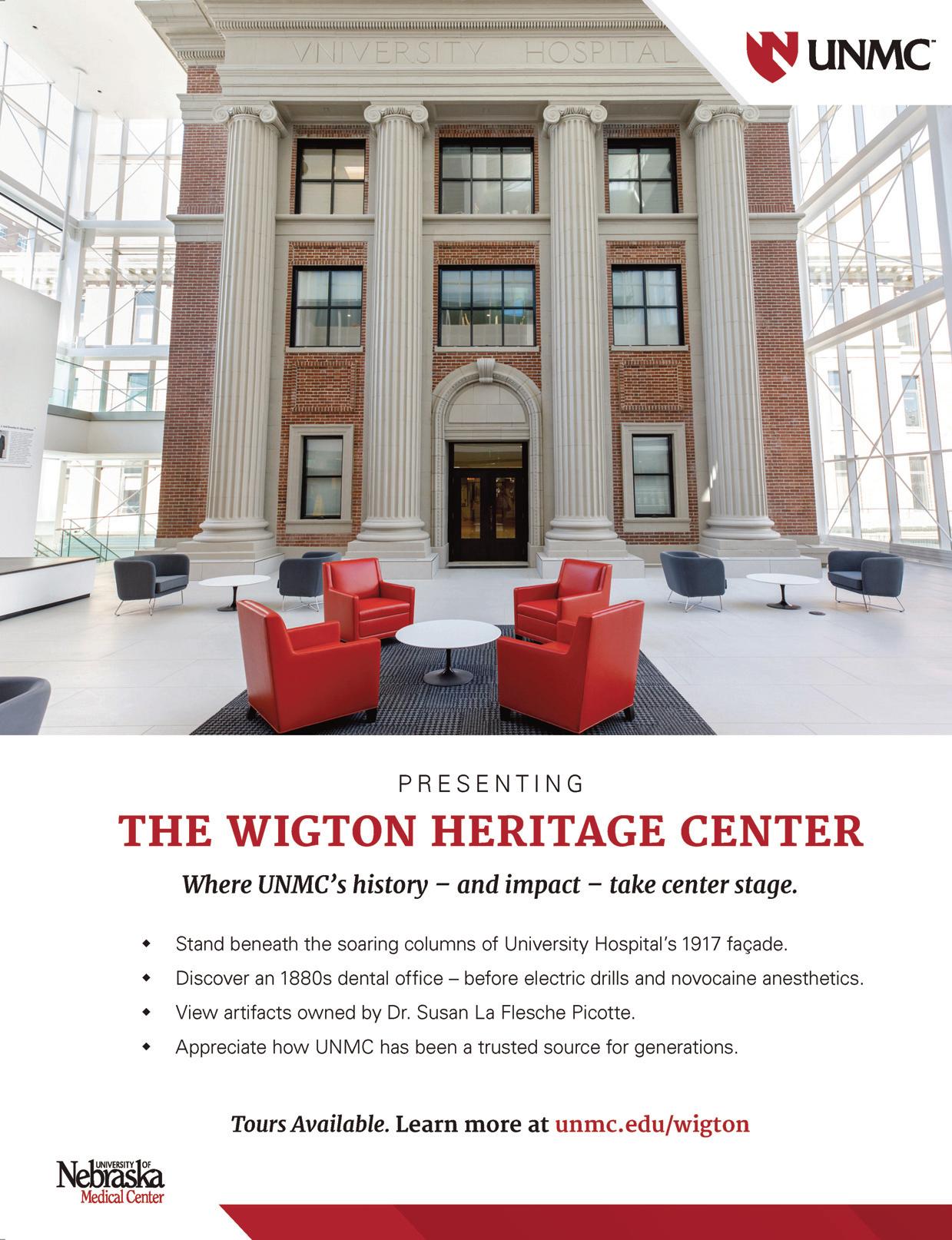
economic IMPACT
Barnes continued, "We have many people who already do that, but there is also business development and strategic advising to help them take those concepts all the way through to a start-up company. And some of that includes providing dedicated incubator research space for these small start-up companies, and that’s going to be something we will continue to build and grow and reap the reward of for many, many years.”
What’s NExT
UNMC has also announced the Project NExT initiative, a transformational publicprivate partnership to create a federal, all-hazard health security disaster response space that is adaptable and leverages the University of Nebraska Medical Center/Nebraska Medicine’s experience and global leadership in infectious diseases and biopreparedness to meet America’s current and future health care training,
education and capacity needs consistent with the federal government’s plan to launch urgent public health system improvements for now and the future.
This effort will improve the readiness of the nation’s civilian and military health system to partner in response to a catastrophic disaster such as another pandemic or a direct attack (see Global Center for Health Security page24). Through a multi-year project with the federal government led by the Department of Defense, Project NExT is designed to create a joint civilian-military medical surge facility through public-private partnerships. The facility will expand federal medical surge capability—the ability to care for a high volume of patients—and improve the National Disaster Medical System training run by the U.S. Department of Health and Human Services. The State of Nebraska has
already approved $300 million in funding to support Project NExT.
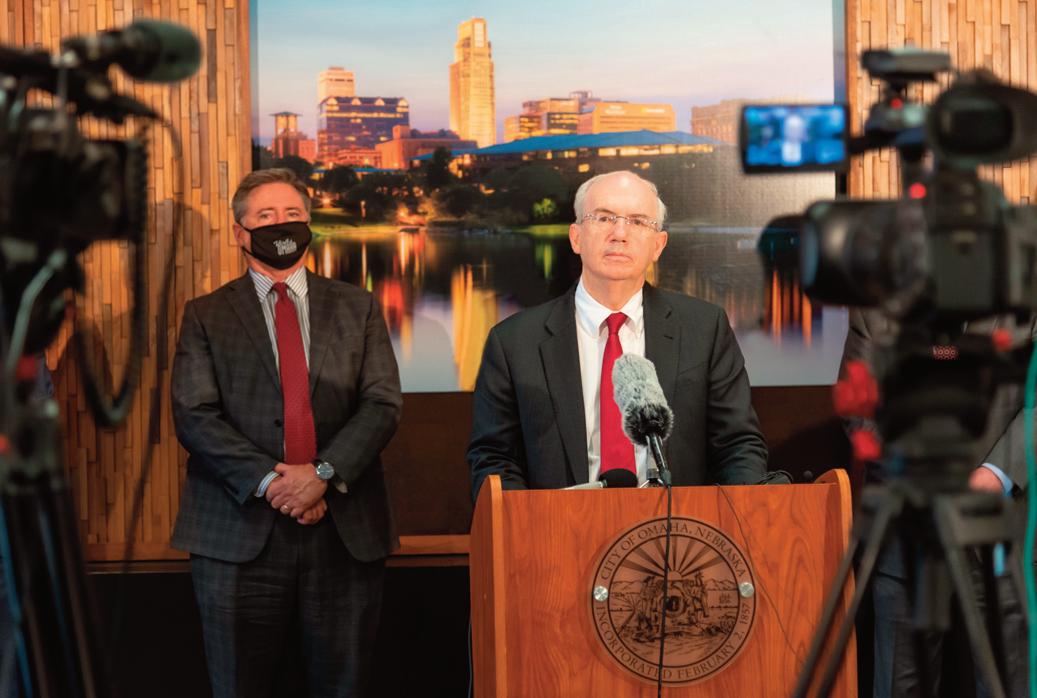
“The current estimates for Project NExT are that, by the time it is finished, it will add $1.9 to $2.3 billion in economic impact,” Gold said.
It will also provide an estimated 8,700 jobs, including federal workers from Health and Human Services, Homeland Security and the Department of Defense.
“There’s a huge amount of that workforce that will come from all across the country and likely around the world—people who will live here for three months, six months, 12 months, and then be rotated out after their training and experiential opportunities are finished,” he said. “Project NExT will produce new and ultramodern space for clinical care, for education and training,
COntinueD • mmagazine UNIVERSITY OF NEBRASKA MEDICAL CENTER mmagazine • nOV/DeC 2022 38
UNMC CHANCELLOR JEFFREY P. GOLD, M.D., DISCUSSES THE SIGNING OF A MEMORANDUM OF UNDERSTANDING WITH THE CITY OF OMAHA TO PROVIDE FINANCIAL SUPPORT FOR PROJECT NEXT. STEVE CURTISS, FINANCE DIRECTOR FOR THE CITY OF OMAHA, LOOKS ON.
CONTINUED speCial eDitiOn
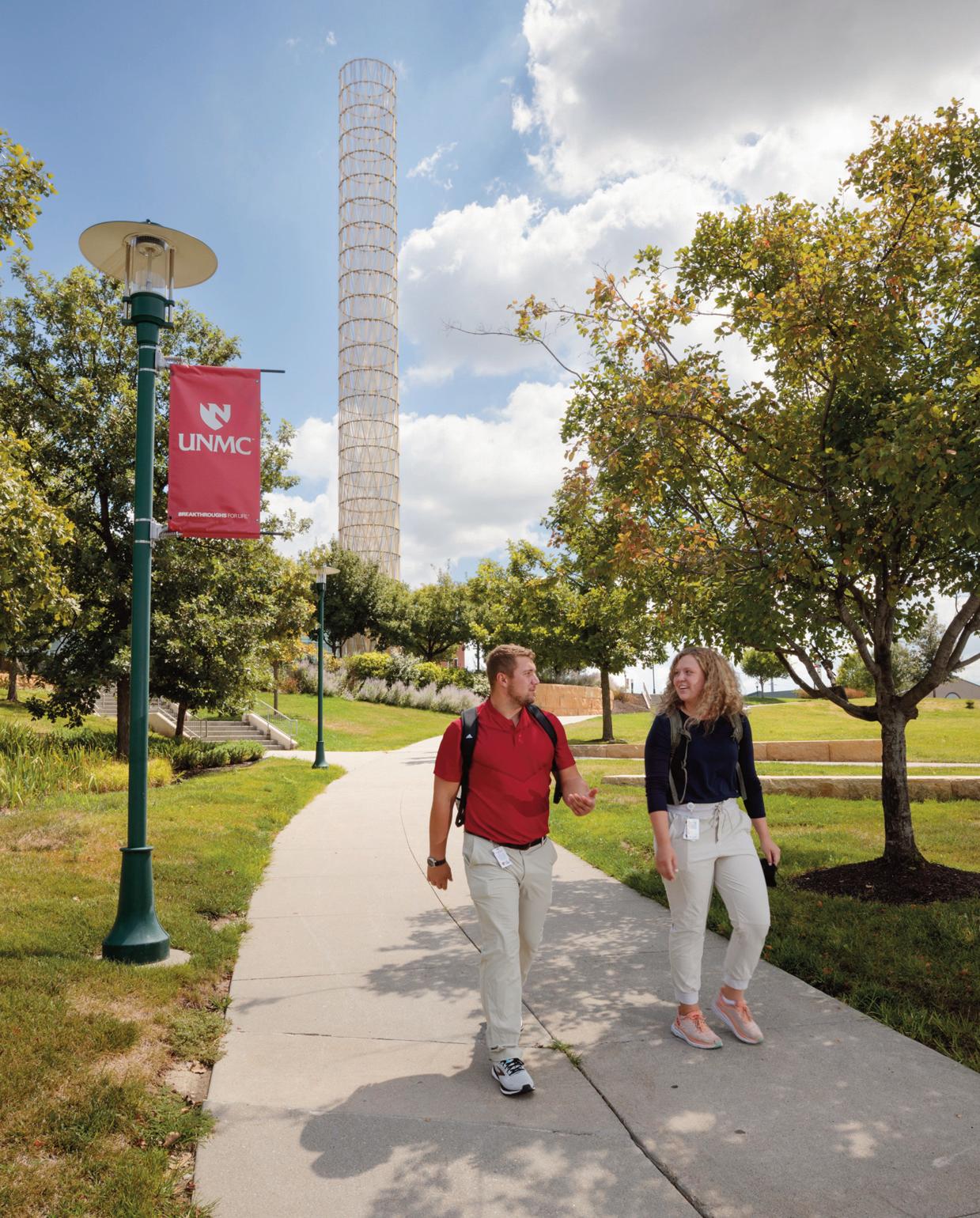
CONTINUED unmc innOVatiOn & leaDership
UNMC GRADUATES WORKING THROUGHOUT NEBRASKA – INCLUDING PHYSICIANS, DENTISTS AND OTHER HEALTH PROFESSIONALS – GENERATE AN ECONOMIC IMPACT OF $5.1 BILLION. (TRIPP UMBACH, FEBRUARY 2022)
for clinical research that the community depends upon us for. Indeed, we have more demand for clinical space than we have capacity for today, and we will be able to expand almost all our health professions education programs to enhance the rural and urban workforce if we have more and better clinical space.”
The development is being met with enthusiasm locally.
“Having lived in the Blackstone neighborhood for over 30 years, I have had a front-row seat to three decades of change. Our neighborhood has always enjoyed a special relationship with UNMC; now as more and more residents are employees of UNMC, even more so,” Blackstone Neighborhood Association President Mark A. Maser said. “The growth we have seen, especially in the last 10 years, has improved the quality of residential life in our area. Whether you consider infrastructure, amenities or property values,
economic
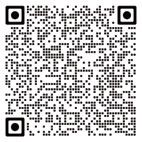
UNMC IS A major dRIvER of excellence IN THIS AREA.

~ bRyAN SloNE, presiDent, nebraska Chamber Of COmmerCe & inDustry
it is undeniable that UNMC’s impact is strong and positive.”

“Nebraska’s nationally recognized health care community is critical to maintaining Nebraska’s unique quality of life,” said Bryan Slone, president of Nebraska Chamber of Commerce & Industry. “UNMC is a major driver of excellence in this area. Its commitment to recruiting and educating the next generation of health care workers is unwavering and essential. Additionally, UNMC researchers are relentless in their pursuit of innovative diagnostic and treatment technology that is nationally and globally recognized. And within the state, UNMC’s operations have a remarkable positive impact on Nebraska’s economy and economic competitiveness. The ‘Good Life’ is calling and UNMC is a big part of what makes Nebraska great.”
Barnes was born in Kansas and launched her career in Oklahoma after attending college there. She’s not new to the
Midwest but she’s a new Nebraska resident, having started her UNMC role on June 1, 2022.
“I was wildly impressed with the degree of partnership between UNMC and Nebraska Medicine. It’s a mature relationship,” she said, adding that the institution’s innovation also influenced her decision to relocate here. “Typically, in academic medicine, you hear about things on the East or West Coast, and that’s where people look for that national prominence. But I was really impressed by the fact that UNMC is a national leader in a number of areas. It was that enthusiasm, that drive and ambition… So far, everything I’ve seen continues to impress me.”
COntinueD • mmagazine UNIVERSITY OF NEBRASKA MEDICAL CENTER mmagazine • nOV/DeC 2022 40
IMPACT
UNMC/NEBRASKA MEDICINE DIRECTLY AND INDIRECTLY GENERATES $5.9 BILLION PER YEAR IN NEBRASKA CREATES AND SUPPORTS MORE THAN 56,000 JOBS GENERATES $220.2 MILLION PER YEAR IN TAX REVENUE
WHETHER yoU CoNSIdER infrastructure, AMENITIES oR pRopERTy vAlUES, IT IS undeniable THAT UNMC’S impact IS STRoNg ANd positive. IN NEXT SECTION: collaborative spirit SCAN THIS QR CODE TO LEARN MORE! speCial eDitiOn
~ MARK A. MASER, presiDent, blaCkstOne neighbOrhOOD assOCiatiOn
FOR 50 YEARS, UNMC’S COLLEGE OF ALLIED HEALTH PROFESSIONS HAS TRAINED ALLIED HEALTH PROFESSIONALS, WHICH COMPRISE APPROXIMATELY 60% OF THE TOTAL HEALTH CARE WORKFORCE.


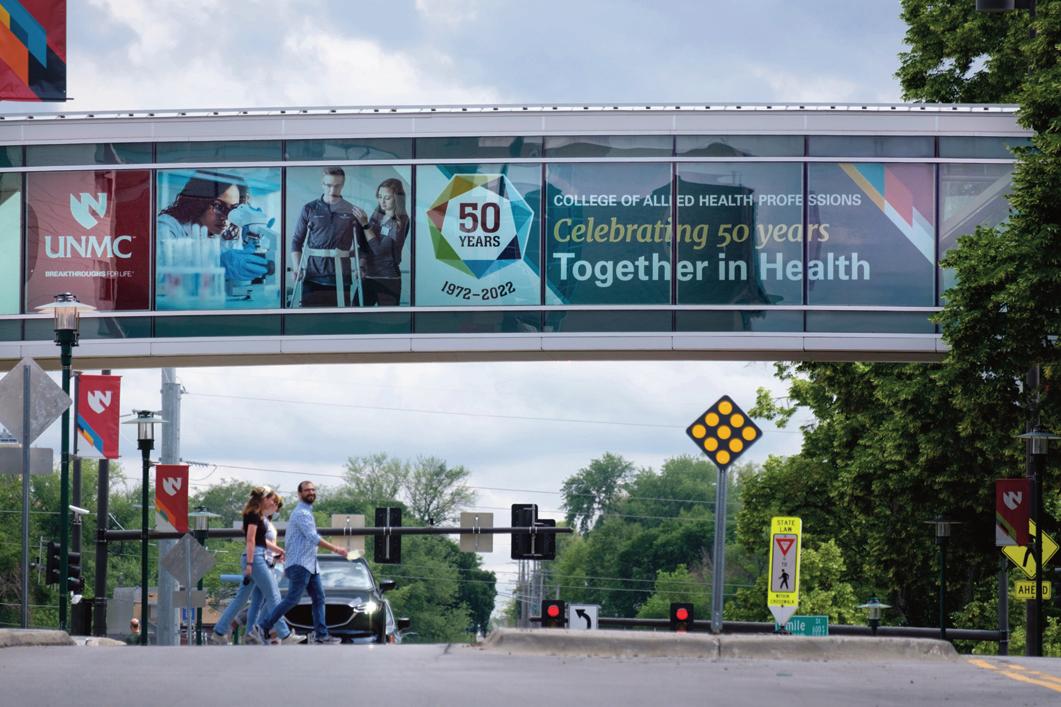
training allied health professionals FOR 50 YEARS
When individuals seek health care, those providing it are likely allied health professionals: physician assistants, physical therapists, radiation therapists and many others. In Nebraska, the University of Nebraska Medical Center College of Allied Health Professions has been training the state’s allied health workforce for 50 years. When it was created in 1972 by the University of Nebraska Board of Regents, the then-School of Allied Health Professions offered education in only three health professions.
Today, the UNMC College of Allied Health Professions offers education in 15 health professions, with degrees that range from bachelor’s and master’s to clinical doctorates. New programs added just in the past few years include genetic counseling, occupational therapy and respiratory therapy.
It is estimated that allied health professionals make up as much as 60% of the U.S. health care workforce, said UNMC College of Allied Health Professions Dean Kyle Meyer, Ph.D. The allied health professions add significantly to the nation’s health care infrastructure, increasing access, delivering highquality care and helping lower the cost of care.
Meyer points to two groups of allied health professionals: those engaged in diagnosis and treatment, such as physician assistants, medical nutritionists and physical and occupational therapists; and those who operate sophisticated
medical equipment to derive information that informs the diagnostic and treatment process, such as radiographers, medical laboratory scientists, sonographers and MRI technologists.
Allied health professions are in high demand across the state, region and country. The historical growth of the allied health professions, Meyer said, is due not only to advances in knowledge and technology, but also in reaction to societal need.
“Radiography began with the discovery of X-rays, and physical and occupational therapy evolved in response to the rehabilitation needs of injured World War I veterans and victims of the early polio epidemics,” he said. “Clinical perfusion began with advances in cardiac surgery and the introduction of the heart-lung machine, and the physician assistant profession emerged in the mid-1960s in response to the shortage of primary care physicians.”
He added, “If the past is any predictor of the future, it’s likely that over the next 50 years the college will add professions that don’t even exist today. As health care has advanced, our professions and our college have advanced with it. We’ve equipped allied health professionals to improve the health and quality of life in Nebraska, the country and the world for 50 years, and UNMC looks forward to continuing that mission for the next 50.”
unmc innOVatiOn & leaDership
UNMC’s strength is rooted in collaboration, bold ideas and knowing that success comes with commitment, careful strategy and a can-do attitude.


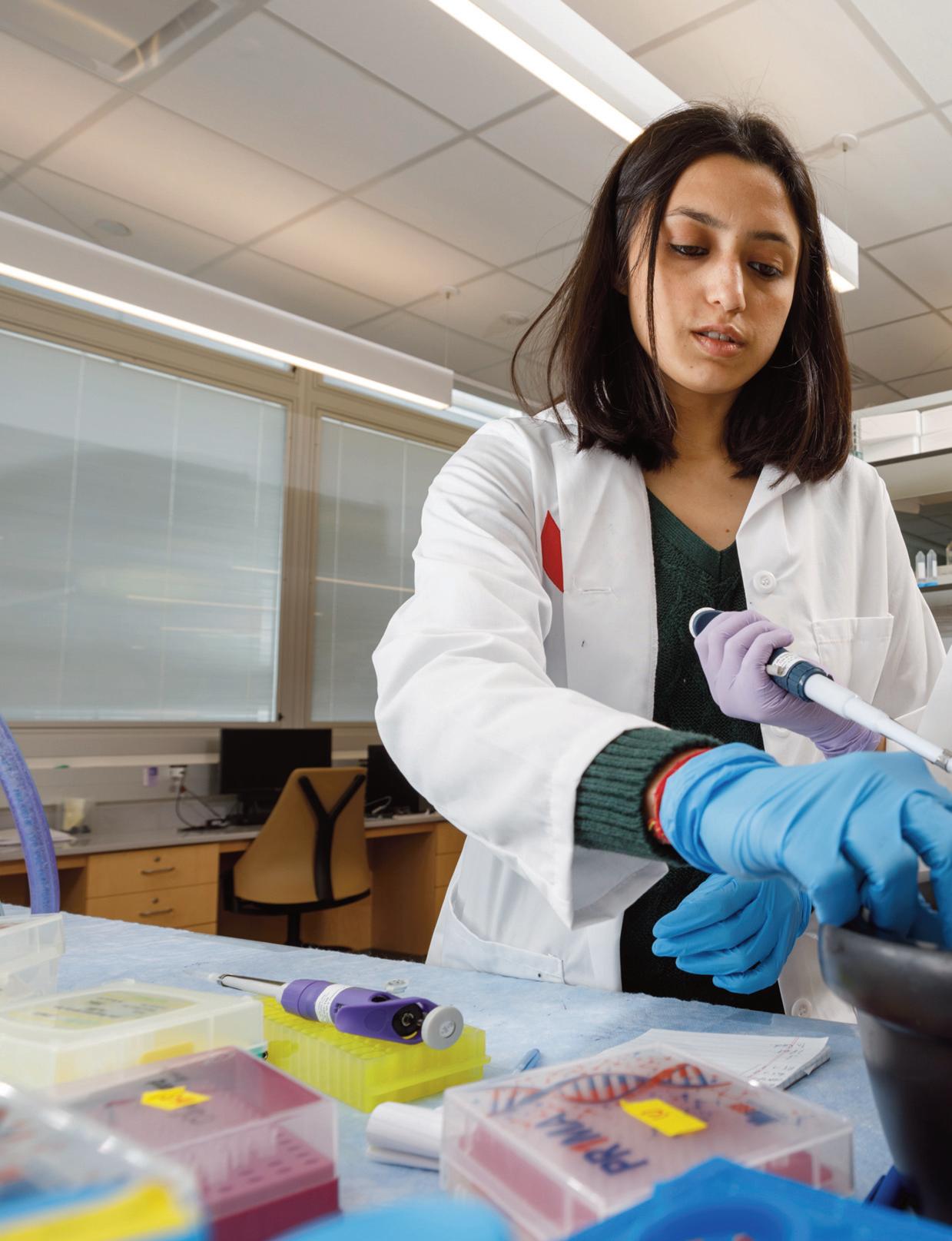
UNIVERSITY OF NEBRASKA MEDICAL CENTER collaborative mmagazine • nOV/DeC 2022 42 speCial eDitiOn
WORKING TOGETHER
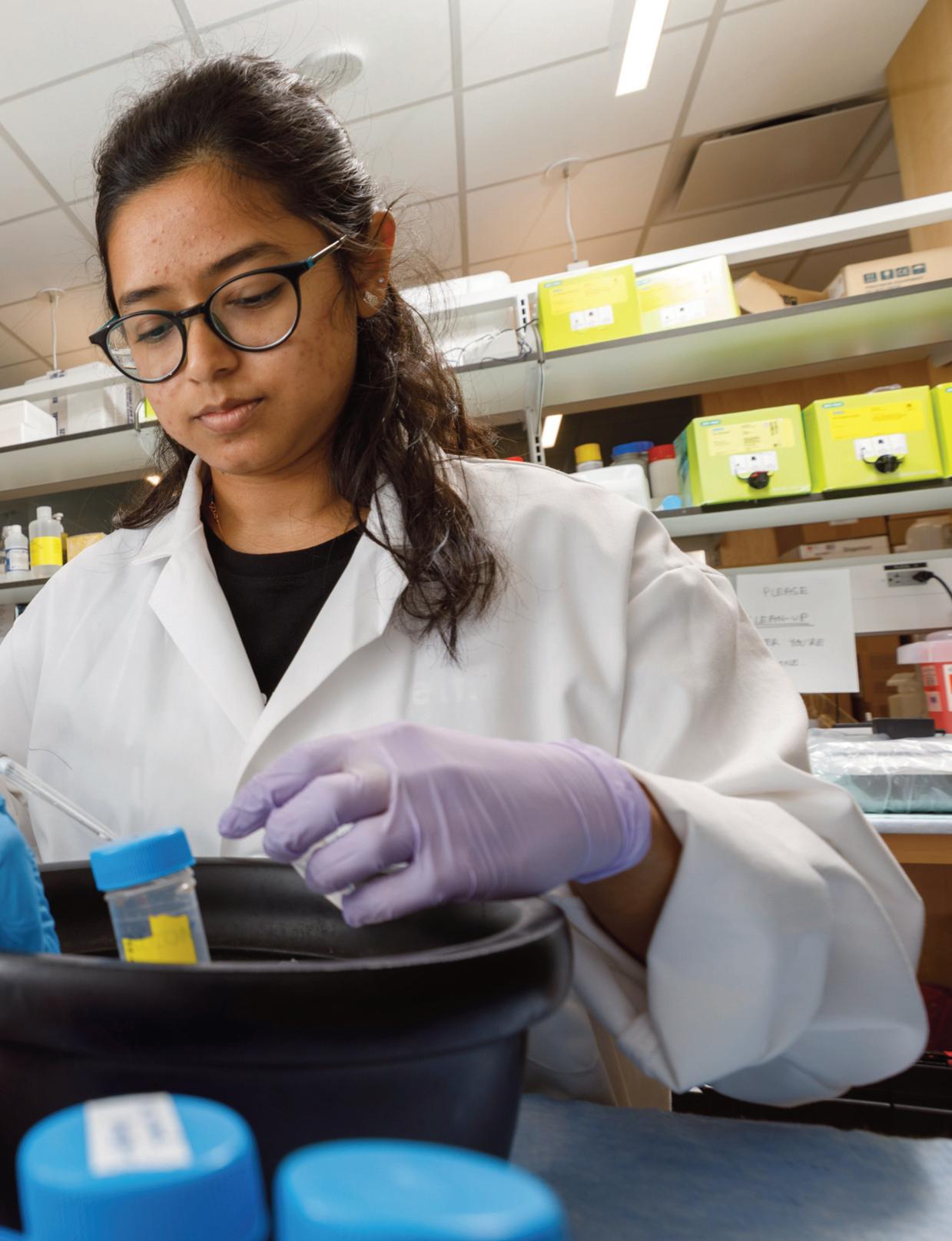
unmc innOVatiOn & leaDership
• mmagazine
spirit
UNMC’S CHANCELLOR, JEFFREY P. GOLD, M.D., IS A NEW YORK NATIVE WHO’S HAD MEDICAL LEADERSHIP ROLES AT INSTITUTIONS ALL OVER THE COUNTRY. HE HAS BEEN A NEBRASKAN BY CHOICE FOR NEARLY A DECADE.
“This is one of the most caring environments that I have ever been privileged to play a small role in,” he said. “The people who make up UNMC—the people who support the institution down to the most detailed essentials like food services and environmental services—these are people who really care.”
Gold said that a high level of caring can be assessed by answering an easy question.
“If that was your child in the emergency room or your parent going to surgery, or your significant other needing an outpatient visit, how would you want them treated?” he said. “If that’s the quality of care you deliver every day, that’s great.”
On a larger scale, UNMC as an institution embodies a remarkable collaborative spirit, Gold said.
“Collaboration, partnerships and relationships are the name of the game. We are only made stronger by the relationships we have with the public sector, meaning state and local governments; by relationships with other campuses and other universities across the country and around the world; and frankly, by the private sector, by large and small businesses; and by the philanthropic community,” he said.
“We have been very successful for a long time, long preceding my tenure here, in building those relationships.”
Community support
UNMC enjoys tremendous support from the community, which has led to
collaborative SPIRIT
impressive public-private partnerships for such projects as the Munroe-Meyer Institute, which supports individuals with disabilities and special health care needs, the Fred & Pamela Buffett Cancer Center, and the Dr. Edwin G. & Dorothy Balbach Davis Global Center (see iEXCEL page 5), to name a few.
“These are public-private partnerships that were all incredibly successful,” Gold said.
UNMC has a reputation of providing good stewardship, Gold said, and meeting high expectations with its partnerships.

“I would characterize them as trusted relationships because people are willing to partner if they believe they are entering into a win-win situation where we are going to overdeliver on schedule and on budget, which has really been the theme of every one of the partnerships that we have created,” he said. “So, when we work with the private or philanthropic community, we are very careful to steward every last dollar of the investment with us. I don’t refer to it as a gift or as a charitable donation. I refer to it as an investment.”

UNMC’s collaborative spirit is accompanied by a can-do attitude and ability to think big, Gold said, but it’s also tempered by careful strategy.
“A day doesn’t go by that there aren’t opportunities. And yet, we can’t be everything to everyone; we have to prioritize. So, we have to be in a magical combination of both strategic and opportunistic, which means that from time to time we say, ‘No, we can’t do that’ or ‘We can’t do it now,’” he said. “We have to be able to prioritize and be strategic in where we are trying to go, which is why we are such a mission-driven, strategic organization. We have a strategic plan that is extremely robust and very carefully
written and indeed defines what we are trying to do. It has eight major areas we are trying to focus on. We of course focus on education, research and clinical care. But the other five areas are important to us as well, and include diversity and inclusion, economic development, community relations, the culture of our UNMC and Nebraska Medicine family, and leadership development.”
Under one roof
Kenneth H. Cowan, M.D., Ph.D., director and physician-in-chief of the Fred & Pamela Buffett Cancer Center, said the cancer center is a tangible manifestation of UNMC’s collaborative spirit. The new Pancreatic Cancer Center of Excellence (see Pancreatic Cancer Center page 48) is another “tremendous public-private partnership” that addresses one of the most challenging cancers to treat successfully.
“The (Fred & Pamela Buffett Cancer Center) we opened five years ago was the first facility on our campus of UNMC and Nebraska Medicine that literally integrated clinical and research under one roof,” he said.
Patients find everything they need for their care in one building, from medical practitioners such as oncologists, radiologists and nutritionists to support service providers such as financial counselors and social workers.
“It also allows our cancer research team to work side by side with our clinical care team to better understand and address challenges in making a diagnosis or finding a therapy for a cancer patient,” Cowan said.
“Collaboration between researchers and the clinical care team also translates into development of clinical trials in a shorter period of time.”
mmagazine • nOV/DeC 2022 44
UNIVERSITY OF NEBRASKA MEDICAL CENTER speCial eDitiOn
working together WITH THE COMMUNITY


CONTINUED
& leaDership • mmagazine
unmc innOVatiOn
A UNMC STUDENT DELIVERS COVID-19 VACCINATIONS AT A CLINIC SET UP IN CLAIR MEMORIAL UNITED METHODIST CHURCH IN NORTH OMAHA.
THE ANNUAL WALK & ROLL FOR DISABILITIES IS A SOCIAL GATHERING FOR THE ADULT DISABILITY COMMUNITY AND A POPULAR FUNDRAISING EVENT FOR THE MUNROE-MEYER INSTITUTE’S RECREATIONAL THERAPY PROGRAM.
collaborative SPIRIT
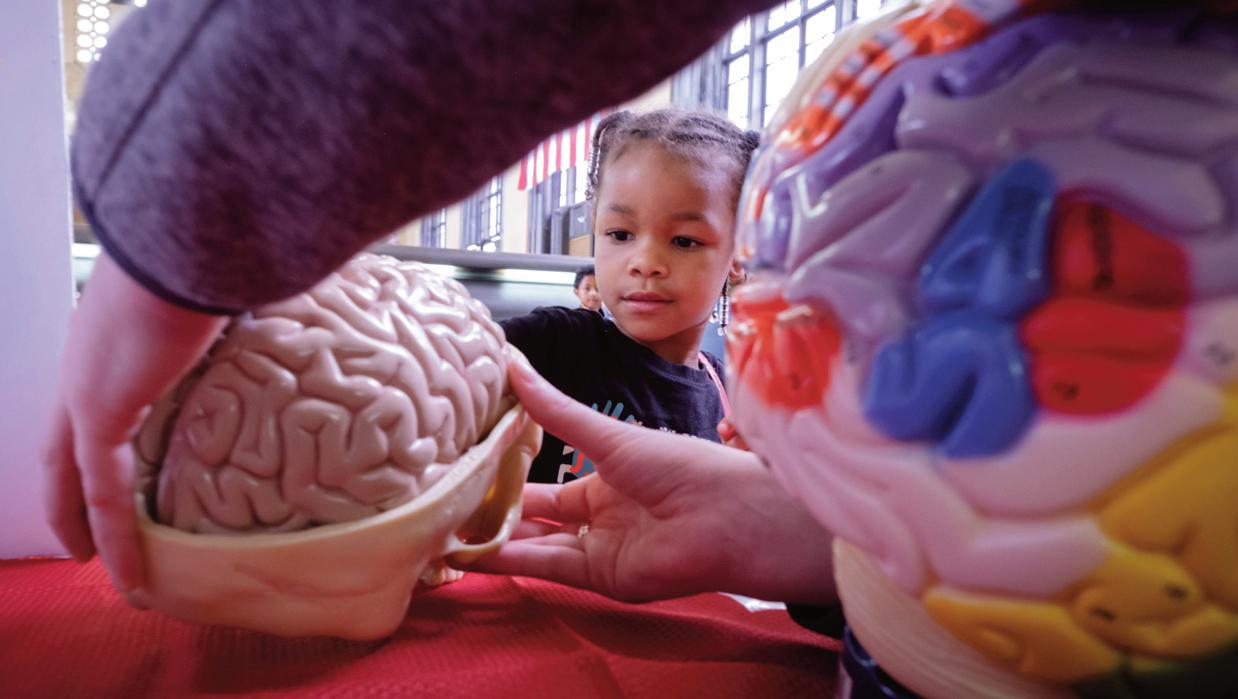

COntinueD • mmagazine UNIVERSITY OF NEBRASKA MEDICAL CENTER mmagazine • nOV/DeC 2022 46
PRESENTED BY UNMC, THE ANNUAL NEBRASKA SCIENCE FESTIVAL ALLOWS PARTICIPANTS TO DISCOVER THE IMPORTANCE OF SCIENCE THROUGH A MYRIAD OF SCIENCE- AND TECHNOLOGY-RELATED ACTIVITIES.
CONTINUED
UNMC COLLEGE OF MEDICINE STUDENTS SHOW OFF THEIR EMAILS FROM THE NATIONAL RESIDENT MATCH PROGRAM, INDICATING WHERE THEY WILL TRAIN THE NEXT THREE TO SEVEN YEARS IN THE MEDICAL AREA OF THEIR CHOICE.
speCial eDitiOn
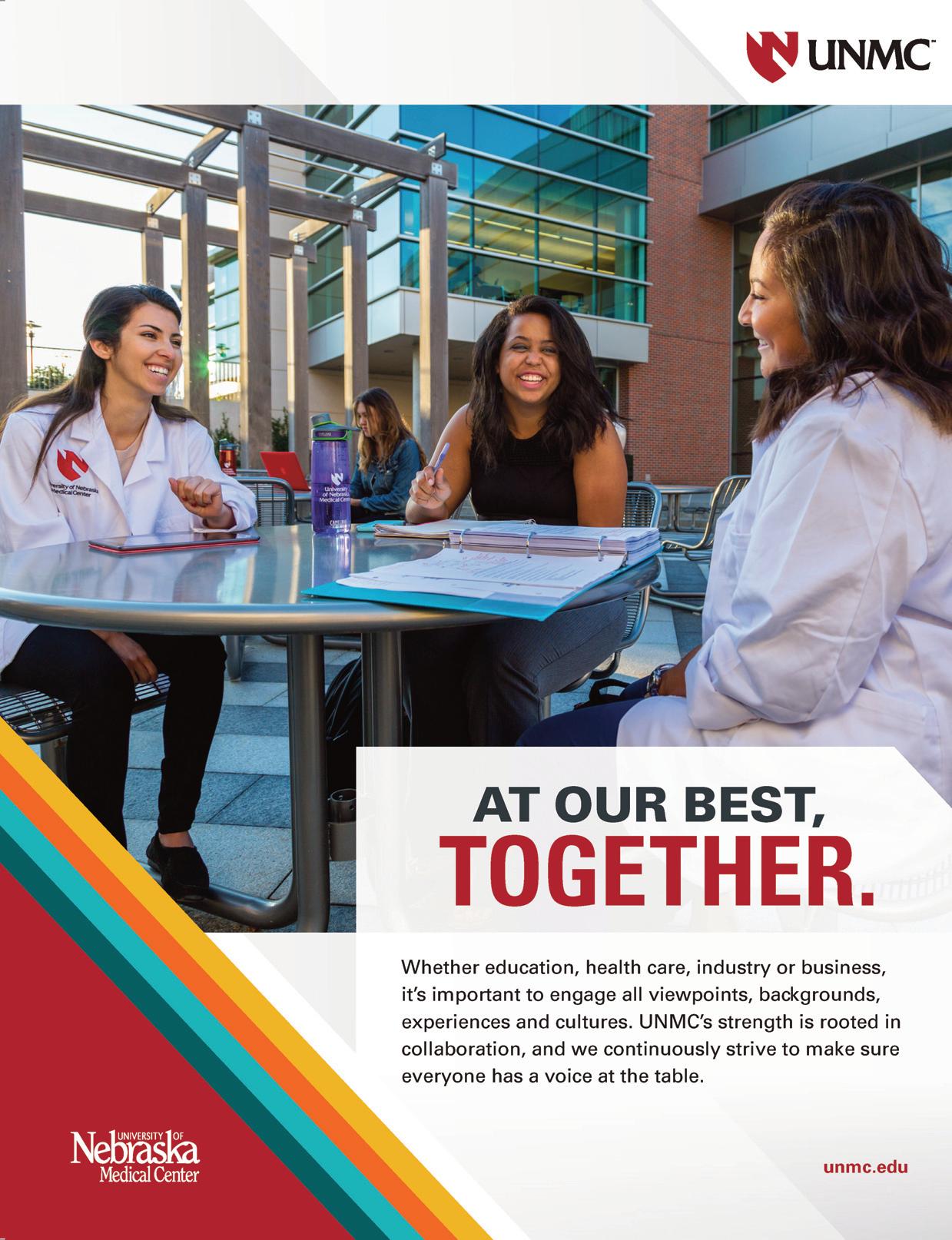
collaborative SPIRIT

The cancer center not only treats patients from all over the globe, it serves as a training ground for practitioners across the state.
tackling pancreatic cancer ON ALL FRONTS
Pancreatic cancer is the fourth-leading cause of cancer deaths in Nebraska. Now, thanks to state lawmakers and philanthropists, UNMC and Nebraska Medicine physicians and scientists have additional resources to aggressively pursue the development and testing of therapies for pancreatic cancer.
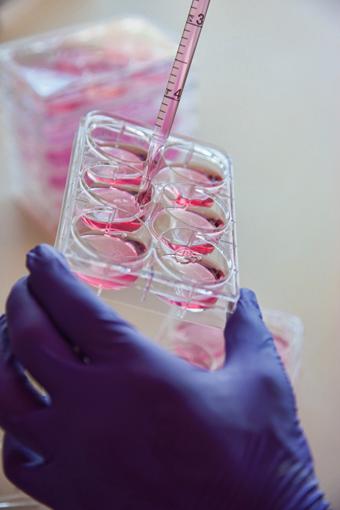
Earlier this year, the UNMC Pancreatic Cancer Center of Excellence received $15 million in one-time funding from the Nebraska Legislature, which will be matched by $15 million in philanthropic support. Already, UNMC receives about $8 million in grant funding annually for pancreatic cancer research.
Led by Sunil Hingorani, M.D., Ph.D., the center will provide new resources for medical center scientists and physicians to aggressively pursue breakthroughs in screenings and therapies for pancreatic cancer.
“This is a unique time in pancreas cancer research and clinical care, as the field as a whole has developed a much deeper understanding of the many ways in which this disease evades our ability to detect and diagnose it, and of how it resists virtually every form of chemical and radiotherapy we throw at it,” Hingorani said. “The timing could not be more perfect to capitalize on our new understanding of the disease through this extraordinary commitment and show of faith by the University of Nebraska, Nebraska Medicine, the State of Nebraska, the Fred & Pamela Buffett Cancer Center and numerous highly motivated individuals.”
A highly accomplished and internationally recognized pancreatic cancer researcher and clinician, Hingorani is the inaugural Nancy Armitage Pancreas Cancer Clinical Research Presidential Chair and the first director of the Pancreatic Cancer Center of Excellence at UNMC.
“We do a lot of telehealth and a lot of consultations with oncologists across the state to make sure that everybody has access to the same quality of care we have here,” Cowan said. “We’ve worked with hospitals in Scottsbluff, Grand Island, North Platte, Lincoln, Hastings and Norfolk to make trials available through their own cancer facilities, physicians’ offices and hospitals. So, patients can be enrolled without ever coming here but have access to the same treatments we’re offering here, to some extent.”
All these factors mean outstanding quality of care for patients, Cowan said.
“It’s helped us create a culture where everybody understands—from the clinic to the research to the students to the faculty to the staff—that we’re all in this together as one big cancer center team,” he said. “It’s enabled us to integrate the different parts of care and research for the benefit of patients, and that paves the way for new facilities down the road.”
UNIVERSITY OF NEBRASKA MEDICAL CENTER mmagazine • nOV/DeC 2022 48
~ jEffREy p. gold,
M.
d., ChanCellOr, unmC
speCial eDitiOn
CollAboRATIoN, partnerships ANd relationships ARE THE name of THE game.
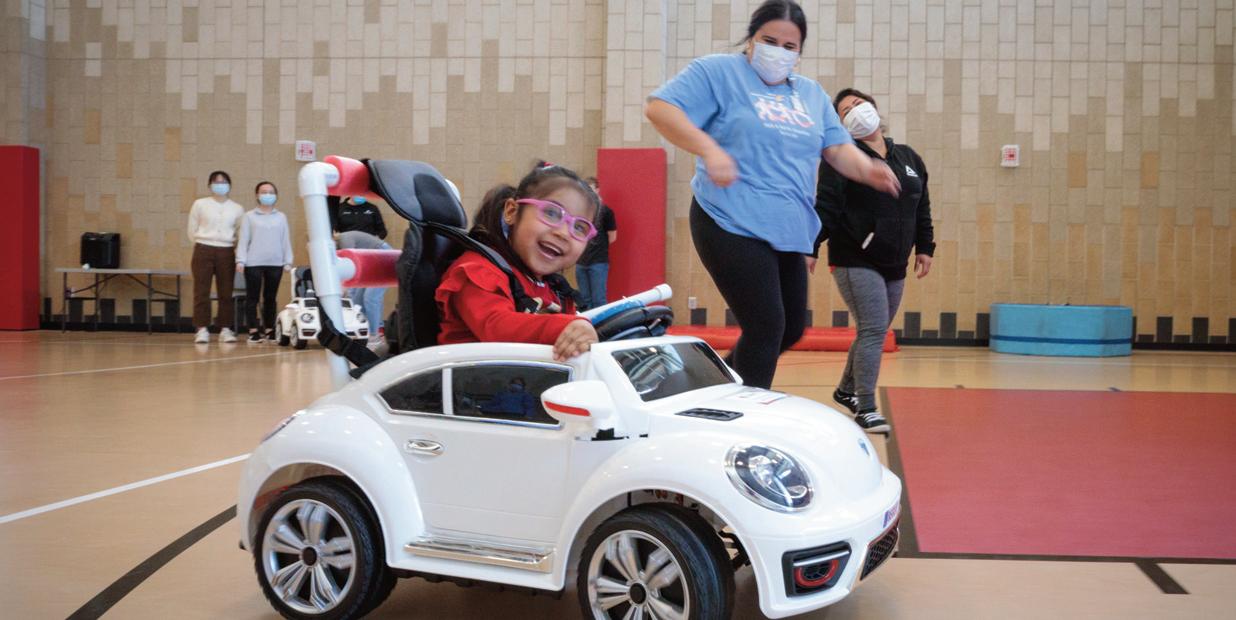
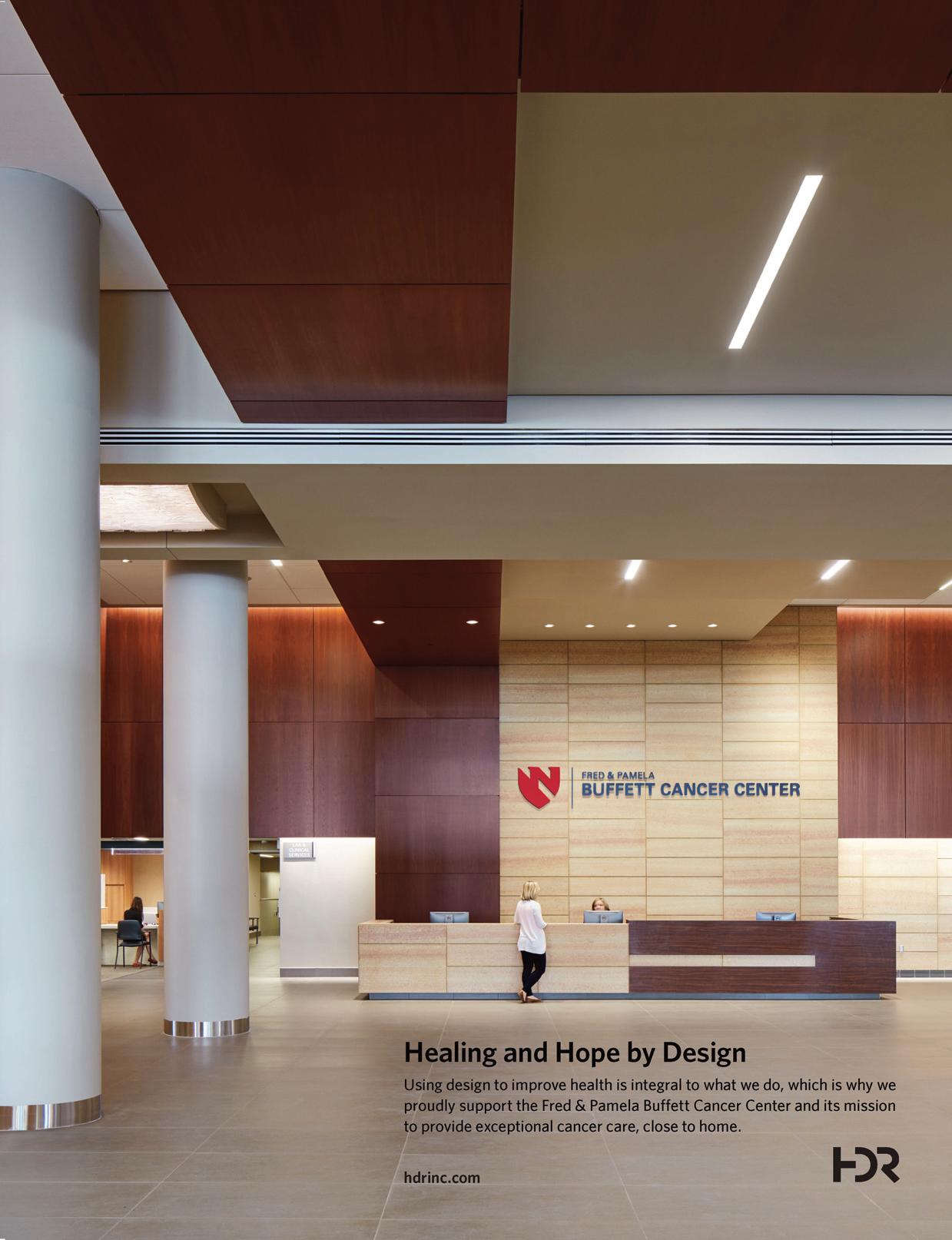
UNMC innovation • leadership


Inside the Chihuly Sanctuary, the defining colors – and serene environment – offer a place of respite and reflection for patients, researchers and caregivers. The sanctuary, located in the Fred & Pamela Buffett Cancer Center, is the cornerstone of the medical center’s Healing Arts Program, which connects people with the power of art to transform the health care experience.
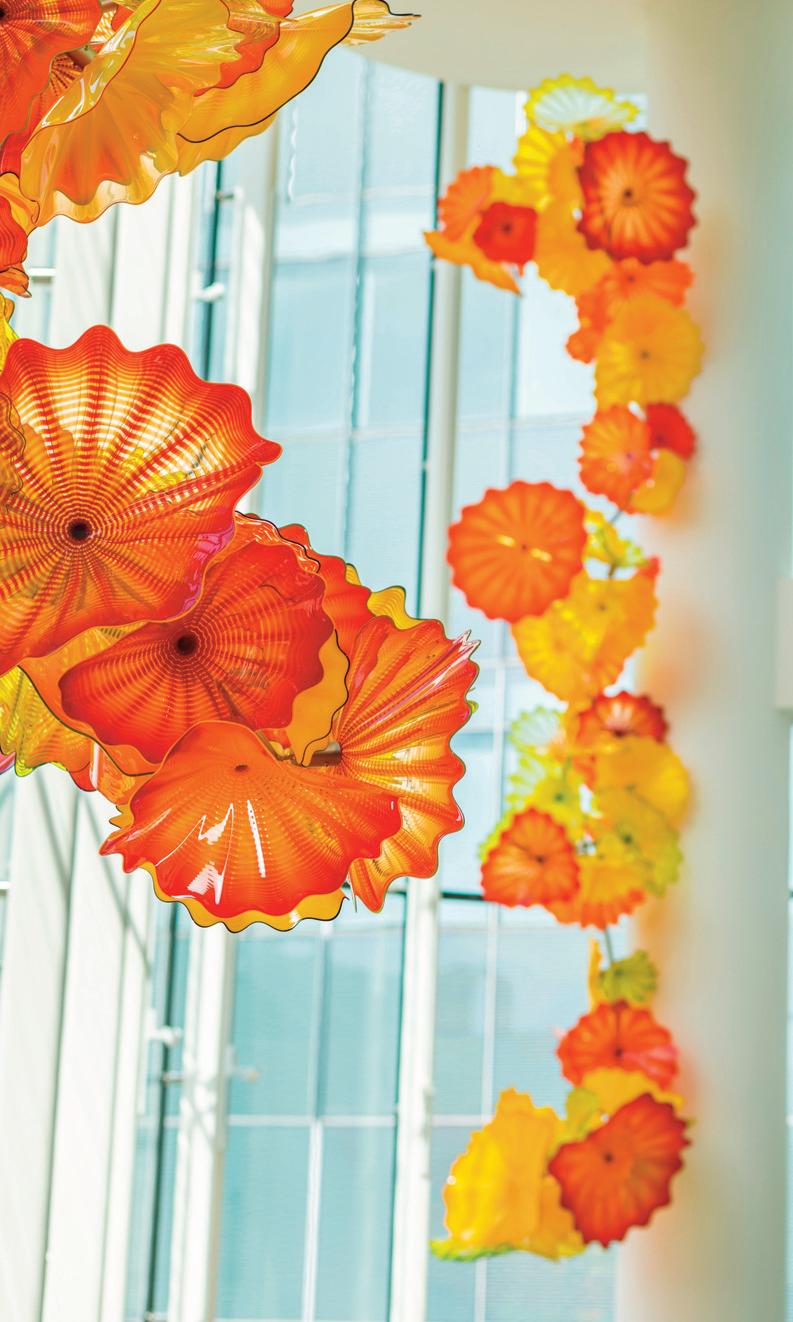
mmagazine • nOV/DeC 2022 50 UNIVERSITY OF NEBRASKA MEDICAL CENTER
speCial eDitiOn






Help us determine future “Women who WOW!” Nominate a friend, mentor, co-worker, boss, or other important woman using this easy online form: SCAN QR CODE to be redirected… presents Women Who WOW is sponsored by what else is possible? CHARITY EVENTS PREVIEW issue of something NEW! something DIFFERENT! Email CONNECT@SpiritofOmaha.com Subject: Charity Preview 2023! SCAN THIS QR CODE to find out! Register your charity event for FREE ... Be a part of the all NEW January/February 2023…
generational MYTHS: gen X
Today’s offices potentially span five generations ranging from the Silent Generation to Generation Z. A co-worker could just as easily have been raised with a smartphone in hand as have used a manual typewriter at their first job. Some see differences between generational colleagues as an annoyance (“kids these days!”) or rely on generational stereotypes as fact. Current research, however, questions the validity of generational stereotypes This series uncovers top generational myths as a strategy to support a diverse and healthy employee population
Today, we analyze the smallest generational group, born between 1965 and 1980: Generation X.
The top three myths of Gen X include:
Myth 1: Gen Xers are risk-takers. Some believe that this group is characterized as being reactionary and rebellious. In fact, Generation X keeps a much lower profile at work This group was called“the forgotten generation”by Pew Research.Why? Because they are a smaller group smashed in between two larger generations (Millennials and Baby Boomers). Additionally, they are the generation least likely to be promoted at work. A 2018 Harvard Business Review study concluded that Millennials and Baby Boomers had received two or more promotions in the same period that 66% of Gen X received one or less. Gen X was raised hearing their parents complain about work-life balance Truth is, they are the group most likely to be helping their children and parents in addition to work This group is a reliable bunch who values loyalty.
Myth 2: Gen Xers have a hard time relating to other generations in the workplace. While some say that Gen X alienates other generations, this couldn’t be further from the truth. Nielsen research called Generation X the“most connected”generation.Technology adaption
played a huge role in their ability to bridge the generations above and below them. Most were not introduced to technology until adulthood. This lack of computer access in their youth helps them relate to boomers in the office. At the same time, they share an excitement for technology with Millennials and lined up alongside them to get their first iPhones. Generation X are natural collaborators and often play the role of connector in the office.
mary drueke-collins
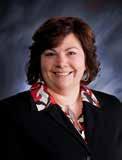
Myth 3: Gen Xers’ pessimism hurts them in the workplace. Gen X has worked through several hefty recessions and watched their retirement accounts take devastating hits. Experian reports that Generation X carries more debt than other groups and data from the National Association of Realtors showed this generation more likely to be declined for homeowner loans. So, can you blame them for being cynical? However, a closer look uncovers a different story in the way this shows up at work. Generation X is savvy because of these hardships and surprisingly content. In fact, a Better Hire survey concluded that more than 50% of Generation X participants are happy at work. They show up with an entrepreneurial spirit, owning their own destiny.

In sum, Gen X values stability rather than risk in the workplace. They play an important connector role at work with colleagues and at home with their families. Gen X has “been there, done that”and uses these lessons to make work enjoyable. They are an important piece in the generational puzzle.
For more information, please contact your trusted advisor at Swartzbaugh-Farber – ‘Client Centered – Client Advocates™’
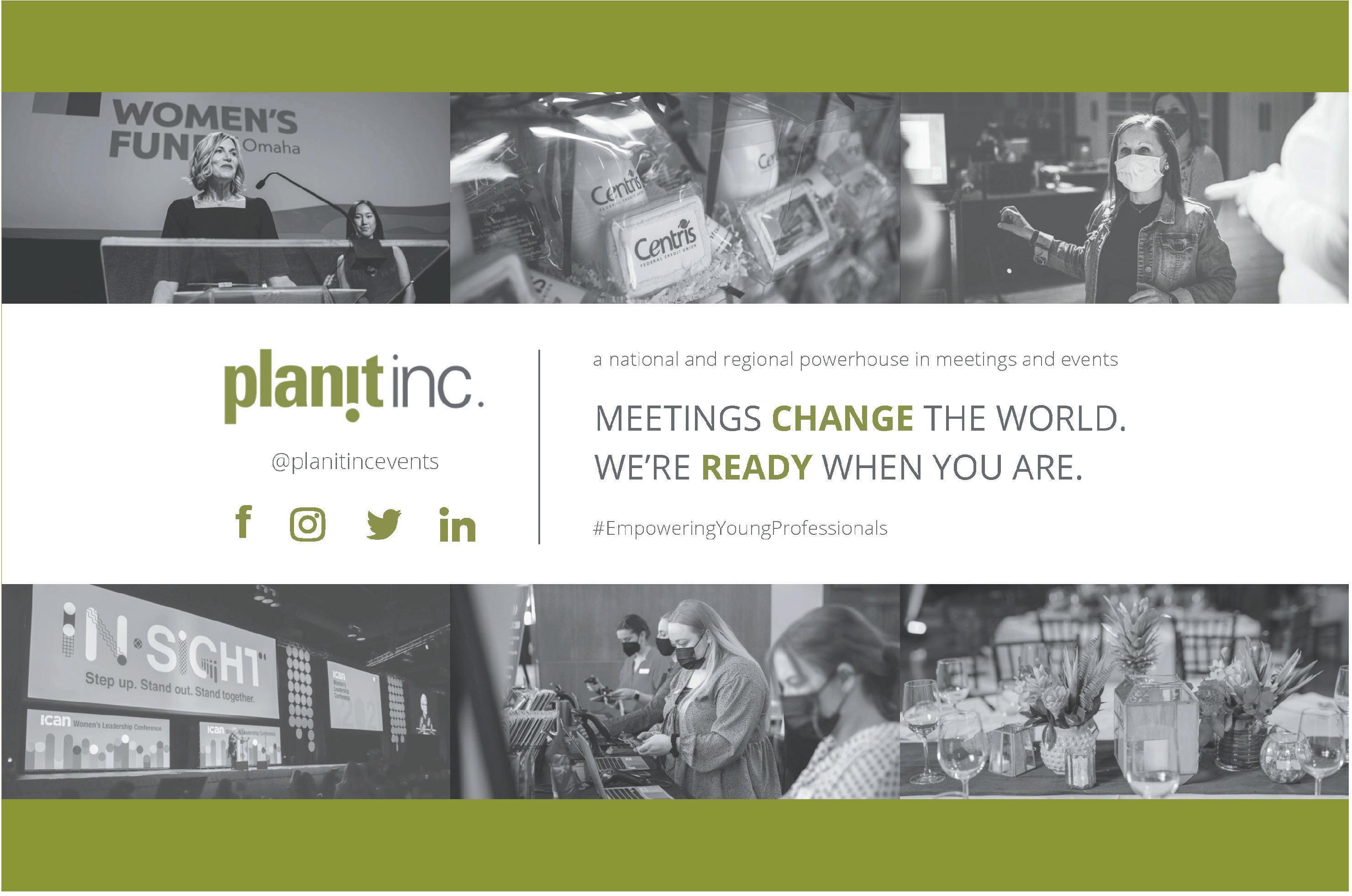
58 mMAGAZINE • NOV/DEC 2022 your money SWARTZBAUGH-FARBER & ASSOCIATES, INC.
words CAN CREATE well-being
“Words have energy and power with the ability to help, to heal, to hinder, to hurt, to harm, to humiliate, and to humble.” -Yehuda Berg

The impact of words on others

Several years ago, I received a letter from a young woman I had mentored early in my career. The young woman wrote to me about several things that I said to her when I was mentoring her that she said led her to finish a particular college degree, pursue a particular career path, and achieve a significant position at an early age. I had told her that I believed in her, thought she was intelligent, thought she was capable of pursuing the college degree she was considering, and that she would need to see obstacles as challenges to be overcome.
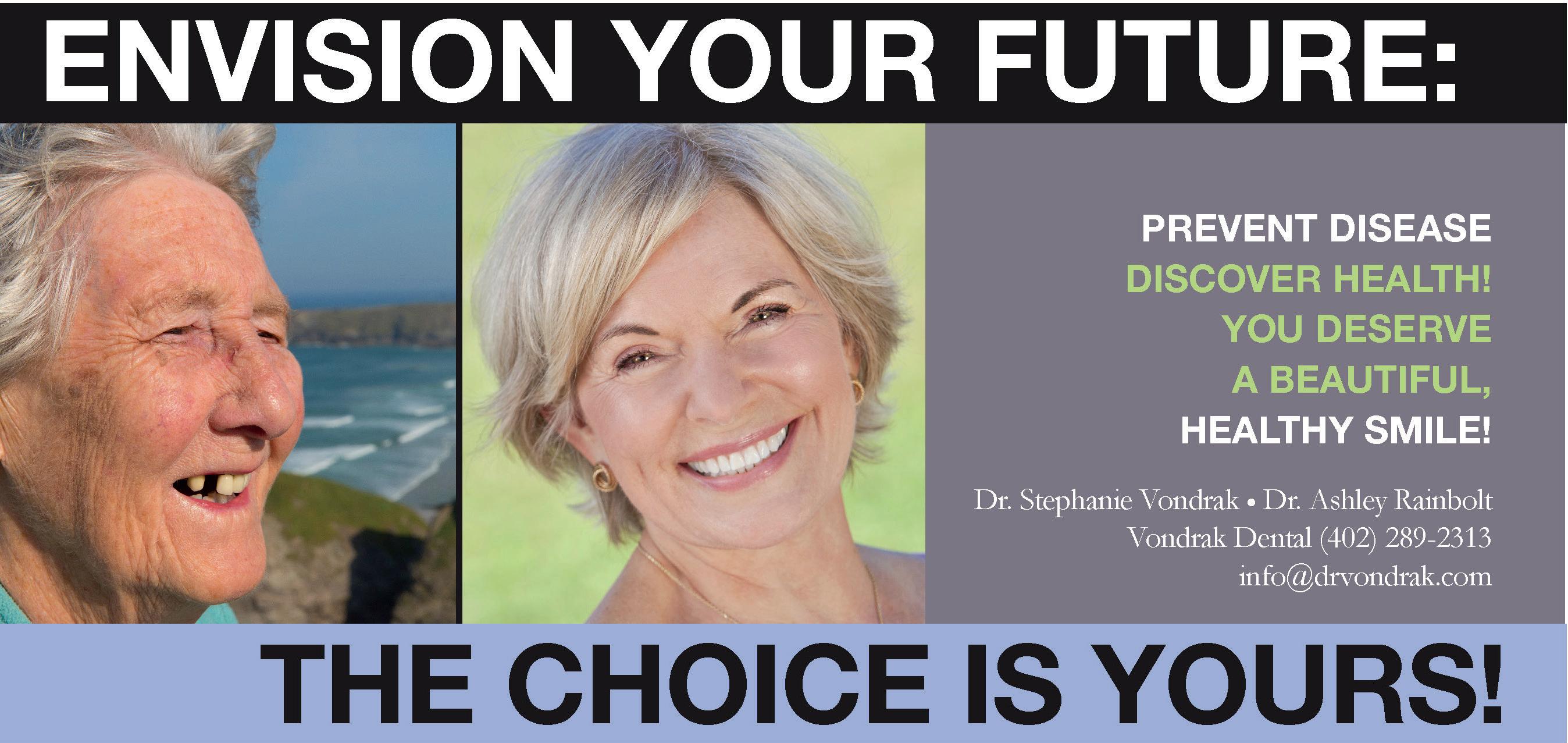
When I read that letter, I was thrilled to realize that encouragement could have a positive effect of that nature and be remembered. On the other hand, I worried about the times that I might have been in bad space and been negative to someone. Since then, I have made a conscious effort to give serious consideration to my use of words in all areas of my life rather than just in legal advocacy.
Words and the well-being of others
Each of us will be better off if we are in positive relationship with those around us. In today’s world, we often make posts on social media as if we were having a conversation. We might dash off an email without really thinking through what we said and the impact of what we wrote.
Words shape our thoughts and those of others. There is a lot of power in using words to encourage and support others.
I was at a conference of lawyers recently. About 200 were in a room together. They were from all walks of life and differing views. A difficult political issue came up. I was thinking, “Oh no, I want out of here.” Instead, the group discussed the issue for nearly 90 minutes. No one raised a voice. No one criticized anyone else for their ideas or thoughts. There were no nasty tweets or posts, just intellectual discussion that left emotion outside of the discussion. At the end of that, I thought about how important the way we use our words really is and that if we could be supportive and kind even when we disagree, we could change the path that this country has been on. A friend recently said, “We have brought some of our ugly-sports-fan mentality into the political arena and doing so is driving us apart as a nation.” It was an interesting comment.
Words and self-well-being
Have you ever listened to what you say to yourself? Have you ever caught yourself saying anything to yourself such as “I’m just no good at this,”“Wow, that was stupid,” or “Why can’t I figure this out?”
Being intentional about what we say to ourselves can significantly improve our own well-being. To accomplish that, you first have to listen to your selfmessaging. When I started doing that, I identified a voice that I started calling “The Incessant Internal Critic.” I realized that my internal critic was pretty harsh. Once you become aware of self-messaging, you can start to make simple changes in what you say to yourself. For example, instead of saying, “This project is just too hard and I am going to have an awful day trying to get through it,” try “I have a very challenging project today. I’m grateful to have some background and great support.” Instead of saying, “How could I have missed that,” try “I notice that I have a challenge to work on.”
59 mMAGAZINE • NOV/DEC 2022 metroSPIRIT
Mary Vandenack, while a lawyer by profession, has studied extensively in mind/body areas of fitness and wellness. She is Yoga Alliance RYT-200, Power Pilates certified and ACE certified and has earned a Specialization in Foundation of Positive Psychology from University of Pennsylvania.
diversity, EQUITY & inclusion
Diversity, equity and inclusion (DEI or DE&I) has been a hot topic in legal circles and elsewhere recently. I recently interviewed Denise Robinson—an attorney and labor and employment consultant (thestillcenter.com)—on my podcast and was particularly interested in how she presented the issue. Denise reminded the audience that diversity isn’t just about male, female, Black, White or sexual orientation. Diversity is simply about different experiences. We chatted about the days when we were in high school and the band members hung out together, and the athletes hung out together, etc. A simple concept of diversity would involve a group that consisted of an athlete, a band member, someone from the drama club, etc.
Diversity and inclusion in the workplace is currently a popular topic. This starts with developing policies on the issues. An effective policy on diversity and inclusion should be customized to the employer: What type of diversity matters? How is inclusion supported? Where do the policies apply? In designing policies, employers
should consider the recruiting process. Significant data reflects that improved recruiting policies will result in a more diverse workforce. Policies should consider each department and leadership.
mary e. vandenack


Purposes of a DEI policy should include promoting an inclusive, discrimination-free environment, highlighting values and best practices and establishing that the company is forward-looking and strategic.

Once policies are created, it is important that the policies be implemented. They aren’t effective if they sit on the computer unread. Employers should engage in training. Training should occur with some regularity. Accountability should be created to enforce the policies.
Employers might consider engaging in a payroll audit. Create an organizational chart without names but using gender and other diversity factors. Doing so may help identify pay disparities that should be considered.
Mentoring programs are being created to facilitate diversity, equity and inclusion. Mentoring programs can actively cultivate a sense of inclusion. Mentoring programs can help with hiring, retention and job performance.
Employers are engaging in training with respect to subtle bias. Subtle biases are microaggressions that may appear so minor that they are often unnoticed. Employers are addressing this issue in leadership trainings.
Employers are also creating the role of chief diversity officer. This role is responsible for helping to develop and implement policies. The chief diversity officer helps create awareness and helps look at the issues in all aspects of the organization and its processes. To the extent that an organization has various divisions or departments, a diversity liaison might be appointed for each division or department to connect and coordinate with the chief diversity officer.
During the past year, Congress has considered (and the U.S. House of Representatives passed) the CROWN Act. CROWN stands for “Creating a Respectful and Open World for Natural Hair.” Several states have also passed CROWN laws.
The exact direction that may be taken in this area remains to be seen, but it appears likely that additional employer compliance requirements may come into play.
60 mMAGAZINE • NOV/DEC 2022
planning matters • WITH VW LAW
resilience
I have a challenge for you. Without thinking too long or hard, grab a pencil and paper. Sit down, take a deep breath, and in one word, write down your most valuable quality. Be descriptive and straightforward; think of a word to characterize yourself or describe yourself to others—go.
Maybe you are honest, loyal, hardworking, kind, or smart. Do any of these qualities jump out at you? I hope so. All are fantastic traits. Who wouldn’t want to be categorized this way?

As for me, my primary word—as I have been told—is not listed above. My word or how most seem to characterize me is resilient


Resilient, by definition, is “to be able to respond or to recover quickly from difficult conditions.” In other words, the ability to take a punch, get back up and keep on going. Figuratively, my life circumstances the last few years have proven this description to be true. In retrospect, resilience has served me well.
As a health-centered dentist, I dedicate much of my time to educating others on their current dental situation and possibilities for a better future. I have shared stories with you of impactful dental experiences as relationships were formed, goals were met, and health was achieved. For example: Donna, who fought to keep her remaining teeth and discovered her beautiful smile along the way. Or Anna, who struggled with dental anxiety and used her
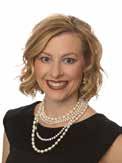
treatment as a platform to conquer other anxieties in her life.
Recently I’ve met two new patients, both under 40, with severe decay and moderate periodontal disease (gum disease). Although the circumstances around each is unique, both will need most of their existing dental restorations replaced or repaired, deep cleanings to remove the bacteria associated with periodontal disease, and lifestyle changes to maintain their new work.
Stated simply, lots of decay and disease equals an undertaking of time, trust and resources. And some would say resilience. Resilient patients believe that the doctor can help them get from their current situation to a better place. They are able to push through their challenges, focusing instead on the possibility of a better outcome than their current situation.
Leo Tolstoy once said, “True life is lived when tiny changes occur.” As a personal example of resilience, I have seen firsthand how tiny life changes can mold my perspective and propel me forward to new things. I have faced challenges steep and overwhelming, yet manageable at the same time. With the gift of resilience, I have powered through.
For my two new patients unfamiliar with my life or my health-centered view, my intent is to work together to reach their dental goals through my experiences in the dental office and beyond. I can influence small health-centered changes that provide longevity to their new fillings and crowns, teach skills for maintaining the health of their gums, and guide lifestyles changes that prevent the need for resilience—at least in the dental office—ever again.
61 mMAGAZINE • NOV/DEC 2022
“Quality is not an act; it is a habit.” - Aristotle
impact! • YOUR DENTAL HEALTH
Dr. Stephanie Vondrak is board certified by the American Academy of Craniofacial Dental Sleep Medicine to treat patients suffering from sleep apnea with sleep apnea appliances.
stephanie vondrak d.d.s.
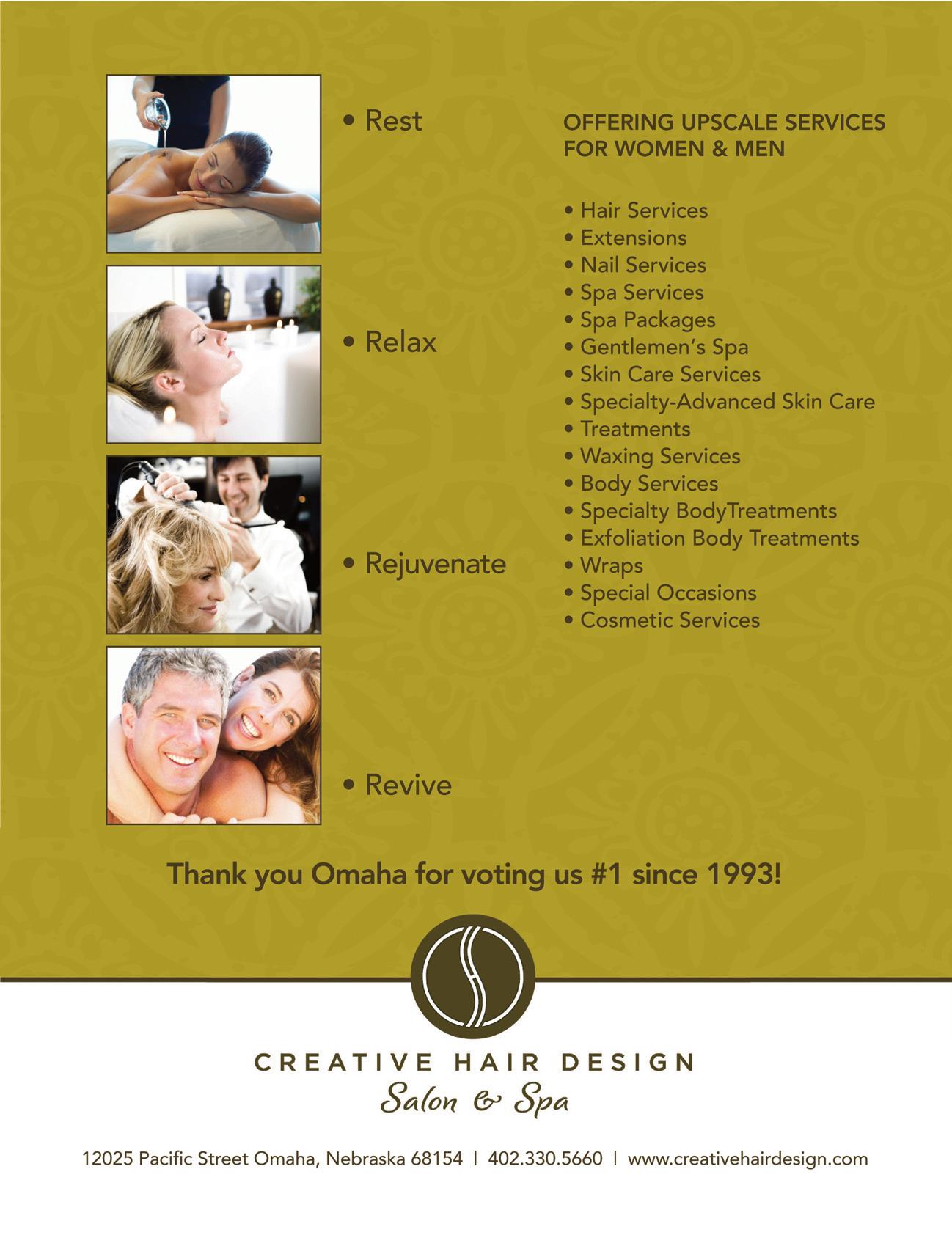


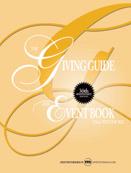








mMAGAZINE • NOV/DEC 2022 63 event galleries | charity support keeping you connected in 2022/23! updated local event info Are you hosting a virtual or on-location event this year? Go to SpiritofOmaha.com & CONNECT to the Greater Omaha community! Create a FREE account to promote & update your event information 365/24/7! LEARN MORE ABOUT THESE ORGANIZATIONS IN THE GIVING GUIDE & EVENT BOOK!
Autism Community Autism Action
Name of Organization: Autism Action Partnership
Event Name: A Vintage Affaire XIV
When: October 1, 2022
Where: Embassy Suites La Vista
Why: Serving Nebraska’s autism community through support, inclusion and prosperity.

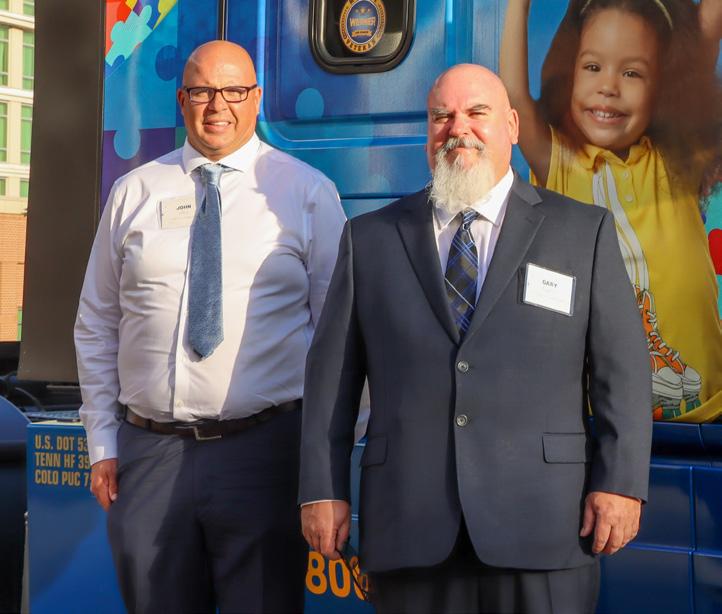
Special Guests: Honorary Chairs Gail & Scott Robertson; Help is Hope Award Honoree Katie Noble Weitz

Event Planner: LimeLight Expressions, Kimmylea Konsel-Taylor
Attendance: 264
Amount Raised: $499,905
Event Summary: A Vintage Affaire XIV: A Night Under the Stars was October 1, 2022, with hon orary chairs Gail and Scott Robertson. Autism Action Partnership’s annual gala included a silent auction, live auction, dinner and program. Our Help is Hope Award honored Kate Noble Weitz for her inclusion work over many years in the Omaha community and beyond.
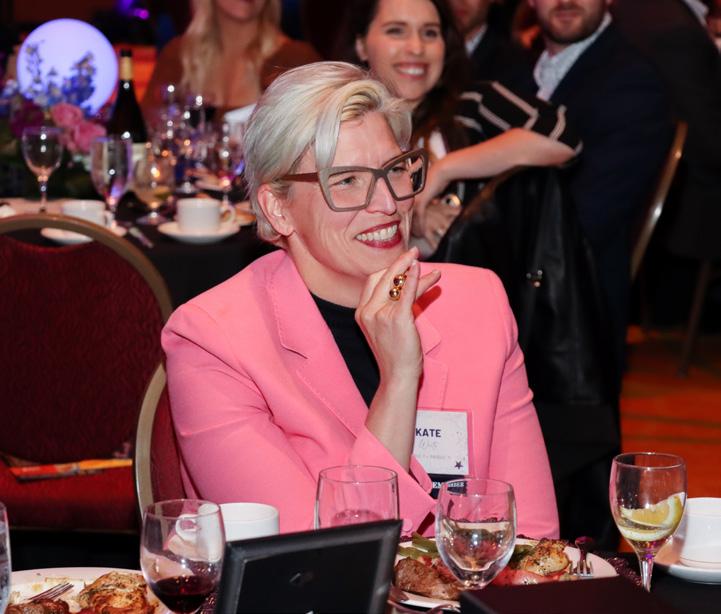


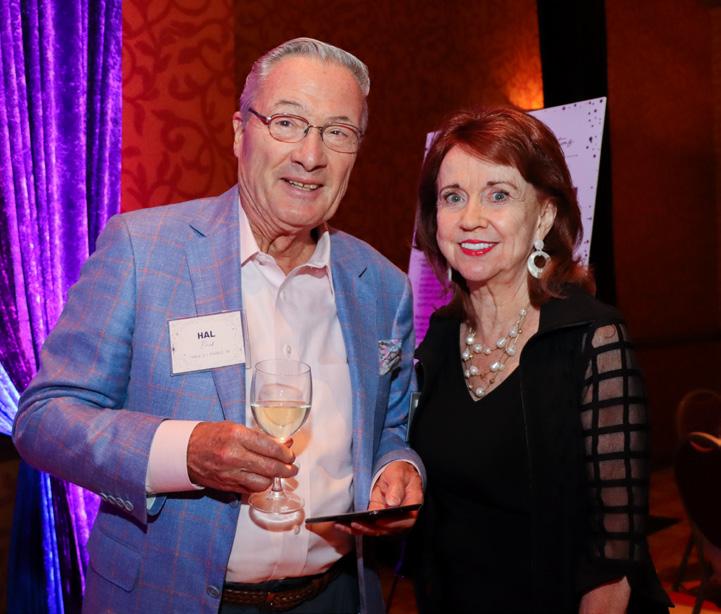

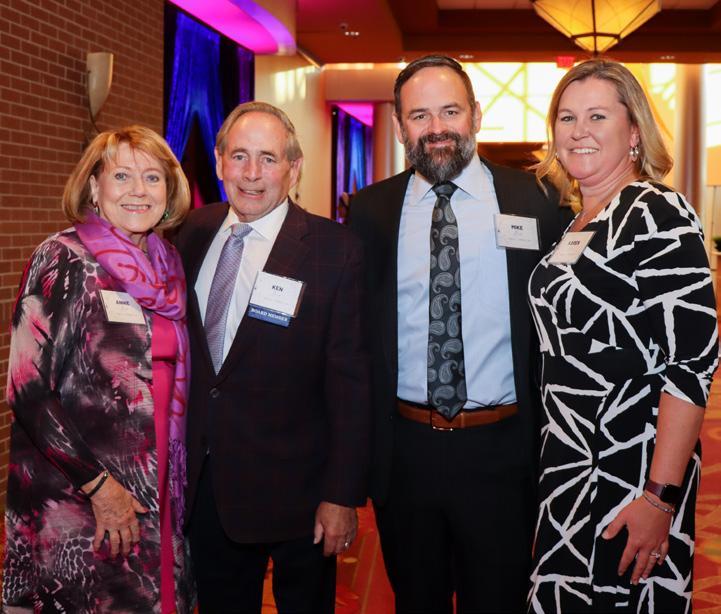
For more information: (402) 763-8830, autismaction.org
Sponsors: Platinum Patrons: Keeler & Associates, Robertson Family Foundation, Rachel & CL Werner; Gold Patrons: Cindy & Mogens Bay, Heider Family Foundation, Kate & Roger Weitz, Katie Weitz, PhD; as well as numerous others
Partnership: A Vintage Affaire XIV
Page 64 • NOV/DEC 2022
PHOTOS BY
DEBRA S. KAPLAN
KATE NOBLE WEITZ
MARY AND HAL DAUB
JOHN ALVES AND GARY LAMPHIER OF WERNER ENTERPRISES
NICOLE RODRIGUEZ, NANNETTE RODRIGUEZ, TENA HAHN-RODRIGUEZ
SCOTT ROBERTSON AND GAIL WERNER-ROBERTSON
JUSTIN DOUGHERTY
SOLOMON, THERESA, AND BRYCEN BRADLEY
ANNIE BIRD, KEN BIRD, MIKE BIRD, KAREN BIRD
KATIE WEITZ, PHD, TIM WILSON, KATE NOBLE WEITZ, ROGER WEITZ, WALLY WEITZ
County Fair
QLI: An Evening at the Fair
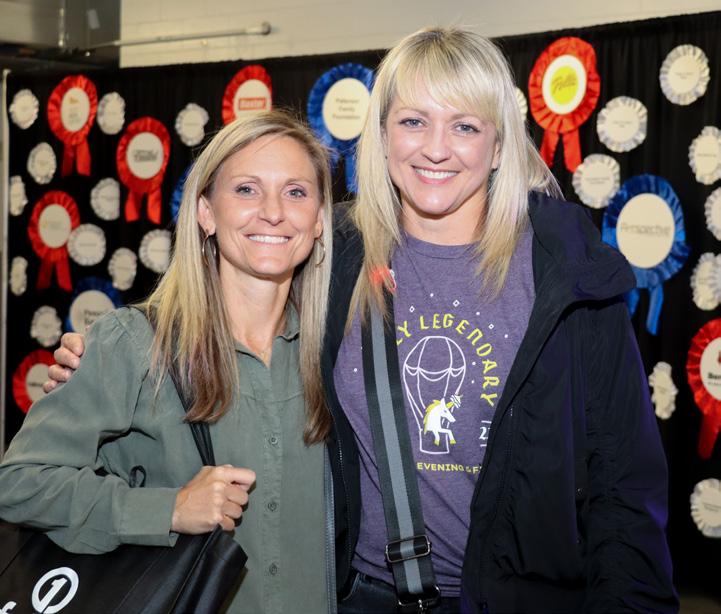
Name of Organization: QLI


Event Name: An Evening at the Fair

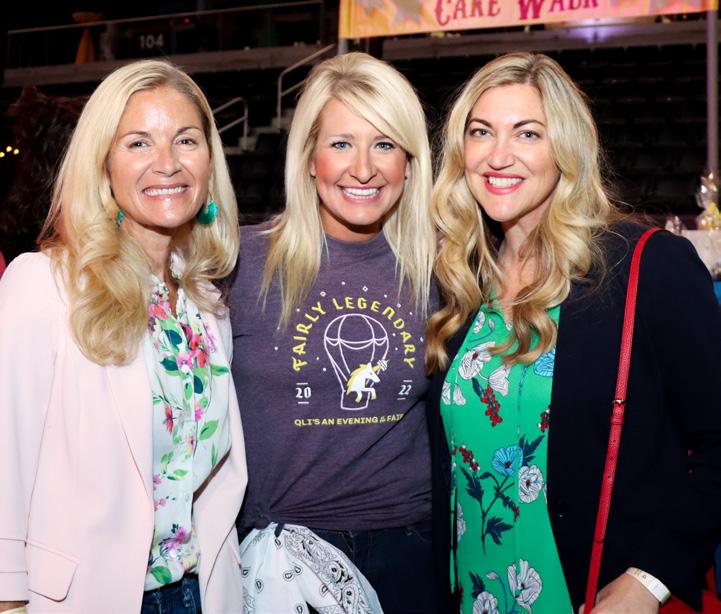
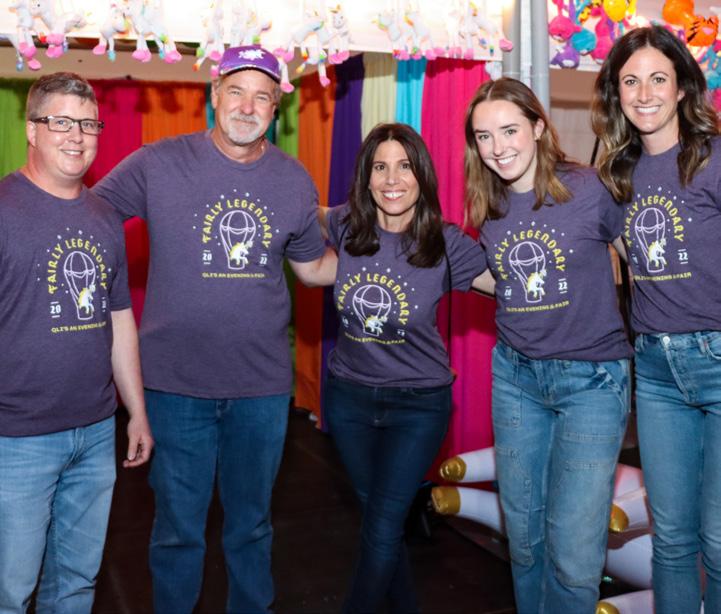
When: September 16, 2022
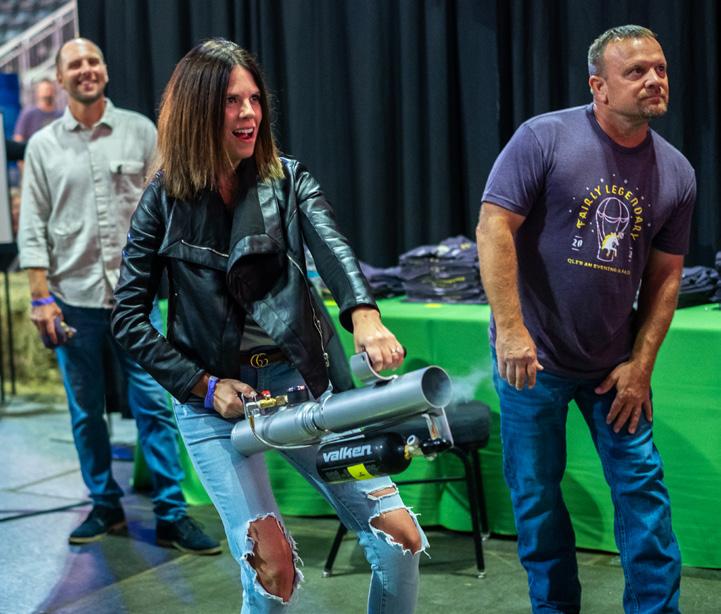
Where: Baxter Arena
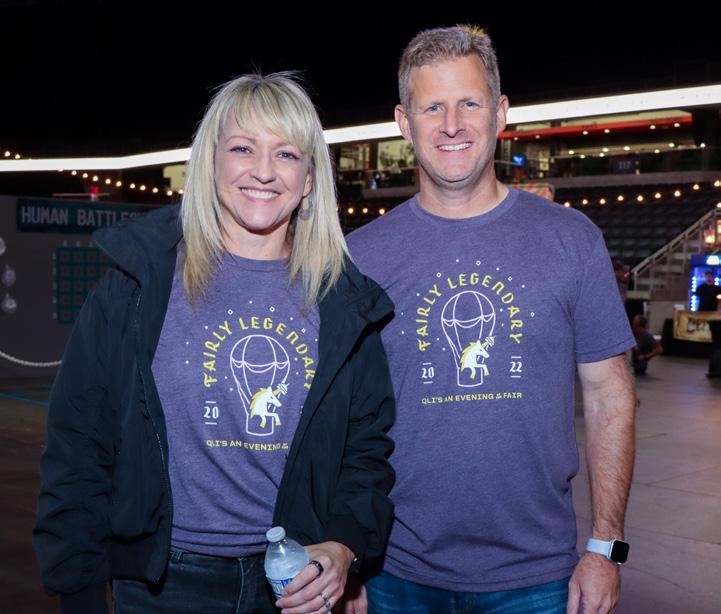
Why: Raise funds for QLI’s Life Path Services program
Special Guests: Honorary Chairs Terri and Jack McDonnell, Pat and Sharon McNeil; Event Chairs Lauren McDonnell, Phil and Katie McDonnell, PJ and Shannon McNeil, Erin and Joe Pogge
Catered by: Savor Omaha
Attendance: 700
Amount Raised: $475,000
Mission: Deliver life-changing rehabilitation and care. Protect dignity. Instill purpose. Create hope. Commit to excellence.
About: The only place of its kind in the nation, QLI helps rebuild lives after a catastrophic neurolog ical injury. Founded on best practices, QLI has developed a revolutionary model that addresses not only the core medical and physical aspects of rehabilitation, but is also designed to address the real-world skills and individualized interests that bring purpose and passion to our lives.
For more information: (402) 573-3700, www.teamQLI.com
Sponsors: Lead Sponsors include Lori and David Scott Foundation, The Cindy and Mogens Bay Family Foundation, Bryan Heart, Jill and Steve Hornady, Terri and Jack McDonnell, Northern Natural Gas, Perspective Insurance, Pinnacle Bank, Vetter Senior Living
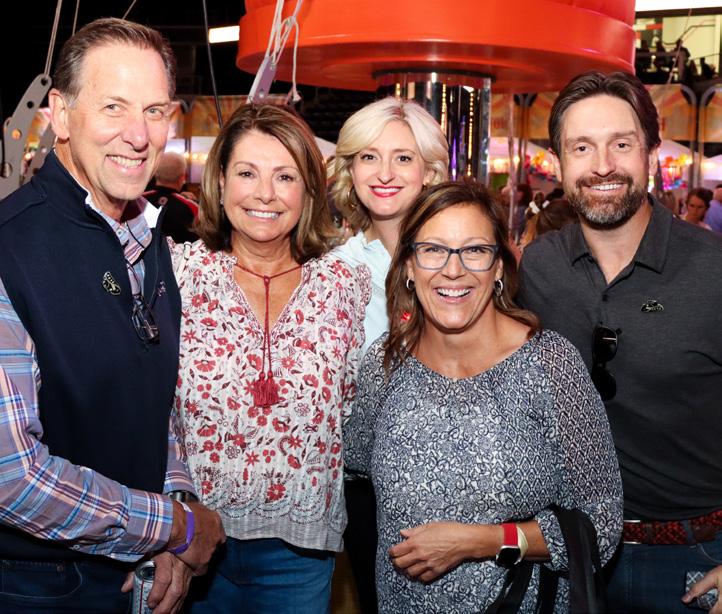
Page 65 • NOV/DEC 2022
PHOTOS BY
DEBRA S. KAPLAN, JON PEARSON
PJ MCNEIL AND QLI TEAM MEMBERS WATCH SHANNON
MCNEIL SHOOT THE T-SHIRT CANNON
QLI CEO PATRICIA KEARNS, QLI CFO TODD SCHUITEMAN
LYN KUMMER AND PATRICIA KEARNS
JESSICA SUMMERS, LAUREN MCDONNELL - EVENT CHAIR
CAMEO SIDORUK, MARGARET LEIGHTON, ERIN O’BRIEN, REGAN MACKINTOSH, ERIN KAISER, ASHLEY HORGAN
QLI TEAM MEMBERS ASH BENTLEY, TODD SCHMITZ, SUSAN GRUENLING, LIZZY KRATOCHVIL, MEGAN POTTER
PAT MCNEIL, CATHY BONNESEN, LAUREN MCDONNELL, KAREN MILLER, PHIL MCDONNELL
KELLY NOGG, TAYLOR KERSCHKE, MELISSA HEGARTY
ROB & JULIE HOCKNEY, JOE & ERIN POGGE - EVENT CHAIRS
On Fire for Ethics
Better Business Bureau: 2022 BBB Torch Awards for Ethics
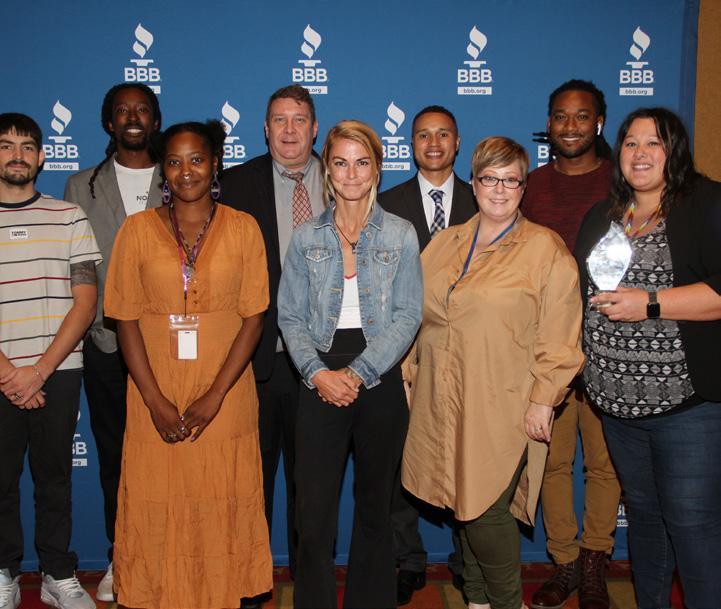


Name of Organization: Better Business Bureau
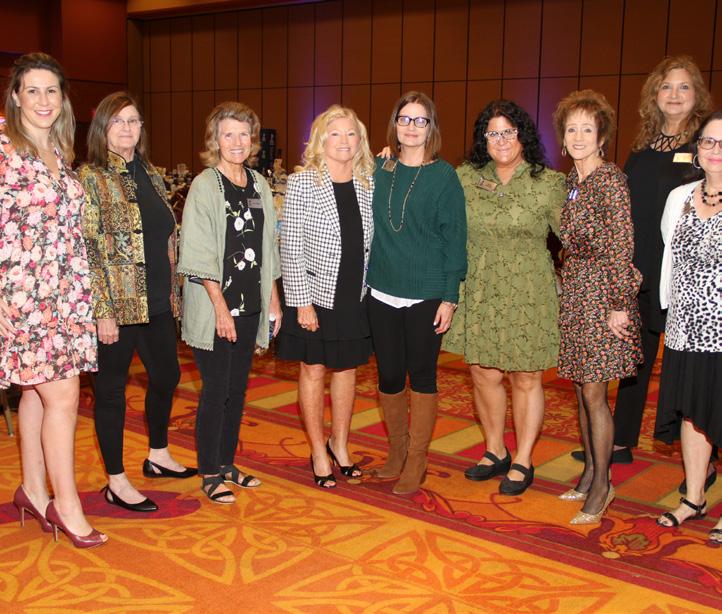
Event Name: 2022 BBB Torch Awards for Ethics Luncheon

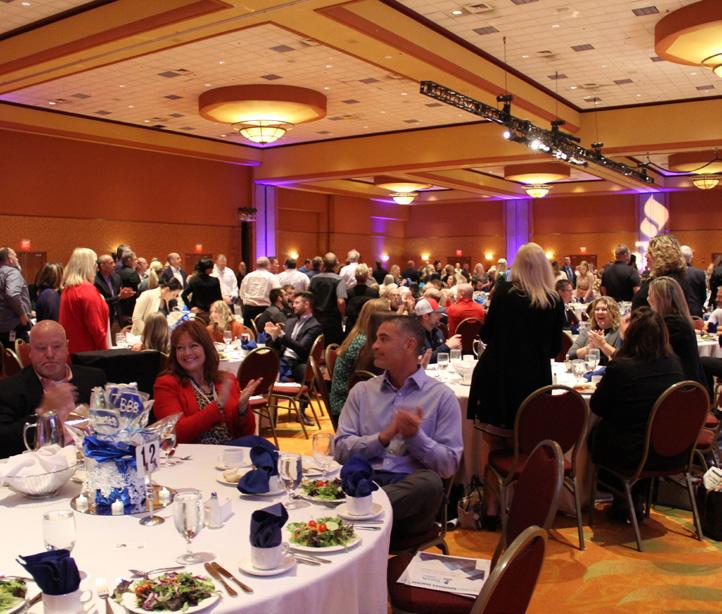
When: September 21, 2022
Where: Embassy Suites La Vista
Why: To honor organizations that put ethics into practice.
Special Guests: Business and community lead ers.
Attendance: 600
Event Summary: The BBB Torch Awards for Ethics (formerly the BBB Integrity Awards), a program of BBB’s foundation serving Nebraska, South Dakota, The Kansas Plains and Southwest Iowa, honors businesses and nonprofits for put ting ethics into action. Since the inception of the program in 1995, hundreds of organizations have been presented with this prestigious award.
Mission: To be the leader in advancing market place trust.
For more information: (402) 391-7612 or www.bbb.org/omahatorch
Sponsors: McKinnis Roofing & Sheet Metal, KETV NewsWatch 7, Midlands Business Journal, OBI Creative, Omaha Steaks, Mr. Car Shipper, LLC, Union Bank & Trust, PayPal, CombOver Contracting, biBERK, Mutual of Omaha, Thrasher Foundation Repair, Cox Communications, Centris Federal Credit Union, Pinnacle Bank, Seldin, LLC, Certified Transmission, Medical Solutions, Midwest Eye Care, Signature Performance, and many more.
Luncheon
Page 66 • NOV/DEC 2022
NORTH END TELESERVICES WAS HONORED AS A TORCH AWARD WINNER AT THE EVENT.
FORNEY REPAIR, LLC WAS HONORED AS A TORCH AWARD WINNER AT THE EVENT.
HURRDAT, LLC WAS HONORED AS A TORCH AWARD WINNER AT THE EVENT.
DOZENS OF PREVIOUS WINNING ORGANIZATIONS WERE HONORED AT THE EVENT.
THE 25TH ANNIVERSARY OF THE LUNCHEON FEATURED ONE OF THE LARGEST TURNOUTS IN EVENT HISTORY.
BBB STAFF MEMBERS WORKED TIRELESSLY TO PUT ON A FANTASTIC EVENT.
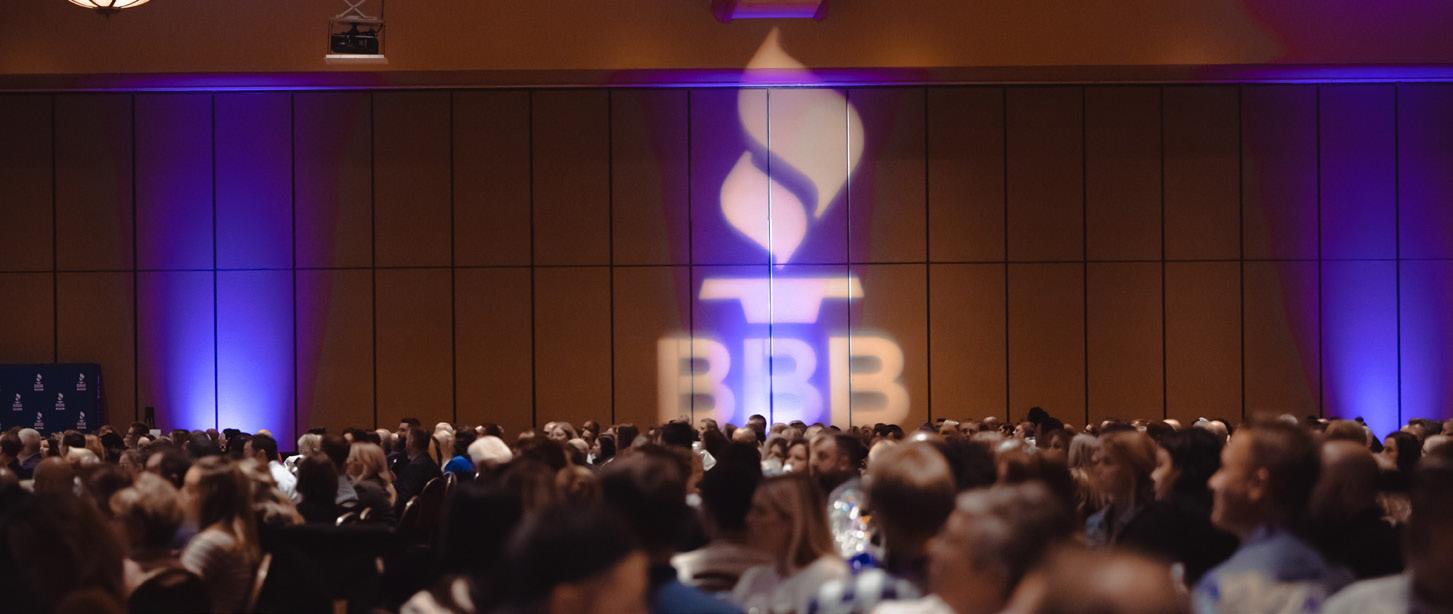
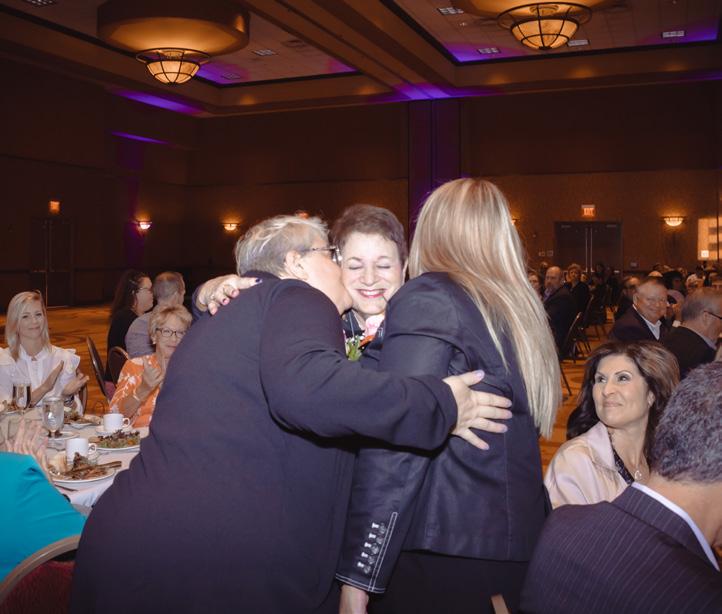
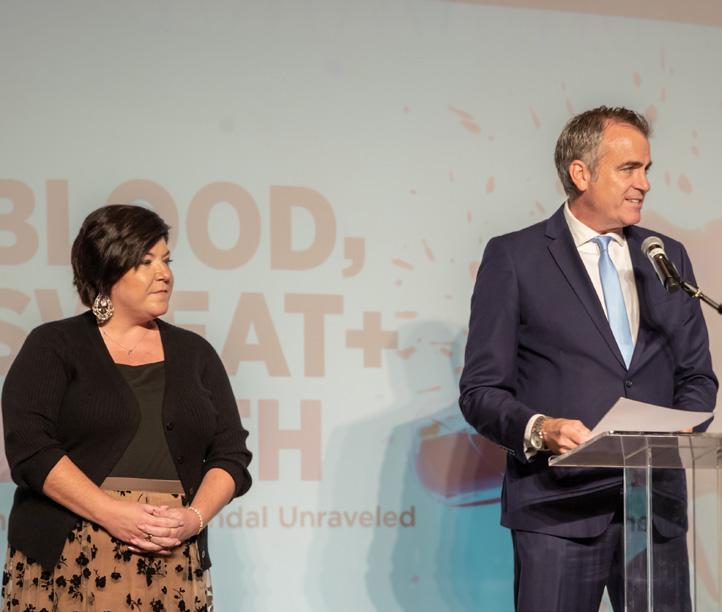
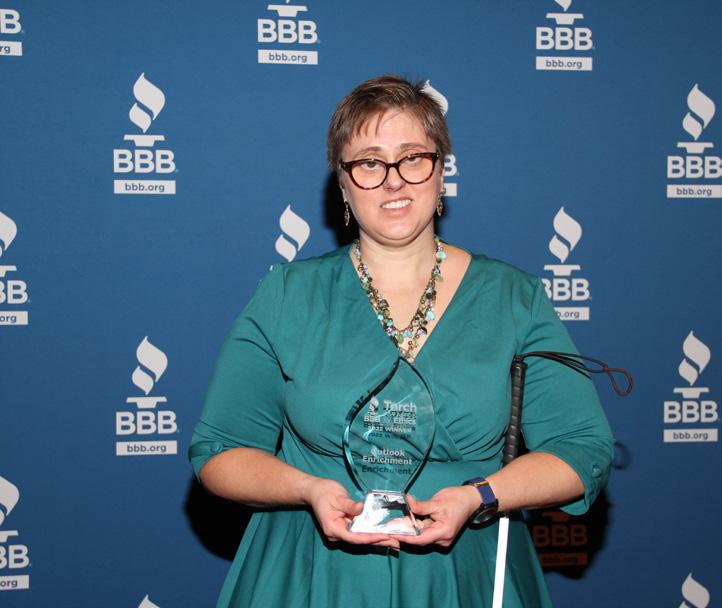
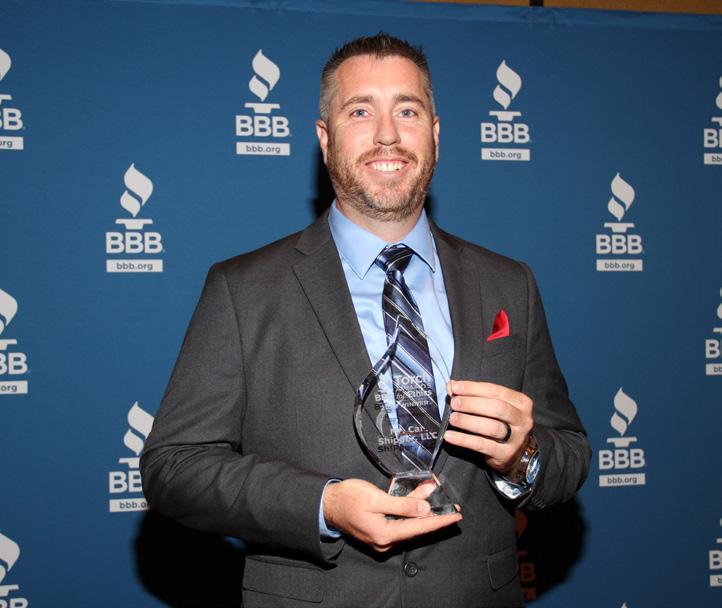
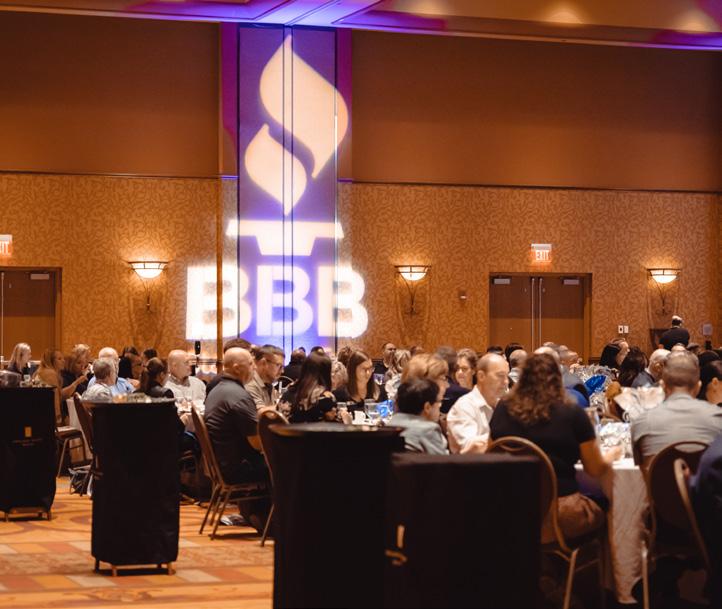
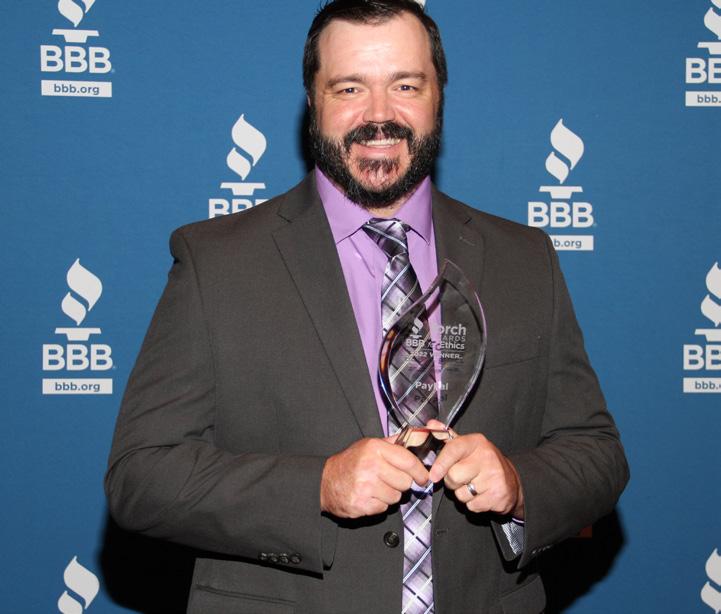

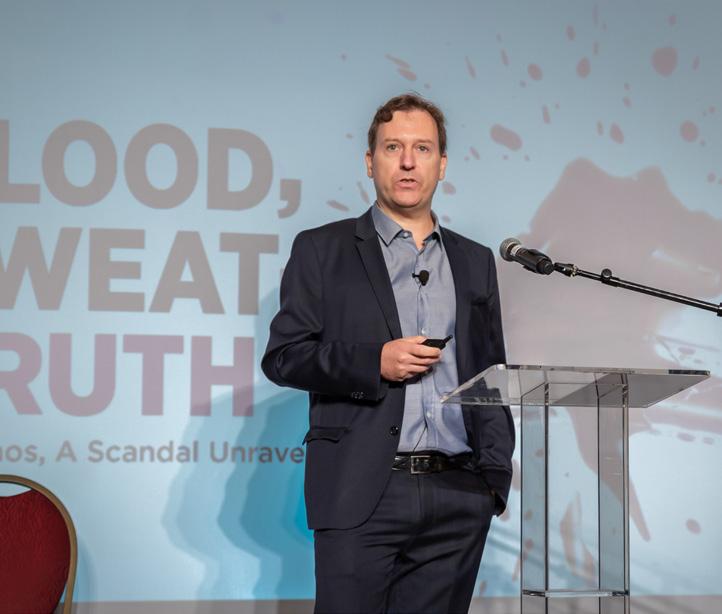
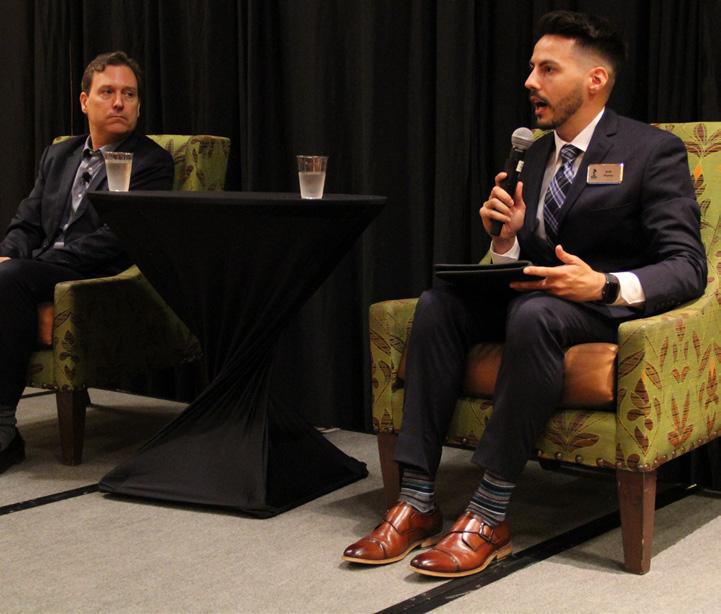

Page 67 • NOV/DEC 2022
BY
PHOTOS
MONICA SEMPEK PHOTOGRAPHY, LLC, AND MARCUS OF OMAHA FINE PHOTOGRAPHY
PAYPAL WAS HONORED AS A TORCH AWARD WINNER AT THE EVENT.
FLORENCE HOME WAS HONORED AS A TORCH AWARD WINNER AT THE EVENT.
PULITZER PRIZE-WINNING JOURNALIST JOHN CARREYROU SERVED AS THE EVENT’S KEYNOTE SPEAKER.
EVENT SPONSORS ATTENDED A COFFEE & CONVERSATION EVENT WITH KEYNOTE SPEAKER JOHN CARREYROU AND BBB VP OF COMMUNICATIONS JOSH PLANOS.
BBB PRESIDENT AND CEO JIM HEGARTY HONORED A NUMBER OF ORGANIZATIONS AT THE EVENT.
OUTLOOK ENRICHMENT WAS HONORED AS A TORCH AWARD WINNER AT THE EVENT.
MR. CAR SHIPPER, LLC WAS HONORED AS A TORCH AWARD WINNER AT THE EVENT.
EMBASSY SUITES-LA VISTA HOSTED THE EVENT, AS IT HAS FOR MANY YEARS.
OUTGOING BBB DIRECTOR OF COMMUNICATIONS MARGO RIEKES WAS HONORED FOR HER EFFORTS OVER THE YEARS.
KETV ANCHOR ROB MCCARTNEY SERVED AS THE EVENT EMCEE.
THE 2022 BBB TORCH AWARDS FOR ETHICS LUNCHEON BROUGHT NEARLY 600 ATTENDEES TOGETHER.
Bucket List
Dreamweaver Foundation: Boots & Buckets
Name of Organization: Dreamweaver Foundation
Event Name: Boots & Buckets
When: September 22, 2022
Where: A View West Shores
Why: A casual event to help raise money to cross off “bucket list” dreams for older adults
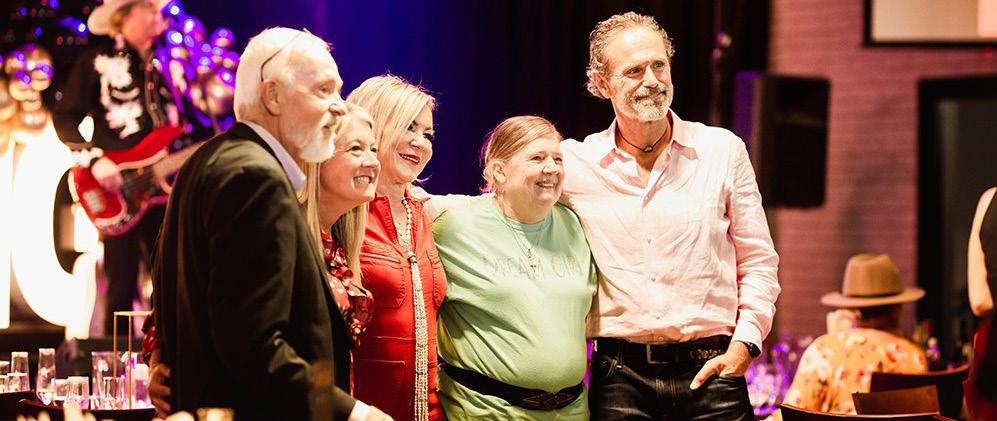
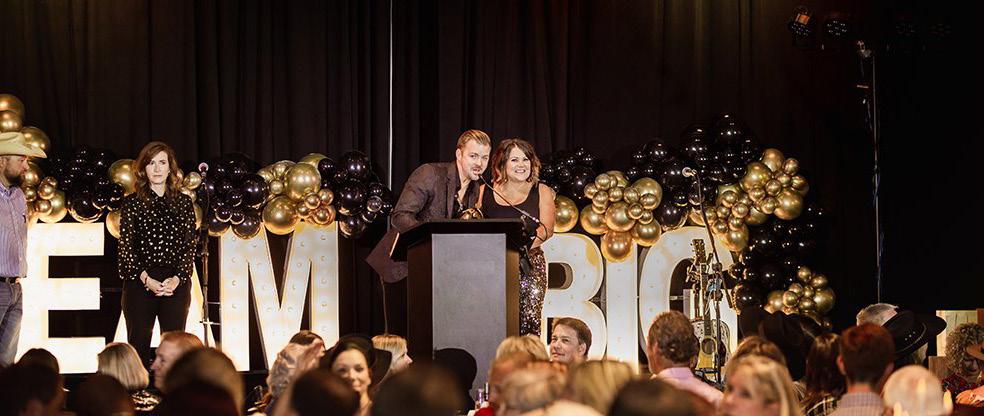
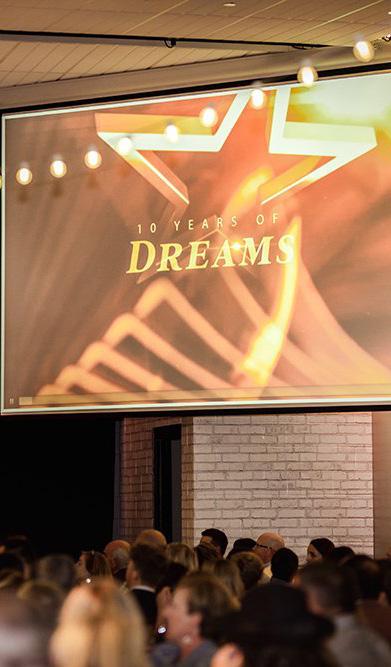
Special Guests: Honorary Chairs Paul and Lori Hogan
Catered by: A Catered Affair
Attendance: 670
Amount Raised: $501,078
Event Summary: A casual event where we encourage people to wear their favorite style of boots and help raise money to cross off “bucket list” dreams for older adults.

For more information: (402) 697-5471, www.dreamweaver.org

Page 68 • NOV/DEC 2022
COURTESY OF DREAMWEAVER FOUNDATION
PHOTOS
CELEBRATING 10 YEAR OF DREAMS
670 IN ATTENDANCE HELPED RAISE JUST OVER $500K
ENJOYING AN EXCLUSIVE SPEAKEASY CALLED THE GOLDEN EGG
CHERI MASTNY AND JOSH BRINK ON STAGE ANNOUNCING OVER
OUR FEATURED DREAMER’S FAMILY MEETING OUR FOUNDERS, RON & JEANIE CARSON GUESTS

Good Vibes
Goodwill Industries, Inc: Celebrate Good Gala

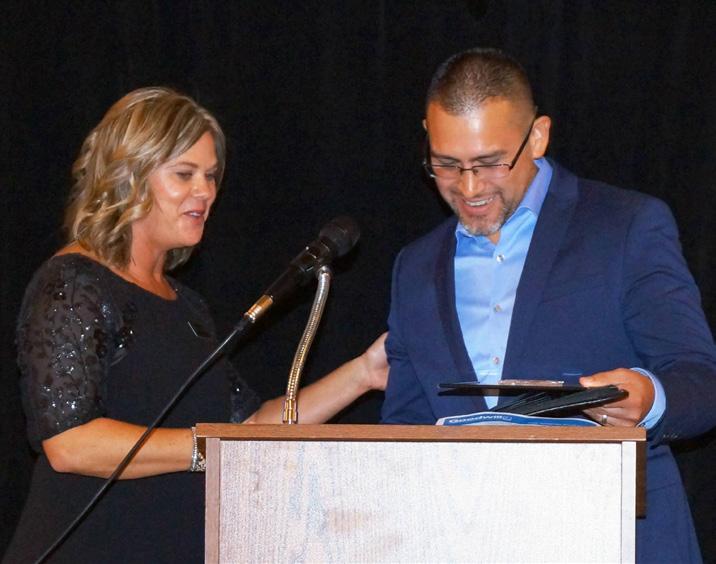
Name of Organization: Goodwill Industries, Inc.
Event Name: Celebrate Good Gala
When: September 30, 2022
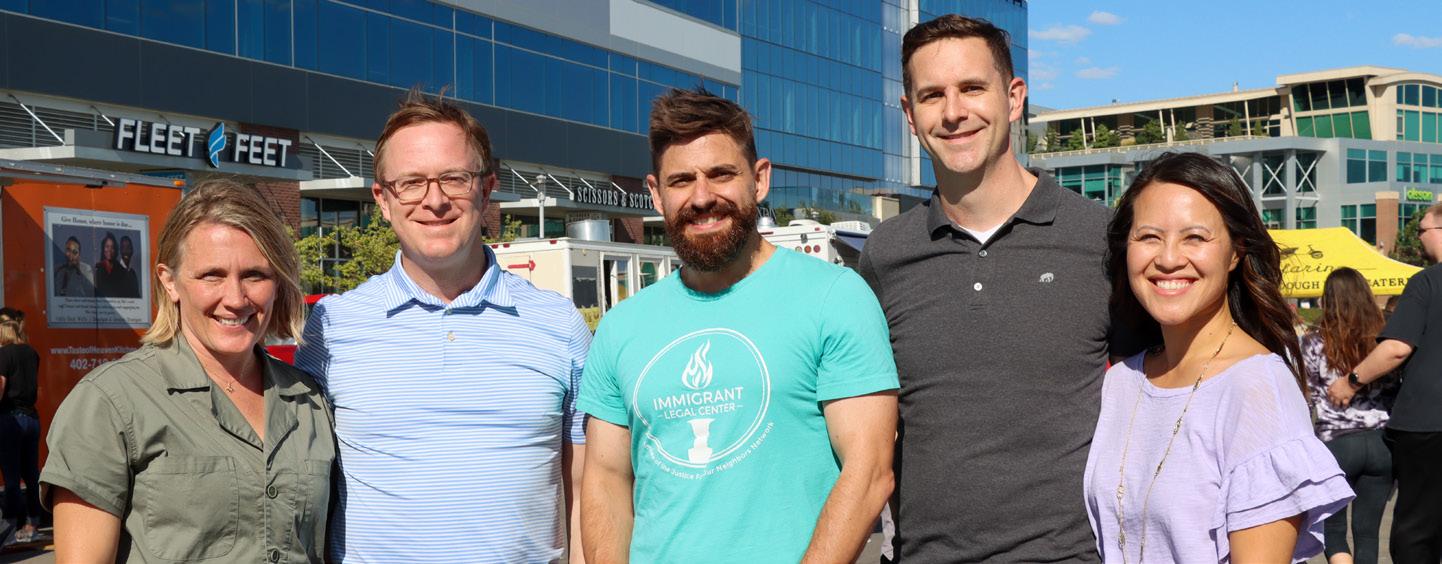
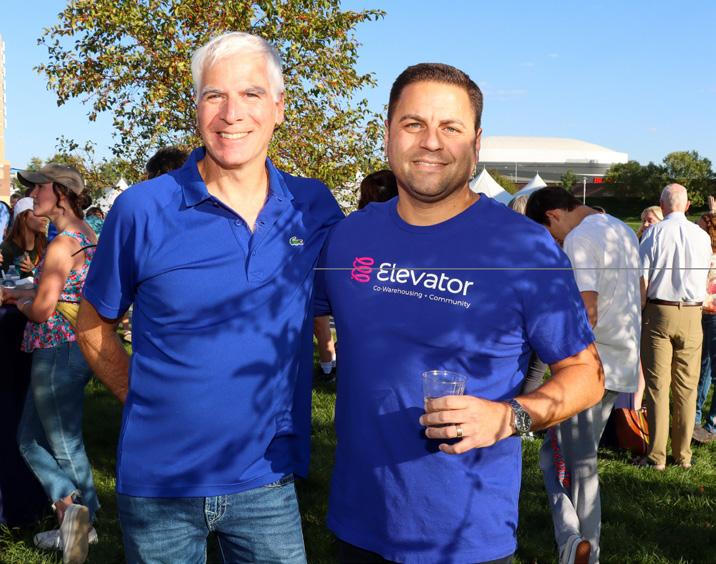

Where: Livestock Exchange Ballrooms
Special Guests: Emcee Matt Mainelli, senior manager with Home Instead; Keynote Speaker Douglas County Commissioner Roger Garcia; Mission Speaker Chris Parker, a former Employment Solutions participant
Catered by: Brandeis Catering
Multimedia/Rentals by: Concepts AV
Attendance: 250
Amount Raised: $32,500
For more information: (402) 573-4714, goodwillomaha.org
Sponsors: Mission Sponsor: Union Bank & Trust (visit goodwillomaha.org/2022-gala/ for a full list of our Table Sponsors)
Feed the World Immigrant Legal Center: Food Truck World Tour
Name of Organization: Immigrant Legal Center
Event Name: Food Truck World Tour
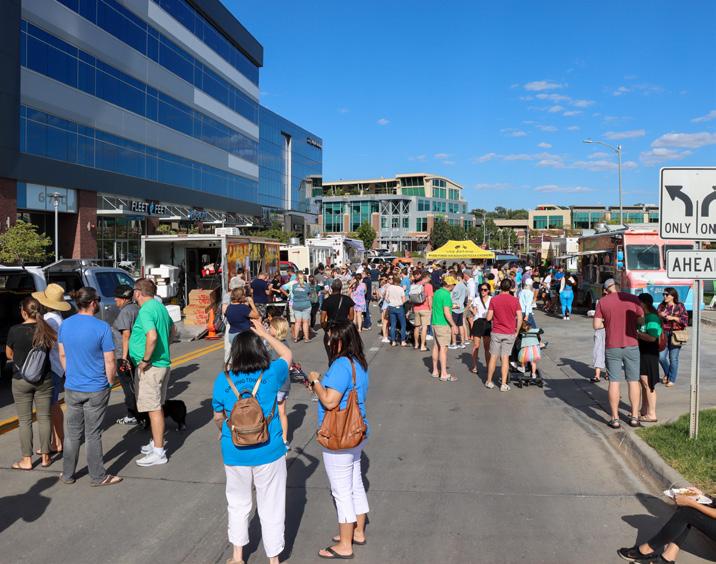
When: September 25, 2022
Where: Stinson Park in Aksarben Village
Why: Raise funds for free immigration legal services for low-income immigrant families in Nebraska
Special Guests: Chairs Ashley and Jonathan Wegner, Krystal Vuong Wegner and Nick Wegner
Attendance: 600
Amount Raised: $230,000
For more information: (402) 898-1349
Sponsors: Omaha Steaks, Annette and Paul Smith, Susan and Mike Lebens, Polina and Bob Schlott, Gallagher, Kiewit, Mulhall’s, Noddle Companies, Scoular

Page 70 • NOV/DEC 2022 PHOTOS COURTESY OF GOODWILL INDUSTRIES, INC.
HOMER MCPHERSON, A GOODWILL EMPLOYEE AND TALENTED SINGER, WELCOMED EVERYONE INTO THE BALLROOM WITH HIS RENDITION OF LEAN ON ME.
GUESTS SITTING DOWN FOR DINNER.
GOODWILL PRESIDENT & CEO TOBI MATHOUSER WEL COMING KEYNOTE SPEAKER ROGER GARCIA, DOUGLAS COUNTY COMMISSIONER, ON STAGE.
GUEST ENJOYING THEIR DINNER.
PHOTOS BY DEBRA S. KAPLAN
TODD SIMON AND EMILIANO LERDA
CROWD SHOT
ASHLEY WEGNER, JONATHAN WEGNER, ERIK OMAR, NICK WEGNER, KRYSTAL VUONG WEGNER
Wave Runners
Madonna Rehabilitation Hospitals Foundation: 7th Annual Miles
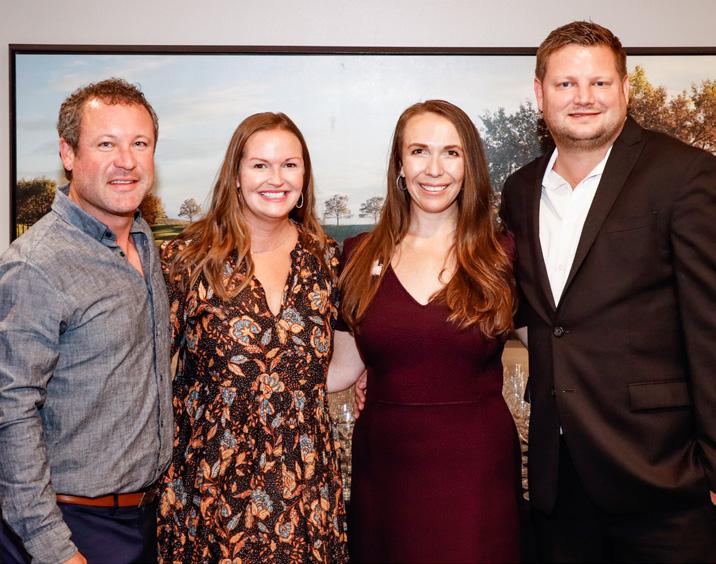
Name of Organization: Madonna Rehabilitation Hospitals Foundation
Event Name: 7th Annual Miles for Madonna

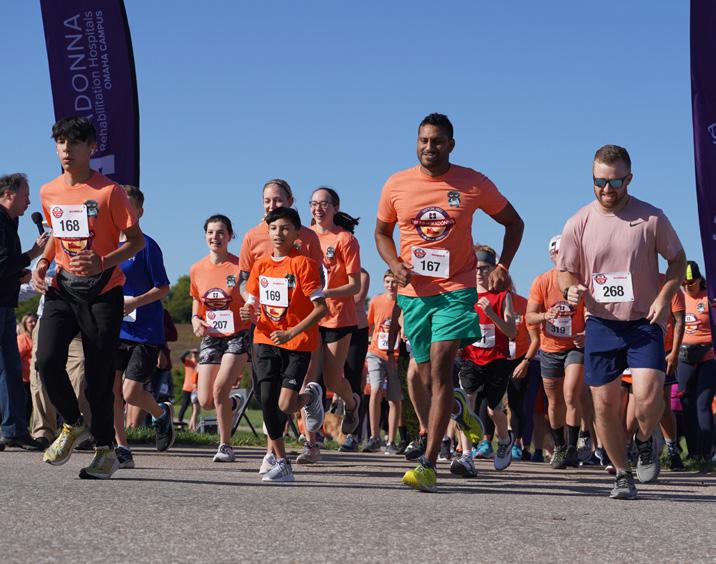

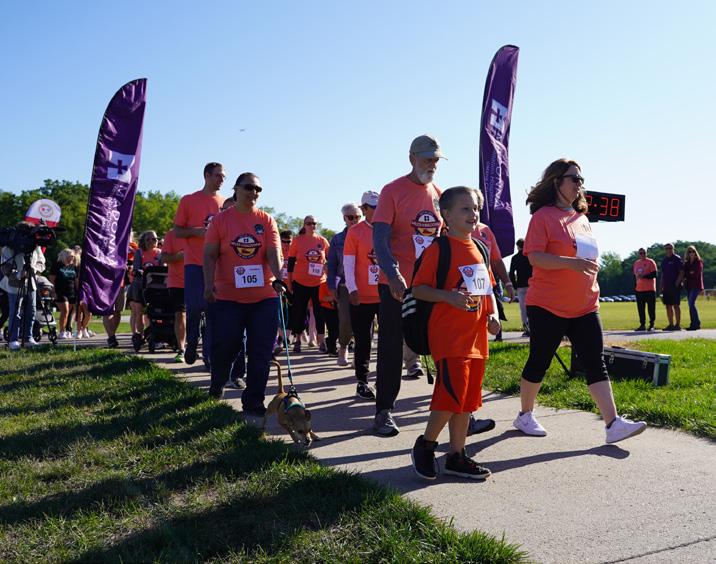
When: September 24, 2022
Where: Zorinsky Park
Why: To raise funds to benefit our patients.
Special Guests: Steele McLaren, honorary captain
Attendance: Over 250 (virtual and in person)
Amount Raised: n/a
Event Summary: Runners, walkers, former patients and friends cheering from afar helped make the 2022 Miles for Madonna a success in raising funds for critical patient-assistance pro grams. More than 250 participants supported the seventh annual event at Omaha’s Lake Zorinsky on September 24. Virtual runners and walkers from nine states and 37 cities also participated. For more information: (402) 401-3000, www.madonna.org
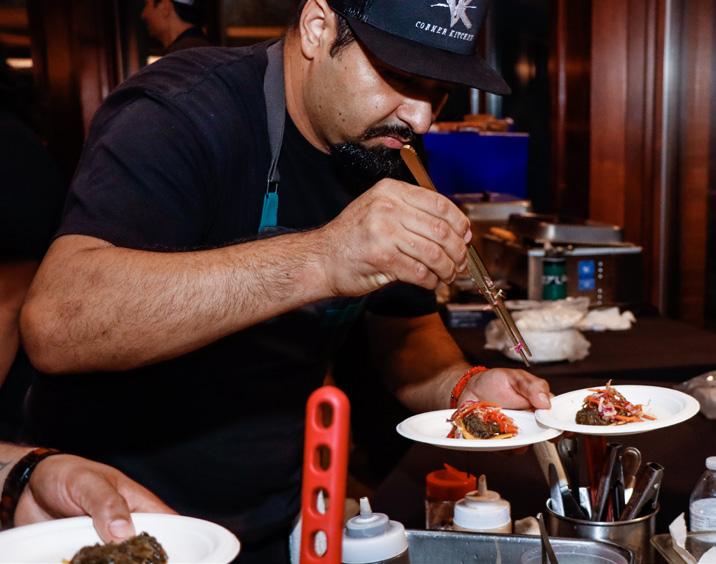
Sponsors: Special thanks to the Miles for Madonna Title Sponsor, Scheels; Race Sponsor, Cox Business; T-shirt Sponsor, Omaha Media Group; Food Sponsor, HyVee.
Noir Nosh
Completely KIDS: Pinot, Pigs & Pours
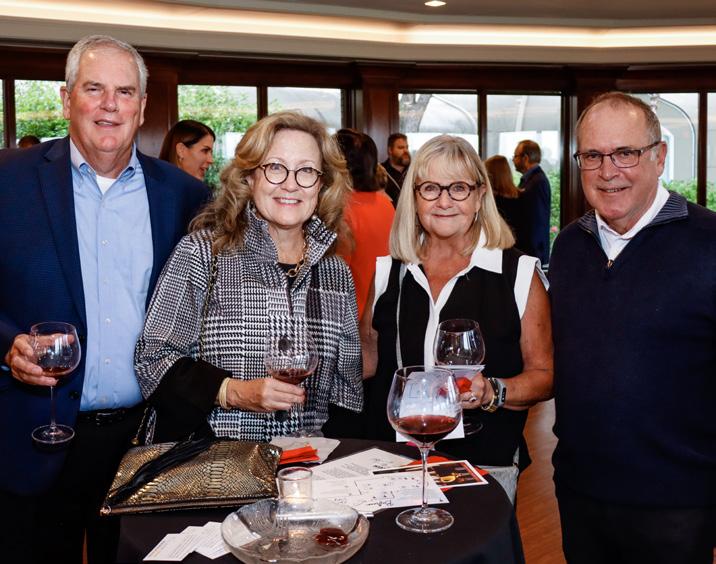
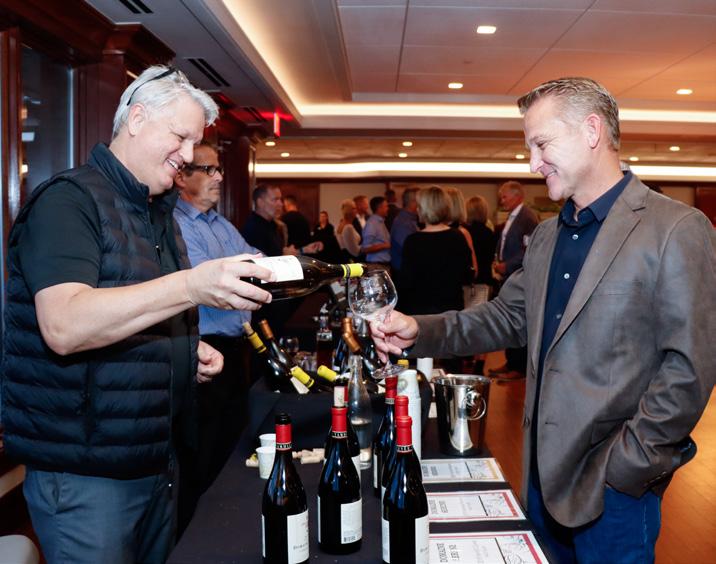
Name of Organization: Completely KIDS
Event Name: Pinot, Pigs & Pours
When: September 22, 2022
Where: Champions Run
Why: Support of Pinot, Pigs & Pours will ensure that Completely KIDS can continue to recognize and respond to the needs in our community and provide for children and families right here in Omaha. Completely KIDS has a holistic approach that includes food, mental health, youth programming, family support and teen engagement services.
Attendance: 350
Amount Raised: Over $250,000
Event Summary: This staple event continued to bring some of the most distinct pinot noir wines and delicious pork-themed dishes and also featured offering palate-enhancing whiskey for added tasting pleasure. Pinot, Pigs & Pours serves as Completely KIDS’ main fall event, combining this delicious occasion with the impact of Night in the Neighborhood for one tantalizing evening that left everyone inspired. For more information: (402) 397-5809
Page 71 • NOV/DEC 2022 PHOTOS COURTESY OF MADONNA REHABILITATION HOSPITALS FOUNDATION
FACE PAINTING IS A FAN FAVORITE WITH KIDS. FURRY FRIENDS ARE ALWAYS WELCOME.
IT WAS A SEA OF ORANGE AS THE WALKERS BEGAN THE 1-MILE COURSE.
ON YOUR MARK – GET READY – GO! RUNNERS STARTING THE 5K COURSE.
PHOTOS BY DEBRA S. KAPLAN
EVENT CHAIRS, ANN & KYLE PITSCHKA AND EMILY & TRENT ALLEN
PEOPLE’S CHOICE WINNER CHEF OSCAR HERNANDEZ OF CORNER KITCHEN
DEBBIE AND MARK HEENEY AND HONORARY CHAIRS MARY JO & BOB LANGDON
Restoration Celebration!
Rejuvenating Women: 8th Annual Restored Wings Gala
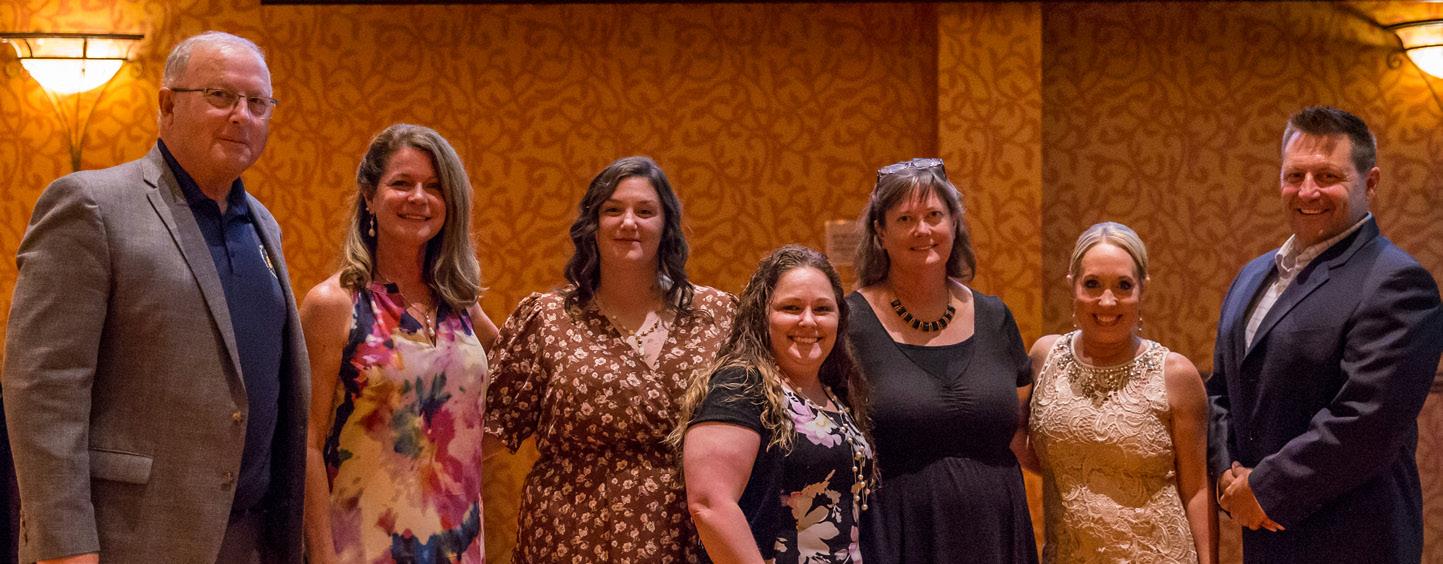
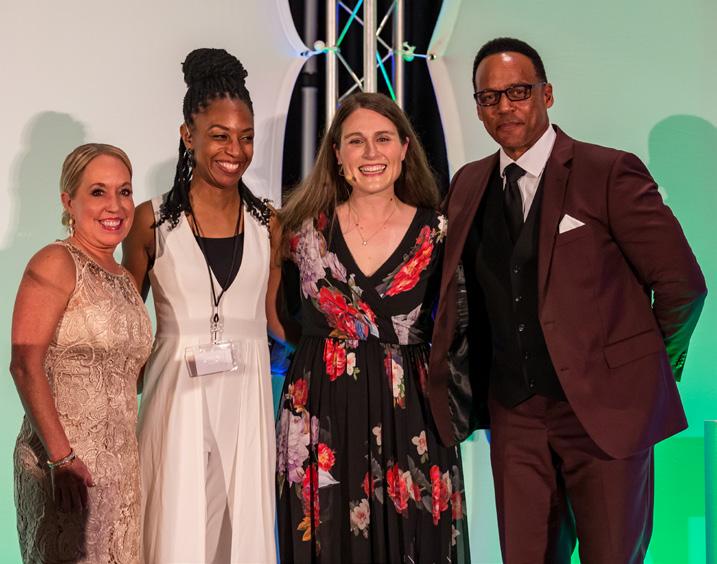
Name of Organization: Rejuvenating Women
Event Name: 8th Annual Restored Wings Gala When: September 8, 2022 Where: Embassy Suites La Vista Conference Center
Why: Annual fundraiser for survivors of human trafficking
Special Guests: Nebraska Governor Pete Ricketts, U.S. Rep. Don Bacon (Nebr.), Nebraska State Senator Bruce Bostelman, Nebraska State Senator Suzanne Geist, Nebraska State Senator Lou Ann Linehan, Douglas County Attorney Don Klein, Omaha City Councilwoman Aimee Melton, Omaha Police Officers Association President Anthony Conner
Attendance: 720

Amount Raised: $225,000
Event Summary: Fundraiser for child and adult survivors of human trafficking.
For more information: (531) 213-2663
Sponsors: City Ventures & Rocket Car Wash, Yahoo, Thrasher Inc, Lifegate Church, American National Bank, Liberty Property Management Company, Pinnacle Bank, Pizza Ranch, Paige and Brian Ritter, DC Retirement Strategies, First Interstate Bank, Lowe Legal Group, Sparrow Logistics, Vincentini Plumbing, Fred Hunzeker
Tail-Waggin’ Time
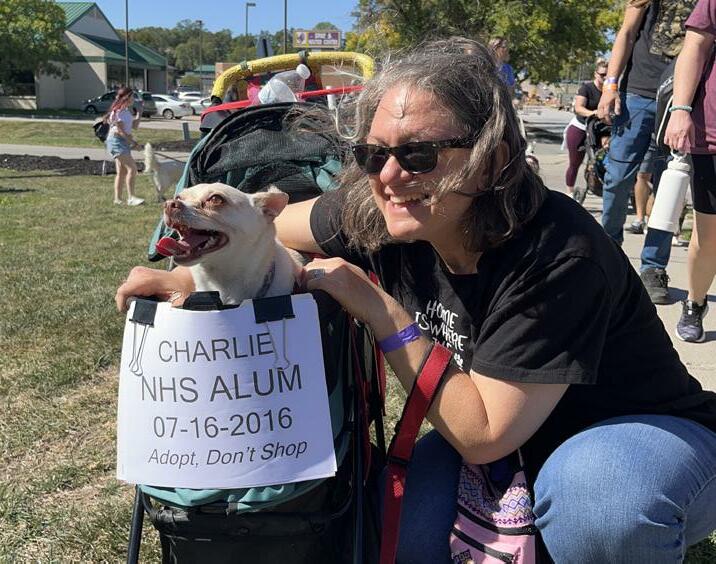
Nebraska Humane Society: Margre Durham Walk for the Animals

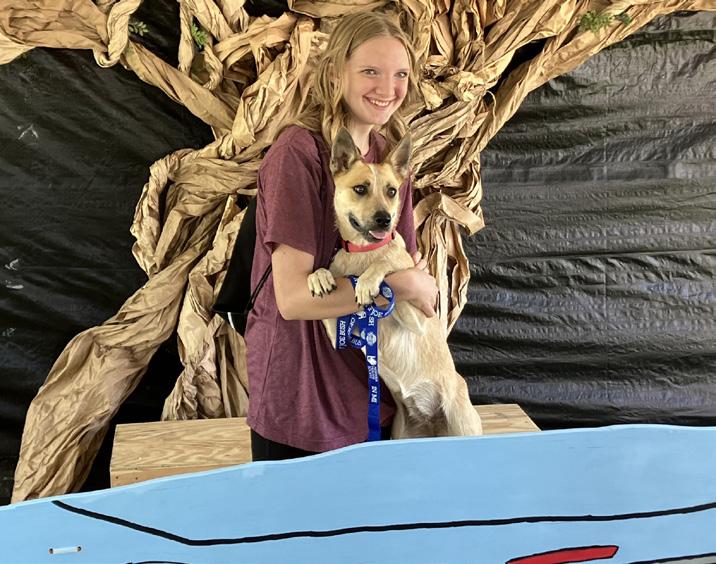
Name of Organization: Nebraska Humane Society
Event Name: Margre Durham Walk for the Animals
When: September 25, 2022
Where: Nebraska Humane Society Meadow

Why: To raise funding to rescue, rehabilitate and re-home animals
Attendance: 800
Amount Raised: $300,000
Event Summary: Gorgeous weather set the stage for the 2022 Margre Durham Walk for the Animals, which was a howling success. Sponsors were in full force with fun giveaways while kids enjoyed the Family Zone, and dogs loved the mile walk. This event is tail-er made for dogs and their people as it’s dog-friendly!
Rescue groups with pups, a silent auction, beer garden and grill made this a Sunday morning not to be missed.
For more information: www.nehumanesociety.org
Page 72 • NOV/DEC 2022
PHOTOS COURTESY OF NEBRASKA HUMANE SOCIETY
NHS VOLUNTEER PAM NEUMAN SHOWCASES ADOPT ABLE DOG CANE DURING THE ADOPTION DOG PARADE.
A PROUD MOM AT WALK FOR THE ANIMALS WITH HER NHS ALUMNI CHARLIE
PARTICIPANT MISTY BINAU AND HER BEST BUDDY HAD A BLAST AT THE MARGRE DURHAM WALK FOR THE ANIMALS
PHOTOS BY
GENTLE DOCTOR ANIMAL HOSPITAL’S HARRY POTTER BOOTH WAS A HIT FOR WALK PARTICIPANTS
CORY KLABUNDE PHOTOGRAPHY, ROGER HUMPHRIES PHOTOGRAPHY, HOWARD MARCUS PHOTOGRAPHY
DON BACON, BEN UNGERMAN, SUE PEFFER AND WALT PEFFER
JULIE SHRADER, TAKIELA BYNUM, JESSA DILLOWCRISP AND RANDY GOODWIN
DON KLEIN, SUZANNE GEIST, 3 BRAVE MOMS, JULIE SHRADER AND AARON HANSON
Every child, everywhere,deserves the very best It's why Children's Hospital & Medical Center combines the largest group of pediatric specialties inthe region, the most advancedtechnology and the biggesthearts all in one place. Together, in this safe and welcoming environment of excellence, we're shaping the future of pediatric medicine to deliverthe very best for kids. Visit ChildrensOmaha.org or call1.800.833.3100tofind a physiciannearyou.

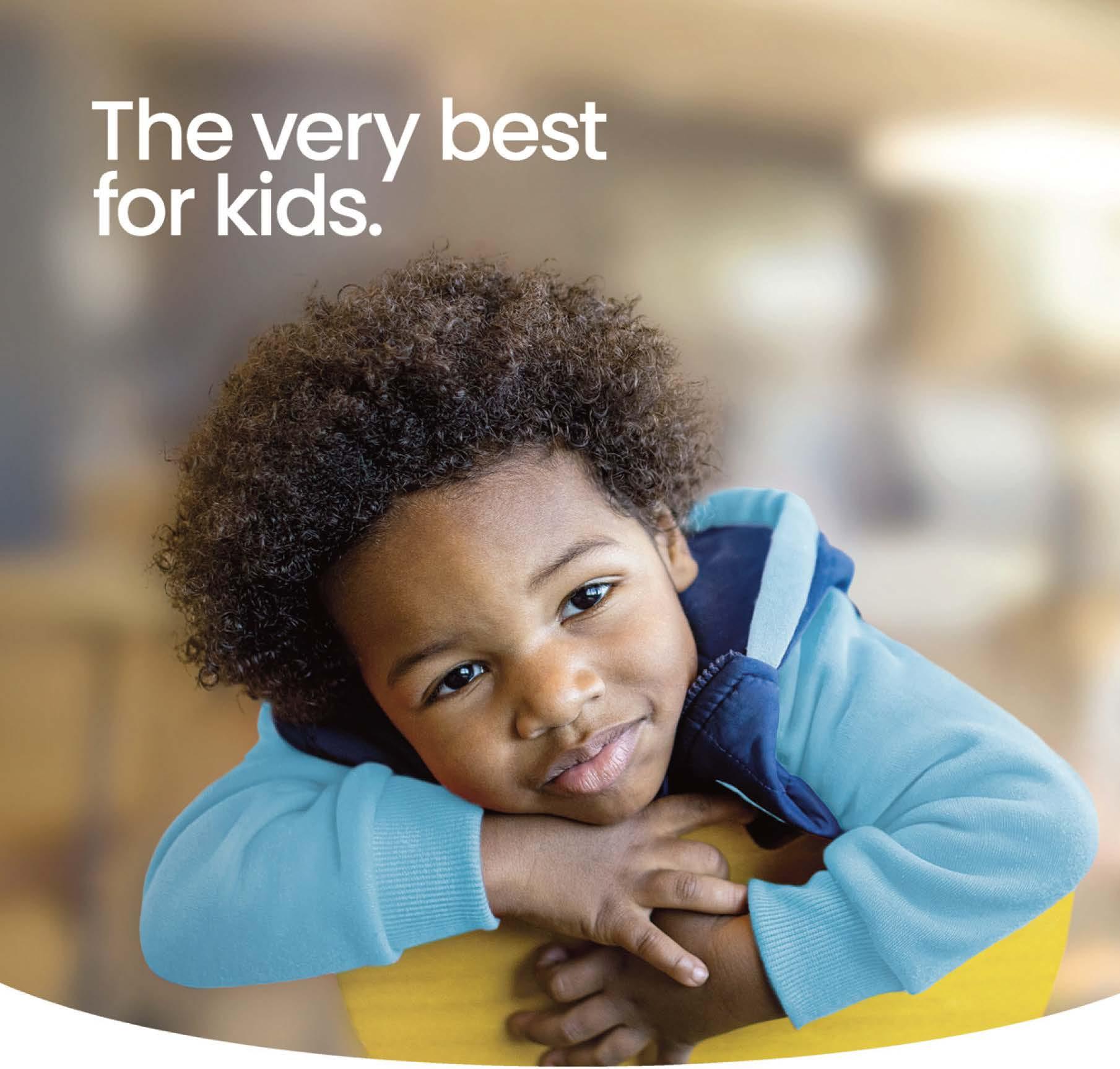
:@Children's HOSPITAL
CENTER CARE I ADVOCACY I RESEARCH I EDUCATION
& MEDICAL
P.O. Box 241611
Omaha, NE 68124
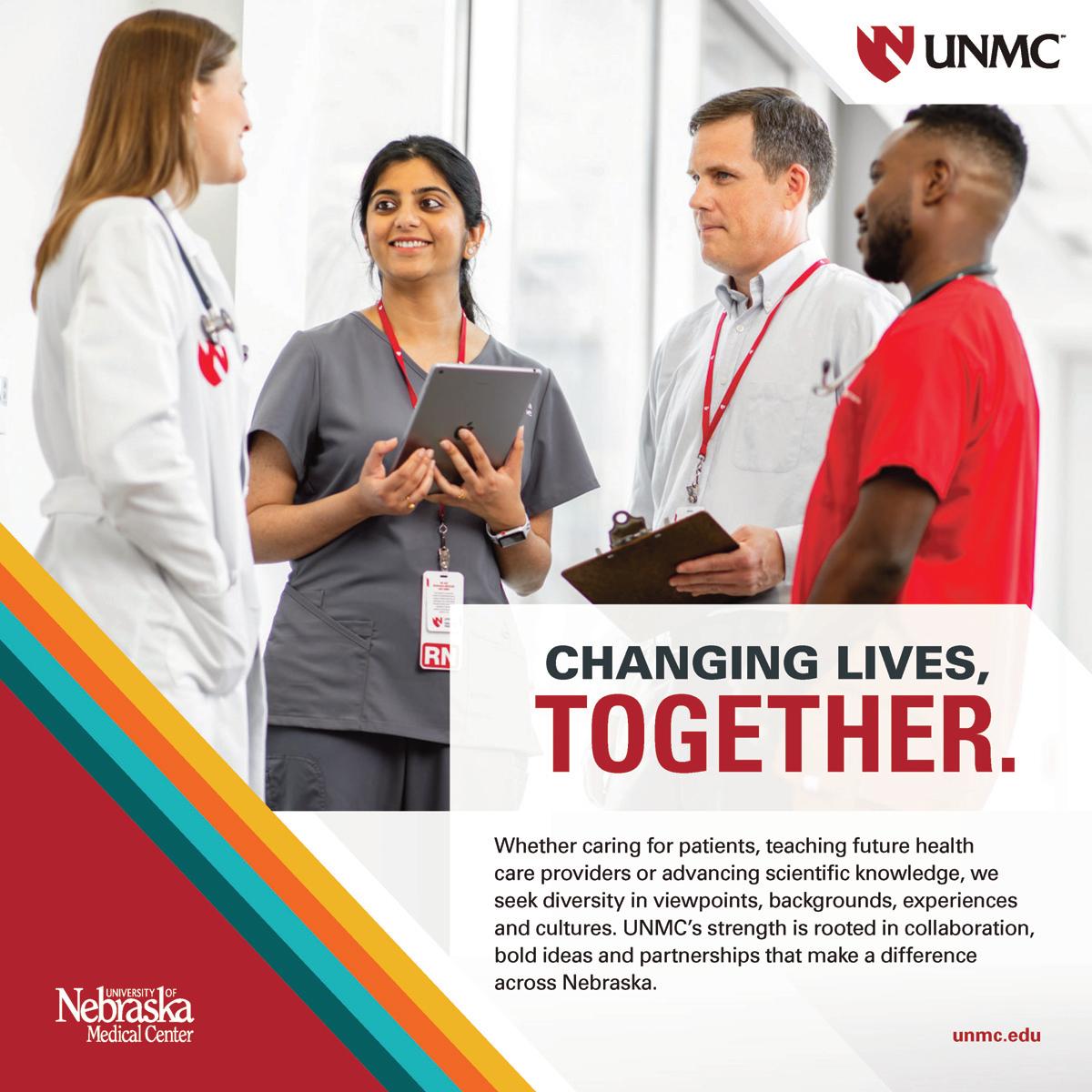
PRESORTED STANDARD U.S. POSTAGE PAID OMAHA, NE PERMIT NO. 2013































































































































































































































